By LEOR GALIL 36

FREE AND FREAKY SINCE 1971 | MAY 26, 2022
Friko Lifeguard Post Office Winter
and the dream of a teen rock scene
CITY LIFE
04 Street View Two young local designers steal the fashion scene while sporting bright headgear.
05 Inkling Your heart is an empty storage unit.
FOOD & DRINK
06 Sula | Book Review Hugh Amano develops Bon Vivant at Sterling Bay.
COMMENTARY
08 Joravsky | Politics Centrists’ attempts to say the le is as bad as the right are part of the gaslighting of America.
10 Isaacs | Culture What do elephants, Amber Heard, Johnny Depp, and Eugene Debs have in common?
12 On Prisons Maintaining mental health in prison was already challenging before COVID-19 hit.
14 Public Safety Chicago doesn’t need more curfews and criminalization.
NEWS & POLITICS
16 Garcia | Elections A look at Cook County’s property tax appeals board
18 Garcia | En español Una mirada dentro de la junta de apelaciones de impuestos sobre la propiedad del condado de Cook
20 The TRiiBE Cabrini-Green’s displaced residents aren’t being included in Chicago’s casino.
ARTS & CULTURE
22 Exhibitions Finnish artist Kristoffer Ala-Ketola recasts an ancient Greek monster.
highlights the love lives of older women, and Two Trains Running gets a revival at Court.
FILM
33 Movies of Note The Bob’s Burgers Movie is a perfect mediumrare without flaming out into a dry well-done, Chicken does little to challenge carceral systems, and Hit the Road is a digressive and slyly weighty debut by Panah Panahi. 34 Interview Director John Sayles on working with Haskell Wexler
24 Public Art Derric Clemmons and his team engage with community in South Chicago.
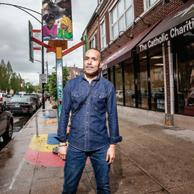
25 Skateboarding An event at University of Chicago’s Gray Center to theorize about gleaming the cube
THEATER
26 Reviews About Face’s The Magnolia Ballet offers a rich and enchanting feast; his immigrant mom’s story (and The Wizard of Oz) inspires Brian Quijada’s musical.
32 Plays of Note Richard III comes alive in all his malevolence with Promethean, Seven Days at Sea
STAFF CHANGES AT THE READER
Karen Hawkins, co-publisher and editor in chief of the Chicago Reader , is leaving the organization to become story editor with The 19th*, an independent, national nonprofit newsroom reporting on the intersection of gender, politics, and policy.

Hawkins started at the Reader in October 2018, when she joined incoming publisher Tracy Baim to help turn around the struggling, legendary alternative newspaper. The two had worked together more than 20 years prior at Windy City Times . After starting as the Reader ’s first-ever digital managing editor, she moved up to co-editor in chief in 2019 and then added the title of co-publisher in 2020. Hawkins’s last day with the Reader will be June 10. Reader culture editor Salem Collo-Julin will be promoted to managing editor,
MUSIC & NIGHTLIFE
36 Galil | Feature Horsegirl’s new Matador album has made them the most visible members of a thriving musical and artistic community that’s still too young for most clubs.

42 Chicagoans of Note Paul Natkin, concert photographer 46 The Secret History of Chicago Music The Devil Bell Hippies: Chicago’s greatest avant-
and other editorial changes will be announced soon.
Hawkins is also founder of Rebellious Magazine for Women and the Feminist Media Foundation. She co-hosts the podcasts Of Course I’m Not OK and Feminist Erotica . She also serves as a national board member for NLGJA: The Association of LGBTQ+ Journalists.
Salem Collo-Julin (she/they) has been on the editorial sta of the Reader since 2019. As culture editor, her areas of focus include the City Life section, visual arts and architecture coverage, and the literary arts. From 19992014, Salem was a member of the midwestern art group Temporary Services, and co-edited the book P risoners’ Inventions (Whitewalls, 2003). She also cofounded Temporary Services’ publishing imprint, Half Letter Press. Her writing has been found in Windy City Times, the Journal of Aesthetics and Protest,

CHICAGO READER | MAY 26, 2022 | VOLUME 51, NUMBER 17
garde band that only kind of exists
48 Shows and Records of Note Previews of concerts by Dehd, Pelt, Makaya McCraven, Paranoid London, and more, plus reviews of releases by Namir Blade and Wilco 51 Early Warnings Rescheduled concerts and other updated listings 51 Gossip Wolf The Pride Bands Alliance celebrates 40 years with a symphonic-band blowout that includes two world premieres, Experimental Sound Studio relaunches its Option series with a new third curator and a show by Evicshen, and three-fourths of C.H.E.W. re-form in the hardcore four-piece Stress Positions.
OPINION
52 Savage Love Dan Savage offers advice to his Instagram followers, because his laptop died.
CLASSIFIEDS
53 Jobs 53 Apartments & Spaces 53 Matches
COVER PHOTO CREDITS: HORSEGIRL BY CHERYL DUNN, FRIKO BY NANDO ESPINOSA HERRERA, POST OFFICE WINTER COURTESY THE ARTIST, AND LIFEGUARD BY CARLOS LOWENSTEIN
COVER PHOTO ILLUSTRATION: KIRK WILLIAMSON
Lumpen, AREA Chicago , the book Organize Your Own (ed. Anthony Romero, Soberscove Press, 2016), and other publications.
TO CONTACT ANY READER EMPLOYEE, E-MAIL: (FIRST INITIAL)(LAST NAME) @CHICAGOREADER.COM
PUBLISHER AND PRESIDENT TRACY BAIM PUBLISHER AND EDITOR IN CHIEF KAREN HAWKINS
PRODUCTION MANAGER KIRK WILLIAMSON
SENIOR GRAPHIC DESIGNER AMBER HUFF STORY EDITOR SUJAY KUMAR
CULTURE EDITOR SALEM COLLO-JULIN NEWS EDITOR JIM DALEY
THEATER AND DANCE EDITOR KERRY REID
MUSIC EDITOR PHILIP MONTORO
ASSOCIATE EDITORS JAMIE LUDWIG, TARYN ALLEN SENIOR WRITERS LEOR GALIL, DEANNA ISAACS, BEN JORAVSKY, MIKE SULA
STAFF WRITERS KATIE PROUT, KELLY GARCIA
AUDIENCE ENGAGEMENT MANAGER
YASMIN ZACARIA MIKHAIEL
EDITORIAL ASSOCIATE JANAYA GREENE
LISTINGS COORDINATOR MICCO CAPORALE
VICE PRESIDENT OF OPERATIONS ANN SCHOLHAMER
DIRECTOR OF DIGITAL JOHN DUNLEVY
DIRECTOR OF DEVELOPMENT JT NEWMAN DEVELOPMENT ASSOCIATE DJEMANESH ANETENEH
DIRECTOR OF MARKETING VIVIAN GONZALEZ
SPECIAL PROJECTS ASSOCIATE SHAWNEE DAY MEDIA PARTNERSHIPS COORDINATOR YAZMIN DOMINGUEZ CIMA MANAGER SAVANNAH HUGUELEY EXECUTIVE ASSISTANT SANDRA L. KLEIN
ADVERTISING 312-392-2970, ADS@CHICAGOREADER.COM CLASSIFIEDS: CLASSIFIED-ADS@CHICAGOREADER.COM
VP OF SALES AND BUSINESS DEVELOPMENT AMBER NETTLES
VICE PRESIDENT OF SALES AMY MATHENY SALES TEAM VANESSA FLEMING, LENI MANAA-HOPPENWORTH, TIM OGDEN, TED PIEKARZ, WILL ROGERS, LISA SOLOMON DIGITAL SALES ASSOCIATE AYANA ROLLING
NATIONAL ADVERTISING VOICE MEDIA GROUP 1-888-278-9866 VMGADVERTISING.COM JOE LARKIN AND SUE BELAIR
DISTRIBUTION CONCERNS distributionissues@chicagoreader.com 312-392-2970
READER (ISSN 1096-6919) IS PUBLISHED BIWEEKLY BY CHICAGO READER L3C 2930 S. MICHIGAN, SUITE 102 CHICAGO, IL 60616 312-392-2934, CHICAGOREADER.COM
COPYRIGHT © 2022 CHICAGO READER PERIODICAL POSTAGE PAID AT CHICAGO, IL
ALL RIGHTS RESERVED. CHICAGO READER, READER, AND REVERSED R: REGISTERED TRADEMARKS ®
Correction: An article published in the April 28 issue of the Reader , "Here's what Black voters should pay attention to in the midterms," misstated the number of homicides in Chicago in 2021 as “more than 1,000.” That number was for all of Cook County; there were 797 homicides in Chicago.
2 CHICAGO READER - MAY 26, 2022 ll
THIS WEEK
IN THIS ISSUE
Karen Hawkins Salem Collo-Julin

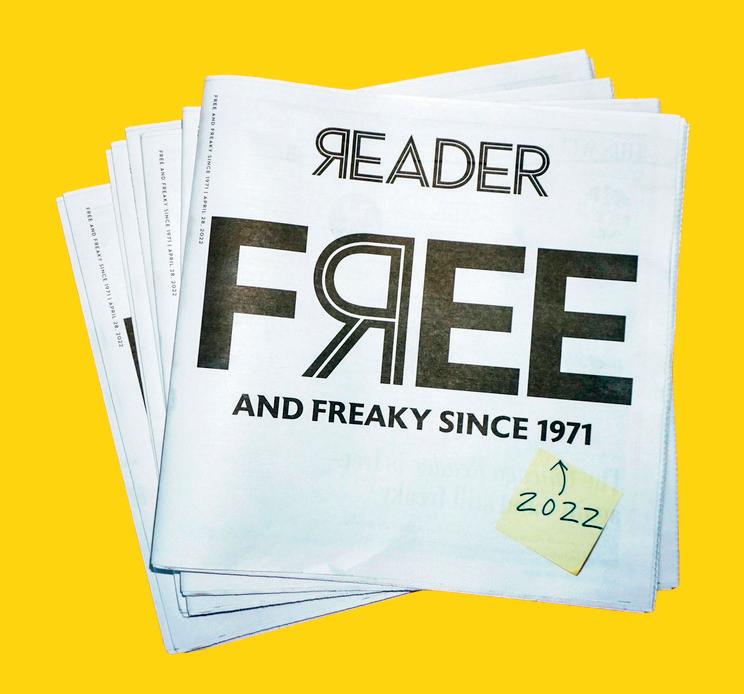

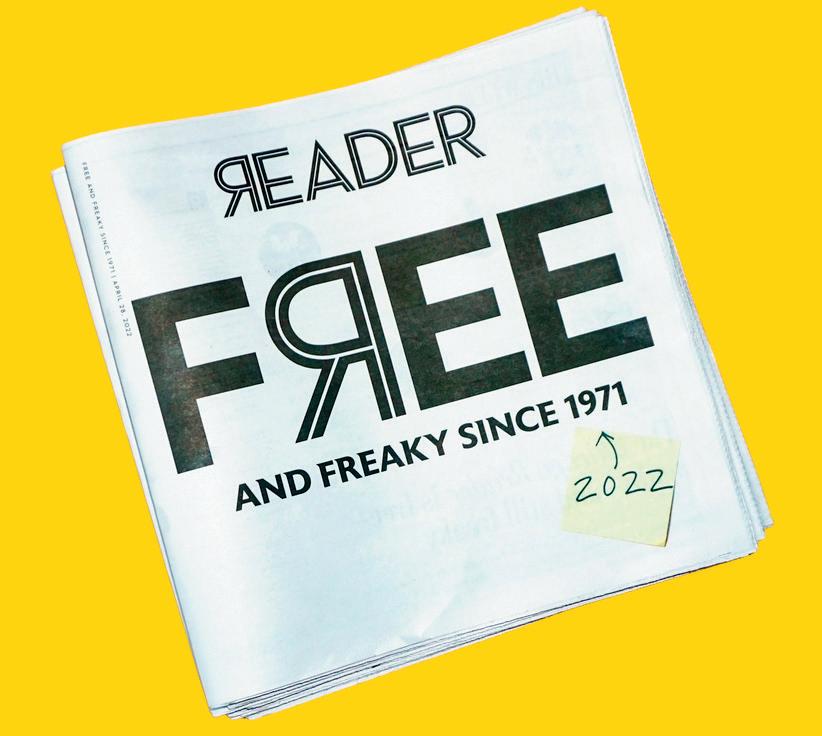




MAY 26, 2022 - CHICAGO READER 3 TheReaderisfinallyfree.Wearenow abletofullybecomeanonprofit newsroom—whichmeanstheReaderwill beownedbyYOU,ourreaders,andno oneelse.Willyoumakeadonationtoday tokickthingsoff,andbepartofthis historicmoment?
Street view
Hats off to the hats
Two young local designers steal the fashion scene while sporting bright headgear.
 By ISA GIALLORENZO
By ISA GIALLORENZO
At the end of April, The Curio and the Chicago Fashion Coalition joined forces to promote a networking event for the local fashion crowd at Chop Shop in Wicker Park. The turnout was truly impressive; so many recognizable names in the fashion scene were there: accessory designer and SAIC faculty member Gillion Carrara; luxury boutique owner Robin Richman; the Chicago Fashion Incubator executive director Anna Hovet Dias; entrepreneur Amanda Harth; and on and on and on. The party room was packed, the music was blasting, and the spirits were high. There was an obvious post-COVID excitement in the air, filled with hope, plans, and plenty of number exchanges.
The main orchestrator of the gathering was New York transplant Ian Gerard, the co-founder and principal of The Curio. According to Gerard, the goal of his recently launched enterprise is to “bring people together around their passions for fashion, art, film, food, and music.” “We are starting by showcasing the best Chicago fashion talent for both Chicagoans and for a national consumer audience, as well as elevating the Chicago fashion community in the eyes of the city and nation. We are working in collaboration with most existing Chicago fashion organizations, and hopefully soon [local o cials themselves], to successfully achieve this,” explains Gerard, who intends to throw a large-scale fashion show this fall.
With so many guests dressed to impress, two young fashion designers stood out thanks to their dashing style topped off by colorful wide-brimmed hats: Estefania Galvan, 28, and Christopher Reavley, 27. Galvan is a petite powerhouse hailing from Colombia, whose brand MŌS she accurately describes as “elegant but never boring.” Her clothes have a classic and tailored feel, but always with a fun extra detail—such as the printed lining of her jacket, or her versatile trousers with an optional fastening at the hem. Reavley is a precocious talent who started sewing in his midteens, when he was given a sewing machine by one of his father’s employees. “I flew o from there, self-taught,” he says. Six years ago he
started his own line—CR Collection—and now designs for a glitzy clientele from Chicago and New York.
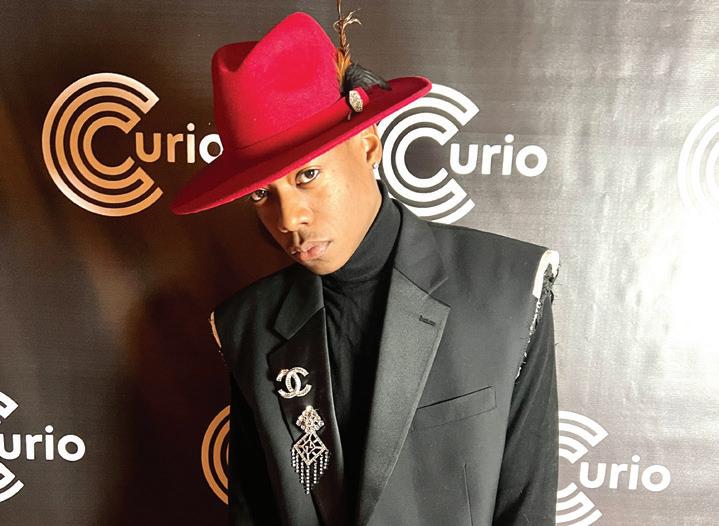
Both designers will be showcasing their collections next month. Galvan will be celebrating the first anniversary of her brand with Garden of the Elements, which she calls “a multi-sensorial immersive fashion show.” The event, scheduled for June 25, will feature not only her creations, but also mixed media arts,
live music and performances, augmented reality, and more. As for Reavley, his annual fashion show (this year titled “The Art of Wealth”) is scheduled for June and will feature 30 pieces in which, according to him, “classy meets edgy.” Reavley’s customized tuxedo jacket, with ripped sleeves and a rhinestone Chanel brooch on the lapel, says it all. v
4 CHICAGO READER - MAY 26, 2022 ll
CITY LIFE
MORE INFORMATION
FOR
The Curio: curioexperience.com; Chicago Fashion Coalition: chicagofashioncoalition.org; MŌS: themosbrand.com; Christopher Reavley: christopherreavley.com
Top: Estefania Galvan of MŌS; bottom: Christopher Reavley of CR Collection ISA GIALLORENZO
@chicagolooks
By MEGAN KIRBY
MEGAN KIRBY
There’s a mannequin staring down from the second-floor window of the Lock Up Self Storage on Lincoln. She has a blonde wig and a stoic demeanor—the sort of world-weariness that comes from being frozen in one spot against your will. When I moved the bulk of my earthly possessions into an eight-by-ten-foot storage unit in early 2020, I was comforted by her unblinking attention. She would protect my stu while I could not.
I was in between apartments and floundering in the early days of the pandemic. My boxes were supposed to live in the unit for six months, tops. The truth is that it is scientifically impossible to only use a storage unit for half a year; 18 months later, I had already retrieved the clothes, books, and kitchen gadgets I needed to use in my daily life. Most of my boxes remained in temperature-regulated solitude, sapping $135 out of my bank account each month.
If I wanted to end my lease before my twoyear anniversary, I had to get serious about the task. I needed to get rid of the storage unit—and to do that, I needed to get rid of a lot of stu . So fi rst I needed to convince my









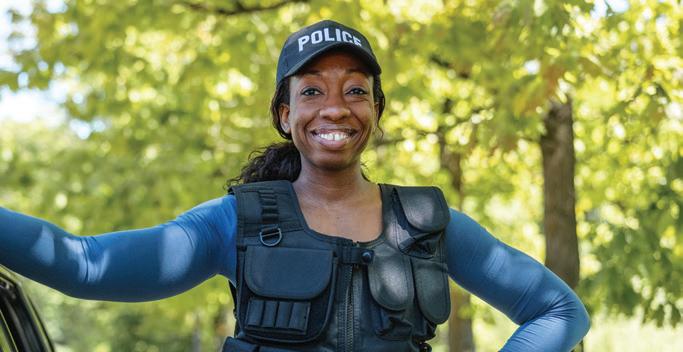
friends with cars that helping me move boxes would be totally chill and fun.
Why are humans such magpies, clinging to objects for their sentimental sparkle? A lot of my boxes were full of childhood artifacts like old report cards, drawings of first-gen Pokémon, and Breyer model horses. Other boxes were even more emotionally troubling, like the ones filled with my dead mother’s things, shoved to the back of my closet for years. My dad sold my childhood home almost a decade ago, so I lost access to a possibility of roomy suburban storage. I started seething with jealousy for people who still had access to their childhood bedrooms, sitting empty like a shrine to their former selves. I had to carry it all with me, and fit it where I could.
The truth is, even considering getting rid of those boxes felt like a betrayal. But who was I actually betraying? I didn’t want my life to become a museum to my past, like a career retrospective when I’m just getting started. I wanted more space to evolve, expand, and surprise myself.
The vibes at the storage unit were always strange. Very soft pop music was piped into
the building’s common speakers. It often sounded like Kelly Clarkson was humming from two rooms away. In the long, fluorescent-lit hallways, the e ect was haunting. I rarely saw other people, but when I did, they seemed just as addled as me. Masks on their faces, boxes in their arms, just trying to fi nd the carport before their strength gives out and they perish in Storage Wing B-200.
I saw one man multiple times, sitting in a folding chair in front of an open unit containing more Funko Pops than you could ever imagine. I don’t trust a Funko Pop’s soulless eyes, and so, by extension, I didn’t trust this man. Surely, he must have been involved in some seedy underground market, trading limited-edition Doctor Strange fi gures on the dark web.
One evening, my sister pulled into the carport next to an empty SUV. Next to the passenger door, a gigantic teddy bear (easily the size of an eight-year-old child) slumped on a dolly. I related instantly to his dejected position and unceasing grin: my spiritual twin. But where was his family? We took several trips to and from my unit and never saw another person. Did the bear drive the SUV?


I brought bags of clothes to Brown Elephant and stacks of paperbacks to Uncharted Books. I recycled old college reports and consolidated boxes of yearbooks. Some boxes were full of actual trash: half-empty Advil bottles, mismatched socks, promotional tote bags, and busted lighters. What possessed me to keep these things in the fi rst place, let alone pay more than a thousand dollars a year to keep them boxed up?
The thing about going box by box is that eventually you do reach the end. When I lugged the fi nal Rubbermaid tub back to my apartment, I thought I would feel relieved. Instead, I felt a strange aimlessness. The storage unit had been a lingering anxiety in my life for years, a literal representation of my mismanaged nostalgia. I needed to let go of some shit, sure. But I think I mostly wanted to let go of the idea that my memories needed to be tied to physical objects in order to survive.
Of course, there are still boxes tucked into the corners of my closet. I have some co ee mugs I hope I can use in a bigger kitchen someday. Some novels I’m going to read, I swear. I had to keep the Breyer model horses. I’m not ready to sort through my mom’s old college papers and magazine writing—and even when I do, I bet I’ll keep all of it. The point of emptying the storage unit wasn’t to get rid of all my things. It was to stop feeling flattened by them.
Turns out that officially ending the lease on your storage unit is actually pretty anticlimactic. I emailed the o ce. I dropped the key in the front door slot. And I saluted the mannequin who’d been standing at the window, watching me come and go for the last two years of my life. She didn’t wave back, but I think she was sorry to see me go. v
MAY 26, 2022 - CHICAGO READER 5 CITY
LIFE
Your heart is an empty storage unit Megan finds release while ending her lease.
INKLING
PLAY WITH PURPOSE™ Learn how every play helps at www.IllinoisLottery.com
@megankirb
BOOK REVIEW
Hugh Amano develops Bon Vivant at Sterling Bay
By MIKE SULA
Nobody gets rich writing cookbooks, but I’ve always assumed that Hugh Amano wrote his way o the dole.
Amano is best known as the opening sous chef at Fat Rice who, after leaving the restaurant in its first year, cowrote the acclaimed The Adventures of Fat Rice, followed by two outstanding comic cookbook collaborations with artist Sarah Becan: Let’s Make Ramen! and Let’s Make Dumplings! I’ve covered each of these books in their time, but I first wrote about Amano long ago during the Great Recession when he launched Food on the Dole, an achingly personal blog about life as an unemployed chef (with an English degree) whose survival schemes predated the pandemic pivots I’ve reported on in recent times.
I know better, but I still cheered up at the fantasy that it was possible for mass-market
publishing to lift an overworked chef o the line. Turns out, the only way Amano could’ve written any of those books was because of the nine-to-five gig he took on in 2013 making lunch for a couple dozen employees of a low-profile commercial real estate firm.


“If you’re a chef your identity is always with your restaurant,” he says. “It’s programmed into you like, ‘Where do you work? Who do you know?’ It’s ride or die, and you devote your life to this pirate ship. For me it just got to be, ‘Fuck it. I don’t give a shit about that. I just wanna cook.’”
Amano’s new, relatively predictable, and shortened workday allowed him to research, travel, and write, even as his place of work grew into the often reviled development juggernaut known as Sterling Bay. “It’s just been sort of this frog in boiling water,” says Amano,
who now makes a family-style lunch for 100 each weekday in the company’s Fulton Market HQ, in a kitchen of his own design. “In nine years it’s just been me in the kitchen, and I rely on my own curiosity. That’s a great place to be for me. I’ve learned more here than anywhere else.”
He found fulfillment in introducing his captive, largely midwestern coworkers to foods they might not seek out on their own (Haitian pork griot with pikliz, Filipino adobo). “I do try to push them—and myself.”
“I send out a menu every week so they know what’s coming down the pipe, and serve lunch at noon on the dot. It’s like ringing a dinner bell. I send an email out and it’s like this stampede of wildebeests coming down.”
Amano stayed on the payroll even when the o ce closed in the spring of 2020. “I just
KEVIN HARTMANN
thought, ‘They’re taking care of me. I need to contribute somehow.’” He started by sending out a daily recipe over company email (homemade granola, Crying Tiger, harissa). “‘Food is starting to suck because no one knows how to cook, so every day I’m gonna send you one new recipe.’ It was really received well and it was just a nice thing to look forward to, a little bit of light in an uncertain time.”
That summer Amano compiled most of them into a 238-page cookbook, Building Flavor, photographed and designed in-house, and distributed as a year-end gift for sta and associates. “It’s basic things, and then there are some more aggressive things I’ve made that people might not know of or care to explore unless it’s free and right in front of them.” (Like smoked tofu in red curry and beef kalbi.)
After Let’s Make Dumplings! published last
6 CHICAGO READER - MAY 26, 2022 ll FOOD & DRINK
Chef Hugh Amano says the spirit of Bon Vivant is understanding other cultures through food.
From the company kitchen and beyond, the cookbook author and chef’s inside job yields a new culinary travel journal.
BON VIVANT: A CULINARY JOURNAL bonvivantjrnl.com

summer, Becan and Amano agreed to take a break from graphic cookbooks, but he still had lots of ideas he wanted to pursue. Building Flavor was so well received internally, and the process of bringing it to life was so free of the financial and creative pressures inherent in mainstream publishing, that he wondered if the company would underwrite more outward-looking food-writing projects. To that end he pitched the brass on the idea of a biannual culinary travel journal.
“I love the experiences I’ve had writing cookbooks for Ten Speed Press, but what if I can kind of be a free agent and do this kind of stu in the same way that I talk about how I’ve learned a lot here? There’s that same level of freedom to explore, without the pressure to sell stu . And what creative person wants that pressure versus just creating?”
Last October Sterling Bay published the first issue of Bon Vivant: A Culinary Journal, focused on Amano’s obsession with wood-fire cooking. At 102 pages, lavishly documented by house photographer Kevin Hartmann and laid out by graphic designer Alexis Teichman, it’s a technique-heavy collection of recipes
that features a piece on John Manion’s El Che Bar, as well as travel stories about hunting and cooking along the Provo River in Utah (johnnycakes, ember-braised pork guiso), and a visit with an old culinary school pal in Montana (elk and venison sausages, willow-skewered trout). There’s also a piece on cooking paella on the banks of the Chicago River along a flattened stretch of Sterling Bay’s Lincoln Yards development.
Issue two comes out Memorial Day and explores the food of the two Mexican states on the Baja Peninsula, with a focus on what and where to eat in Tijuana, Ensenada, Valle de Guadalupe, and Todos Santos. The 16 recipes (birria de res, fish tacos, ceviche, aguachile) also include a deep dive into tortilla making with Aaron Harris of Molino Tortilleria and Jonathan Zaragoza.
Until now Amano had been low-key about his day job, but unlike Building Flavor , Bon Vivant is available for anyone to buy online. He wants to get it into neighborhood stores on consignment too, “but that’s kind of a challenge ’cause it’s like, ‘I’m here from Sterling Bay and I want to sell this in your tiny shop.’”
What’s in it for the company? “Hugh’s contribution to the company goes well beyond his food,” according to CEO Andy Gloor, via text. “He’s always been a big part of Sterling Bay’s culture, expanding our perspective through a culinary lens, so when he pitched Bon Vivant to us it made perfect sense in a lot of ways, including as a great gift for employees and friends of the firm—many of whom Hugh has fed for the better part of the past decade.”
Amano wants Bon Vivant to be self-sustaining, if only to keep his patron on board for more. In future issues he wants to focus on the food of Toronto or Miami, regional barbecue, and a world survey of noodle-making, to name a few. “It’s just the spirit of giving a shit about things,” he says. “Doing things with your hands and doing things from the gut—and the thing that is super near and dear to me, which is understanding other cultures via food, which is the best way to do it.”
And it’s a way to keep learning on the company dime. “Anytime you write a book it’s like taking a college course.” v


MAY 26, 2022 - CHICAGO READER 7
& DRINK
FOOD
Bon Vivant will be published twice a year. KEVIN HARTMANN; DESIGN BY ALEXIS TEICHMAN
@MikeSula
PAID FOR BY THE CHICAGO FEDERATION OF LABOR
COMMENTARY
POLITICS
False equivalence
Centrists’ attempts to say the le is as bad as the right are part of the gaslighting of America.
By BEN JORAVSKY
So there I am at my kitchen table, drinking my morning co ee and reading the latest column in the New York Times by Tom Friedman, who I disagree with more often than not.
I read pretty much every column by Friedman, Bret Stephens, David Brooks, and other writers with whom I disagree, on the outside chance that they might write something so enlightening that I proclaim, Eureka! I see the light.
It hasn’t happened yet—though I suppose that doesn’t mean it never will.
Anyway, this column is about Friedman’s recent lunch at the White House with President Biden. Their conversation was “off the record,” but the menu was not.
So he reveals what he ate: “a tuna salad sandwich with tomato on whole wheat bread, with a bowl of mixed fruit and a chocolate milkshake for dessert that was so good it should have been against the law.”
But he conceals what Biden said. In short, the relevant stuff remains privileged information.
Sort of like a mayoral response to a FOIA
request.
The column’s point is that Friedman is distressed by divisions in our country. Which, OK, so far so good.

But as soon as he starts enumerating examples of these divisions and explaining how a centrist like himself has no home in either party, I know what’s coming . . .
The dreaded false equivalency. As in this nugget . . .
“With every passing day, every mass shooting, every racist dog whistle, every defund-the-police initiative, every nation-sundering Supreme Court ruling, every speaker run o a campus, every bogus claim of election fraud, I wonder if he [Biden] can bring us back together.”
Centrists, please—think about what you’re saying.
You’re saying a mass shooting—in which a white man armed with a rifle gunned down random Black people at a grocery store in Buffalo—is the same as some douchebag right-winger getting cat calls at a college lecture hall.
You’re saying that “defund-the-police ini-
tiatives” are as dangerous as attempts to steal a presidential election, as Trump tried in 2020 and Republican legislators throughout the country are clearly trying to do in 2024?
You don’t really believe that—do you?
As for a “defund-the-police initiative,” it’s not an actual thing. It’s a figment of MAGA’s imagination, a tool MAGA uses to frighten centrists, like Friedman, into sullying the base of the Democratic Party so they can tell swing voters: a pox on both their houses.
Defund the police was a cry that erupted in the aftermath of George Floyd’s murder. Then came the protests and the unrest of the summer of 2020, followed by the inevitable backlash. And pretty much every Democrat sprinted away from the defund concept.
In fact, Democrats seem to outdo Republicans in their attempt to rail about defunding the police. Just look at the recent evidence here in Chicago.
For a relatively brief moment, Arne Duncan, former secretary of education, hinted he might run for mayor on a platform of shifting funds from policing so more money could go to intervention or mental health response teams. Mayor Lightfoot immediately pounced, blasting Duncan as a police defunder.
“People all over the city, neighborhood after neighborhood—they don’t want to defund our police department. They want our police department to be respectful and constitutional in the work that they do; but they want the police to protect them,” Lightfoot said in regards to Duncan.
Duncan decided not to run. And I’ve not heard one word about defunding the police from any citywide candidate ever since.
You know, it’s sad that the main Democratic takeaway from George Floyd’s murder seems to be stay away from “defund the police.”
Let me pause to point out the obvious. There is no moral equivalence between Democrats and Republicans at this point in time.
Even if you think that “defund the police” is an outrage, the number of elected o cials in the Democratic Party who actually call for it are a tiny fraction of the party as a whole.
Whereas over 50 percent of Republicans say they believe President Biden stole an
election that he actually won. And Republican legislators all over the country are feeding that paranoia by trying to pass election laws that would enable them to essentially turn the 2024 presidential election over to MAGA if they don’t like the outcome.
As the New York Times—Friedman’s newspaper—has reported.
In Illinois, not one Republican gubernatorial candidate has dared to refute Trump’s election lie. Not even Richard Irvin, the so-called moderate in the primary.
They’re all beholden to Trump in one way or another. Either they agree with him or they’re too frightened of a voter backlash to admit they don’t.
Meanwhile, back in Chicago, a city supposedly run by “radical leftists,” if you believe MAGA propaganda . . .
A City Council committee met last week to consider Mayor Lightfoot’s proposal to lower the curfew for minors.
Many alderpersons—even conservative ones—predicted a lowered curfew would not cut back on violence. They noted the city was barely enforcing curfew laws already on the books. They predicted new laws would be selectively enforced, with Black teenagers getting the brunt of arrests. And so on . . .
And yet it overwhelmingly passed. It hasn’t come before the full council yet. But I predict it will eventually be passed. Why? Because it’s like railing against defunding the police. No elected o cial wants to look soft on crime, even in so-called lefty Chicago.
So comparing fictitious police defunders to very real democracy deniers is a form of gaslighting. It’s not real and yet we’re led to believe it. All part of an e ort to win over swing voters by saying extremists on both sides are bad.
Even though one is clearly far worse than the other.
Funny thing is—this strategy won’t work. No matter how many times centrist Dems denounce “defund the police,” MAGA will accuse them of pushing for it.
And the gaslighting of America continues. v
8 CHICAGO READER - MAY 26, 2022 ll
In comparing the Democrats and Republicans, centrists like Tom Friedman get it all wrong. BROOKINGS INSTITUTION
@bennyjshow
HISTORY MUSEUM










MAY 26, 2022 - CHICAGO READER 9 JUNE 23, 2022 | 5:30–8:30 P.M. CHICAGO
Over the past four decades, many individuals and organizations have worked to support the fight to end HIV/AIDS, as well as provide resources and care for the estimated 38 million people living with HIV and 36.3 million individuals worldwide who have died from complications related to the virus. In honor of the city of Chicago designating 2022 as the “Year of Chicago Dance,” we invite you to reflect on the history of HIV/AIDS in Chicago, the dance community’s efforts to provide support to those impacted by the epidemic, and the future of HIV/AIDS advocacy in Chicago and beyond. The event includes a dance performance, panel discussion, and reception. PREMIUM ADMISSION | $35 includes signed copy of Plague Years: A Doctor’s Journey Through the AIDS Crisis by Dr. Ross A. Slotten GENERAL ADMISSION | $15 REDUCED ADMISSION | $5 Youth (18 & under) and Seniors (65+) LEARN MORE AND PURCHASE TICKETS AT CHICAGOHISTORY.ORG/OUT | #OUTATCHM This event is made possible thanks to the support of the Chicago History Museum, the OUT at CHM advisory committee, AIDS Foundation Chicago, Chicago Dancers United/Dance for Life, Howard Brown Health, Center on Halsted, Giordano Dance Chicago, and Chicago Dance History Project. DANCING FOR LIFE MOVING THROUGH HIV/AIDS
Flashpoints, free speech, and the law
By DEANNA ISAACS
Last week, amid the usual tsunami of grim news about inflation, mass shootings, pandemic, and war, came word that the New York Court of Appeals is considering whether the Bronx Zoo is violating the rights of Happy, an Asian elephant who’s lived there for more than four decades, by confining her to a portion of a one-acre exhibit.
The Nonhuman Rights Project, which is representing Happy, argues that she wants to make her own decisions about things like where to go and what to do, and that she is being illegally held. They’re seeking her re-
lease (to a sanctuary) through a habeas corpus proceeding. Habeas corpus is a procedure that allows “persons” to challenge detainment. The first thing the court will have to decide is whether Happy—all 5,800 pounds of her— qualifies as a person.
Meanwhile, in the sordid and conveniently livestreamed trainwreck of a defamation suit that Johnny Depp is waging against his ex-wife Amber Heard, her lawyers are arguing that the Washington Post op-ed she wrote about being a victim of domestic abuse is free speech, protected under the First Amendment.
The First Amendment, ratified 231 years ago as part of the original Bill of Rights, is responsible for some of our most dearly held freedoms. It’s also pretty concise. Here it is, in its entirety: “Congress shall make no law respecting an establishment of religion, or prohibiting the free exercise thereof; or abridging the freedom of speech, or of the press; or the right of the people peaceably to assemble and to petition the Government for a redress of grievances.”
An important point to remember about it is that it only applies to actions of the government—not those of private individuals or privately-owned businesses. This can be a little confusing. Like how then does it apply to the Depp/Heard severed-finger-bottlerape-poop-in-the-bed thing? As it happened, PEN America, the venerable national literary organization, was in town last week at the American Writers Museum, launching a yearlong touring series of discussions on this very topic: “Flashpoints: Free Speech in American History, Culture, and Society.”
The PEN panel was moderated by Northwestern University professor Brett Gadsden and included University of Chicago Law School professor and First Amendment expert Geo rey R. Stone, who got a lesson on speech limits from his own students in 2019 that ended with him vowing to never again illustrate the fighting words doctrine by telling a story that employed the N-word. (“This is not about censorship, or about anybody telling me what to do or not to do,” Stone told Inside Higher Ed then. “This is something on which students have enlightened me.”)

At the panel, Stone noted that the First Amendment was around for 150 years before it got any attention from the Supreme Court. And that only happened because President Woodrow Wilson, who’d won election by promising to stay out of World War I, did an about-face and entered the war, and then wanted to suppress opposition to it. Congress cooperated by passing the Espionage Act of 1917, which, Stone said, “made it a crime for any person to criticize the government, the war, the draft, or the military in a way that
would potentially undermine support for the war.”
It was a very broad broom.
Convictions under the Espionage Act brought the initial First Amendment cases to the Supreme Court, and the first few (including the conviction of Socialist Party leader and former presidential candidate Eugene Debs), were upheld unanimously. But, after a summer recess that allowed time to chew it over, two legendary members of the court, Oliver Wendell Holmes and Louis Brandeis, returned with changed positions. They had become convinced that freedom of speech is fundamental to American democracy and that people should have the ability to criticize the government unless “that criticism created a clear and present danger of grave harm to the nation,” Stone said.
From then on Holmes and Brandeis dissented on all Espionage Act convictions. It took until the 1960s for the rest of the court to follow them, but since then, Stone said, “the court has never upheld the conviction of any individual for engaging in speech on the theory that that speech might cause others to engage in illegal conduct.”
We’re at a turning point now, however, with the most conservative court we’ve seen in a century, Stone said. “Given the makeup of this court, and the length of time they’re likely to serve, we can expect revisions in the interpretation of women’s rights, individual rights, sexual freedom, and the definition of obscenity that will transform this nation to much more of what it was like in the 1950s than what it is like today.”
“One thing we can do is pass state laws that recognize these rights,” Stone said. But if, say, the court decided to extend constitutional rights to the unborn, even state laws could be limited protection. What they would do is buy time.
So what about Johnny Depp and Happy? In a post-panel followup Stone said he’s not familiar with these cases but, “defamation is, by definition, a free speech issue. That’s because the government makes the rules that determine whether someone can sue, and the First Amendment determines whether those rules are constitutional or not.” Happy, however, might be out of luck: “If they’re basically claiming that Happy has constitutional rights, that’s a nonstarter.”
“Animals do not have constitutional rights.” v
10 CHICAGO READER - MAY 26, 2022 ll
COMMENTARY
Brett Gadsden and Geoff rey R. Stone at the PEN panel at the American Writers Museum on May 18 DEANNA ISAACS
CULTURE
What do elephants, Amber Heard, Johnny Depp, and Eugene Debs have in common?
@DeannaIsaacs








11 NOW OPEN! Explore four floors of captivating new exhibitions in the uniquely intimate space wrightwood659.org Installation view of American Framing at Wrightwood 659, 2022, Alphawood Exhibitions, LLC, Chicago. Photo: Michael Tropea. Installation view of Rirkrit Tiravanija: (who’s afraid of red, at Wrightwood 659, 2022, Alphawood Exhibitions LLC, Chicago. Photo: Aleya Cydney Photography Kaen, Untitled Single Panel Painting, 80 x 40 in, Private Collection SUPPORT FOR THESE EXHIBITIONS IS PROVIDED BY ALPHAWOOD FOUNDATION CHICAGO American Framing is presented at Wrightwood 659 by Alphawood Exhibitions in cooperation with the University of Illinois at Chicago (UIC). Rirkrit Tiravanija: (who’s afraid of red, yellow, and green) is organized by the Hirshhorn Museum and Sculpture Garden, Smithsonian Institution, Washington, DC. AMERICAN FRAMING The U.S. Pavilion for the 17th International Architecture Exhibition of La Biennale di Venezia RIRKRIT TIRAVANIJA: (who’s afraid of red, yellow, and green ) INSPIRED. POWERFUL. TRANSPORTING. EVENT CALENDER MUSIC LISTINGS Chicago Community Calendar Comprehensive listings of concerts and music events from a wide variety of event organizers —including Reader readers.
ON PRISONS
A very dark place
Maintaining mental health in prison was already challenging before COVID-19 hit.
BY ANTHONY EHLERS
For many, mental health has only recently come into focus due to the COVID-19 pandemic. However, for those of us incarcerated by the Illinois Department of Corrections (IDOC), mental health has long been an issue and point of struggle. Serious mental illness has become so prevalent in the American corrections system that jails and prisons are commonly called “the new asylums.” According to the Bureau of Justice, there are more people with mental health issues in prisons across the country than all the nation’s state-run mental hospitals combined.
The pandemic has made it even harder to
maintain mental health in prison.
In 2016, the Treatment Advocacy Center put out a report in which they estimated that 15 percent of state prison populations su er from a mental illness. The devastation of the pandemic, with more than a million American deaths, the economic strife that is affecting everyone, lockdowns, the unprecedented curbs on social interaction, no visits, and fear of illness has taken a great toll in prisons. In January 2021, 41 percent of adults who responded to a survey administered by the National Center for Health Statistics and Census Bureau reported symptoms of anxiety or depression.

This marked increase is prevalent in prisons as well. Men in here are su ering.
COVID-19 has ravaged the Illinois Department of Corrections (IDOC) statewide both in terms of lives lost and mental health. I personally knew more than 20 men who died of COVID-19 in Stateville in 2020, and some of them were good friends, including my cellmate and best friend, James Scott. We all watched helplessly as they carried the bodies of our friends out of their cells. Some were close friends, others were family. Many guys, including myself, find it di cult to cope with the grief and isolation. Some guys in here self-harm, others have openly spoken of kill-
ing themselves, and yet others turn to drugs. I’ve seen it, I’ve had a cellmate kill himself. The guys who turn to drugs are attempting to relieve their anxiety and depression. One of my friends, Lamont Gri n, told me, “I’m exhausted all the time, yet falling asleep is hard. My mind focuses on every problem, question, and concern.” I’ve heard this exact same thing many times.
In Stateville—and IDOC facilities statewide—there are court-mandated doctors and other mental health professionals. If not for a court order stemming from a lawsuit, IDOC would not have any mental health care available to incarcerated people. The professionals that do work here are severely understaffed and overworked. They are hampered by IDOC’s policies and dictates. IDOC creates obstacles and interferes with their work.
“The biggest problem is the criminal justice system and the mental health system are not closely aligned,” Texas Tech University psychologist Robert Morgan told the mental health news site Verywell Mind last year. “We need to teach them about their mental illness and make sure they know once they leave, they need to reconnect with the mental health system.” IDOC currently does no such thing.
Mentally, I’m not OK. I struggle with bouts of depression and anxiety, the loneliness is sometimes unbearable. It’s crushing. I don’t sleep well, I have insomnia, and when I do manage to get some sleep, I have nightmares.
I’m not eating well, and sometimes my hands shake. I find myself struggling. Then I look around me and I see a lot of other guys going through some very similar things; some aren’t as bad, but others are worse. The pandemic has intensified mental health issues guys already had, and created new mental health issues in many of us.
12 CHICAGO READER - MAY 26, 2022 ll
COMMENTARY
Stateville Correctional Center WIKIMEDIA COMMONS
I was not on the mental health caseload before the pandemic; I was one of those men who struggled silently. However, after James, my cellmate, died, I was in a very dark place. No one came to check on me. I took the step, and put in several requests to see someone from mental health. It took almost six months to even see someone at all! Six months I waited. Had I wanted to hurt myself, I would have been dead.
This kind of wait is not the exception; it’s the rule. Such disconnects are commonplace in IDOC. I eventually ended up with a primary caregiver; she is caring, and it helps to see her. However, because of the lack of mental health professionals who work here, and the sheer number of people they have on their caseload, I only see her about once every six weeks. This is the best she can do, despite me voicing my need to see her more often on a regular basis. Once every six weeks seems to be about the best I can hope for. And it’s simply not enough. Even when you really want help, when you ask for help, it’s denied. For those of us who want our situation to change desperately, we simply have to do it on our own.
Every few weeks, a mental health professional makes rounds through the cellhouse. They stop at your cell door and ask if you need to see someone. They make it clear they are in a hurry to keep going. I stopped them once and told them I was having a di cult time. Things were hard at the moment, and I really needed help. They said, “We will put your name in,” and hurriedly left the door. They didn’t ask follow-up questions about whether I was OK, or what I needed help with. It took four weeks for me to even see someone. I never stopped them to ask for help again.
These “rounds” are mandated, and done to simply check a box; otherwise, they are pretty meaningless. I needed help at that time, and got none. This is the mental health situation at Stateville. It’s dangerously inadequate.
The criminal justice system is woefully ill-prepared to handle the needs of its mentally ill prisoners. The pandemic has only complicated matters. At an interpersonal level, some prisoners receive mental health services, while a vast majority are grossly underserved.
How can we change this? The hiring of more mental health professionals is a must; it is



essential to more evenly distribute caseloads, and focus on those asking for help, as well as implement new programs. Second, mental health issues need to be destigmatized, and therapeutic approaches such as cognitive behavioral therapy, teaching problem-solving skills and lifestyle changes, training programs such as “Thinking for a change,” and Reasoning and Rehabilitation should be o ered. Programs like these, as well as peer group counseling, and more frequent one-on-one talk therapy sessions, will all help those su ering from mental issues be better able to cope. Why is this important? These men are in prison; they committed crimes. While this is true, they are paying their debt to society, and more importantly, they are human beings. The men in this place have themselves been victims of many kinds of abuse. Many have PTSD. Yet because they have been found guilty of committing a crime, and are considered to be perpetrators, there is no room to also be a victim.
These men should matter because they are human beings, and society should care because many of these men are coming home.
These men will be thrust back into the community, having never received proper care or treatment for their mental issues. Leaving prison without guidance or referrals of any kind, or without medications, is a recipe for disaster.
Mental illness raises the risk of recidivism, as well as alcohol and drug abuse. These men need to be treated, and given the skills to cope with the issues that face them. Concentrating on violence and crime after the fact is a reaction, and it helps no one, especially the victims. Doesn’t it make sense to treat the men in prison before they get out, to meet these issues head on?
These issues need to be treated before they manifest into substance abuse and crime. Think of the crimes that could be prevented, simply by making sure prisoners receive competent, comprehensive mental health treatment. v
Anthony Ehlers is a writer incarcerated at Stateville Correctional Center who contributes a regular opinion column to the Reader.
This program will change lives.
MAY 26, 2022 - CHICAGO READER 13 COMMENTARY
MALCOLM X COLLEGE
If you have
Get started today! Paid for by a grant from IDHS. ccc.edu/crss Stipends available Employment opportunities available
lived experience in recovery for substance use and/or mental health challenges, consider becoming a Recovery Support Specialist—at no cost.
@chicago_reader
Chicago doesn’t need more curfews and criminalization
Instead, we need to address the root cause of violence: inequality.
By ASHA RANSBY-SPORN
There is a particular cruelty to political leaders placing the blame for structural problems that are well within their power to address on the victims.
When Mayor Lori Lightfoot describes how the city will enforce a youth curfew by saying, “We don’t want to arrest children. If we have to, because they’re breaking the law, we will,” all I hear is a threat of more violence and a finger pointed at young people who deserve so much more freedom than our unequal city a ords them.
Included in the list of goals 16-year-old Seandell Holliday wrote for himself in a mentorship program last year were pursuing his passion for music, taking care of his family, and
living to age 21. Seandell, whose fatal shooting at Millenium Park last weekend sparked the mayor’s announcement of a new curfew for young people, had some level of personal understanding of a landscape of violence that was pervasive enough to question whether he would live just a few more years.

That landscape is one that includes both the kind of interpersonal gun violence that ended Seandell’s life, and also the structural violence that keeps our city both segregated and profoundly unequal. It is not a coincidence that the neighborhoods experiencing the highest rates of gun violence are some of the city’s poorest, predominantly Black, and on the city’s south and west sides, impacted by massive economic divestment and neglect.
At a rally and press conference about the city budget last August at Parkman Elementary in Fuller Park—which has sat empty since its closure in 2013—educator and CTU leader Tara Stamps gave an impassioned speech that has stuck with me. She referred to closed schools as “the physical manifestation of ‘I don’t give a fill-in-the-blank about you.’”
The now-vacant school stands in painful contrast to the bustling police station across the street on 51st and Wentworth, where many of us have spent long nights waiting for the release of friends and loved ones. If “I don’t give a fill-in-the-blank about you” is the message an empty school conveys to young people, a fancy park with checkpoints and metal detectors underlines that message, and the police department empowered to criminalize youth drives it home.
Placing new restrictions on the freedom of young people—restrictions that will undoubtedly impact Black, Brown, and working-class families most—dramatically misses the mark. Curfews have been shown to be ine ective as a violence prevention strategy, and they add to the overall problem by exposing young people to violent policing when enforced. Encouraged by the Clinton administration, juvenile curfew laws became popular in the mid-1990s as part of a tough-on-crime approach. The strategy sought to criminalize “superpredators,” a racist myth that did overtime to blame young Black people for social problems now exacerbated by decades of more divestment from public programs across the country. While Mayor Lightfoot’s rhetoric in 2022 may sound different than that of the architects of mass incarceration, imposing a curfew on top of pushing forward city budgets that underinvest in communities and overinvest in police ultimately supports the same status quo.
At a balloon release for Seandell, one of his friends said, “Downtown was a place you go out and have fun. . . . Now you can’t go nowhere without having to fight for your life.” In addition to failing Seandell, who lost his life, and the young person facing incarceration for his murder, the city has failed Seandell’s friends and everyone in Chicago who feels there is nowhere for them to go.
Criminalization as a response to violence shifts responsibility away from systems and
places blame on those impacted by divestment, inequality, policing, and violence. It keeps people asking, “What’s wrong with young people or Black people?” and “Why are they breaking the law?” These questions hold the conversation about what to do back because they frame the problem as one of individual people’s actions and treat “crime” as a fixed category as opposed to something determined by political decision makers.
Instead, we can frame the problem of violence as one that happens in a broader social, economic, and political context. We can ask, “What systems are making it that so many people are struggling? What investments do communities impacted by violence need in order to be OK?”
State Senator Robert Peters has led statewide violence prevention e orts that are rooted in the latter set of questions. “We need to provide for everybody,” he said. “And we need to see public safety not reliant on the old walls of segregation but a new public safety for all that says that Chicago belongs to everybody, Chicago belongs to the people.”
Long-term solutions to violence look like uprooting racist inequality and ensuring young people and communities su ering from divestment have what they need to thrive. They look like reversing the budget priorities that have increased the police budget every year while money for social programs, schools, health services, and housing remain on the chopping block.
One step would be investing in the Peace Book, a proposed ordinance driven by the vision of young people that would reinvest funds from police into youth jobs doing peacekeeping, restorative justice, and conflict mediation in neighborhoods most impacted by gun violence. Approaches to violence prevention that center o ering young people community-oriented programming and jobs that provide some economic support have shown to be more e ective than punishment and increased policing. Miracle Boyd, a 20-year-old youth organizer with GoodKids MadCity, said, “A lot of people are in survival mode; they’re not living. We need to give life back into our youth and into the adults that are raising them.” Holistic and e ective solutions to violence look like ensuring that Chicagoans of all ages have
14 CHICAGO READER - MAY 26, 2022 ll COMMENTARY
Cloud Gate at Millennium Park JUSTIN BROWN
PUBLIC SAFETY
COMMENTARY
















access not only to basic necessities to survive, but to the things communities need to live and be well: an abundance of places to gather, connect, heal, and engage with each other and the world around us.


Another youth organizer, Assata Lewis, said, “Going to the parks on the north side versus the ones on the south side is like night and day.” An approach to public spaces and community programs that seeks to reduce community violence and structural racism would be one that values investing in neighborhoods like Englewood —where life expectancy is a full 30 years younger than it is downtown— just as much as it does in tourist destinations like Millennium Park.
Harsh, sensational responses to violence may be politically convenient for city leaders like Lightfoot, who want to look like they are
taking action, but it is this type of political opportunism that consistently presents us with false solutions.
What we need to engage in is the long-term work of building an equitable city where everyone feels like the city belongs to them and making it so that it truly does. What if the city poured resources into communities: well-funded schools, grocery stores, health centers, mental health care? What if the city funded thousands of jobs that hired counselors, health-care workers, violence interrupters, and other community-oriented public safety jobs instead of police? What would a community full of physical manifestations of the message that the city does belong to us look like? v
Why we celebrate Mental Health Awareness Month

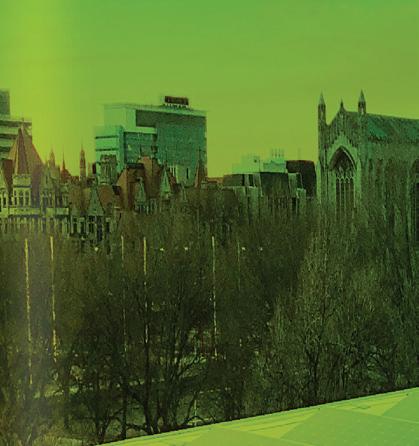
Mental health is a part of life. We need to give our brains the utmost care in order for the rest of our bodies to function. Unfortunately, mental health care and mental illness are often talked about in hushed whispers. In order to break the stigmas we have to normalize its presence in our society, celebrate people when they share their struggles, and strive to do better for those who cannot advocate for themselves.
A necessary part of that process involves learning more about the history of mental health care and attitudes about mental illness. For centuries, many cultures did not recognize mental illnesses as medical conditions. Instead, people living with mental illness were often believed to have dirty minds, be possessed, or need of religious intervention. These negative attitudes, fears, and lack of knowledge stigmatized individuals and perpetuated the need to improve mental health institutions.
In the United States, the first part of the 20th century was a time of great improvements in mental health care. One of the most significant developments occured in 1909, when Clifford Beers founded the National Com mittee for Mental Hygiene. Now known as Mental Health America (MHA), the mission of the nonprofit orga nization is to provide better care and intervention for Americans struggling with mental illness. In 1949, the MHA started the first Mental Health Awareness Month, which the Obama administration celebrated in 2013 by expanding mental health care support under the Affordable Care Act.


Although mental health is a year-round concern, Mental Health Month brings it to the forefront of public dis course. The purpose of the month-long event is to raise as much awareness as possible, educate the public, and advocate for others. For Mental Health Month 2022, Nature’s Grace and Wellness has pushed our Spark the Conversation campaign throughout various dispensaries in Illinois. Dozens of budristas participated in our mental health workshop, where they learned about mental health conditions, tips for centering the self when struggling with mental health concerns, and how to talk about them with others. We hope that the cannabis industry professionals who complete the workshop can go on to become ambassadors within their communi ties, and better serve the patients and customers they interact with every day. Sharing our lived experiences and sparking the conversation about mental health can help to break the stigmas and let others know they are not alone.
“Take care of your brain—it runs the whole machine.” —Alia
This sponsored content is paid for by Nature’s Grace and Wellness.
CHICAGOREADER.COM/NGWSPARK

MAY 26, 2022 - CHICAGO READER 15
Paid Sponsored Content
@ashapoesis
Eye on the Board of Review
A look at Cook County’s property tax appeals board
BY KELLY GARCIA
Front lawns crowded with campaign yard signs and TV commercial breaks flooded with attack ads can only mean one thing: primary elections are around the corner. For Cook County voters, that means a hefty ballot that includes the sheri , dozens of judges, the most expensive governor’s race in Illinois history, and more.
Often overlooked is the race for Cook Coun-
ty Board of Review. I don’t mean the more high-profi le Board of Commissioners, though all 17 seats for that are up for election, too.
I’m talking about the county’s three-member property tax appeals board. All three seats are up for election this year, but unless you own a few properties on Michigan Avenue, you probably didn’t know that.
The Board of Review is easily one of the least understood bodies of government in
Cook County. Every year, homeowners, landlords, and business owners receive an assessment, or estimated value, of their property from the Cook County Assessor’s o ce that ultimately determines their property tax bill. If you’re mad about paying higher property taxes because your assessment increased, the Board is the independent body you can appeal to.
Every county in the state has a property tax appeals board, usually appointed by the assessor or county board. In Cook County, board members are elected by the public. Commissioners are elected from three separate districts equal in population. They serve four-year terms while alternating a two-year term. Unlike other jurisdictions, Cook County commissioners are not required to hold a real estate law license.

Cook County homeowners can fi le an online appeal at the Board’s website. Unless you’re a commercial property owner, you don’t need an attorney to do so. All three commissioners review each appeal, and if two out of the three agree that a reduction is warranted, then the property assessment is lowered.
If a property owner is unhappy with the Board’s decision, they can also fi le an appeal with the state’s property tax appeal board or fi le a lawsuit through the Circuit Court of Cook County.
The problem is that not a lot of homeowners know they can appeal their property taxes.
Take Irma Morales for example. She’s been a homeowner in Little Village for more than 20 years. When the county reassessed property values last year, she says homeowners in her neighborhood were the last to fi nd out that they could appeal their property taxes with the assessor and she didn’t know about the independent appeal process through the Board of Review.
“I couldn’t even figure out how to fill out the forms,” said Morales, who primarily speaks Spanish.
Únete la Villita, a community organization Morales cofounded, staged a protest along with other community groups outside the
assessor’s office last summer to express concerns over high property taxes that they feared would displace small business owners and longtime residents.
Moises Moreno, executive director of Pilsen Alliance, told the Reader he and his wife could no longer a ord to live in Pilsen, due in part to high property taxes. “We’re trying not to get taxed out of the city,” he said. “I know there are families, homeowners, and small business owners whose assessments have gone up astronomically and have to decide between selling their house or risk losing it.”
Moreno says Pilsen Alliance helps homeowners appeal their taxes through the assessor’s o ce, but that they can only do so much. Like Morales, he was unfamiliar with the Board of Review. He says the appeal process is a Band-Aid solution to unfair property assessments that benefit real estate developers at the expense of longtime residents.
“I think what folks are really asking for is reform at the state level,” he said.
Some people are more familiar with the Board of Review than others. Take Alderperson Ed Burke (14th Ward), who’s currently facing federal corruption charges. Before the FBI raided his o ce in 2019, he was a partner at a law fi rm specializing in property tax appeals. His clients included big corporations such as AT&T, Walgreens, and ComEd.
According to a 2017 investigation by the Tribune and ProPublica, Burke successfully knocked $865 million o of his clients’ property tax bills between 2011 and 2016. When property taxes—the main source of revenue for schools, parks, and police—are reduced for one taxpayer, another, like Morales, has to pick up the tab.
For decades, former Illinois House of Representatives speaker Michael Madigan was similarly banking on property tax appeals. His law fi rm, Madigan and Getzendanner, has dominated the property tax appeals game for years. Madigan is still a partner at the fi rm and is currently the subject of a federal investigation into an alleged bribery scheme involving ComEd.
Southwest-side neighborhoods like Pilsen and Little Village are in the district represented by Board of Review commissioner Michael Cabonargi. He admits it’s a challenge to ensure everyone in the county has access to an appeal process that is independent of the assessor’s o ce.
According to data provided by the Board of Review, homeowners on the south and west
16 CHICAGO READER - MAY 26, 2022 ll
NEWS & POLITICS
Cook County’s Board of Review districts were redrawn in 2022. BOARD OF REVIEW
COOK COUNTY UNCOVERED
NEWS & POLITICS

sides are less likely to appeal their property taxes than homeowners on the north and northwest sides. Cabonargi says language and Internet access can be barriers for homeowners trying to appeal, adding that his o ce does extensive outreach to areas in his district.
Last year, the Illinois General Assembly redrew the district boundaries for the Cook County Board of Review (it’s required to do so every ten years), meaning all current board members are up for reelection. In an e ort to preserve minority representation on the board, the fi rst district boundaries were redrawn to include predominantly Latinx Chicago wards and suburbs such as Cicero, Berwyn, and Hanover Park.
Shortly after the new map was introduced, 12th Ward alderperson George Cardenas announced he was running for the Board of Review to unseat the fi rst district incumbent Tammy Wendt. The new boundaries for the first district would include Little Village, Brighton Park, McKinley Park—neighborhoods Cardenas has represented as alderper-
son for 19 years.
But Irma Morales and Moises Moreno say the Board of Review is just a power grab for Cardenas.
“Look at his record,” Moreno says. “Look at the donations he’s taking. Is he friendly with developers? Because developers are the ones who don’t want the change we’re asking for, which is a fair property tax assessment.”
Since 2003, Cardenas has accepted donations from dozens of real estate developers. Among his biggest donors are Pacific Star Capital CEO Aria Mehrabi, who has given him $25,000, and Bertco Development, which has donated $16,000.
Cardenas did not respond to our request for comment.
The Illinois primary elections are on June 28, 2022. The general election will be held on November 8. Election information can be found on the Cook County Clerk’s website at cookcountyclerkil.gov/ service/2022-info-candidates. v
@_KellyGarcia__
Poppy Petal Kisses
I must have cried ten thousand tears I felt lakes against my cheeks sunk puddles in my pillows Enough to drown geese
A garden grew beneath my head and everywhere the storm spread Poppies sprang up wild and strong in the places watered red lips kissed, my forehead and nose my ears, my jaw,my eyes, my cheeks, my
Cotton and silk be damned Grass lulls me to heaven’s mean sleep
There sat a couple of $300 chairs, along white table
Two empty two too many
I chose the left out of habit, and felt your warmth on my right I sat too close like you never left hugged you for too long like always did
Your scent, your laughter, your baby blue sweater Sweet friction against my face held my temples to your chest to hear to feel your heartbeat again
Inside the bubbles of your laugh and rainbow of confusion
Bass bled through your headphones as you hooked them round your neck I couldn’t wait to tell you
I’m sorry I love you I’m sorry I miss you I love you I do
In case you didn’t know, in case you had a doubt,
Snow darts nick the widow like needles My heart fell and splattered on pavement Lines of ash etched my face morning dew seeps salt in my mouth Saline sorrow with no lingering comfort clouds gather until they are too heavy to hold
Heaven breaks and storms to water the garden where I’ll be with you again
By Nia Scott
Themes of lineage, Caribbean visual culture, fashion, and identity are critical to Scott’s research and studio practice. Visual communication, book making, typographical design, and writing are central explorations in their work as a storyteller.
Poem curated by Jada-Amina. Jada-Amina is a South Side Chicago born and based, Black Indigenous American singer, writer, and cultural worker.
A biweekly series curated by the Chicago Reader and sponsored by the Poetry Foundation.






MAY 26, 2022 - CHICAGO READER 17
Free Spring Programming from the Poetry Foundation! Learn more at PoetryFoundation.org Hours Wednesday, Friday, and Saturday: 11:00 AM–4:00 PM Thursday: 11:00 AM–8:00 PM
Exhibition Celebration with Monica Ong (In Person)
of all ages are invited to view and interact with
Ong’s visual poems and enjoy a reading by the artist. Thursday,
16,
7:00 PM
Planetaria
Visitors
Monica
June
2022,
EL CONDADO DE COOK AL DESCUBIERTO
La Junta de Revisión
Una mirada dentro de la junta de apelaciones de impuestos sobre la propiedad del condado de Cook
Por KELLY GARCIA
Jardines llenos de letreros de campaña y comerciales de televisión inundados de anuncios de ataque solo significa una cosa: las elecciones primarias se acercan. Para los votantes del condado de Cook, eso significa una boleta llena de candidatos que incluye el alguacil, docenas de jueces, la contienda por gobernador más costosa en la historia de Illinois y más.
Pero la Junta de Revisión del Condado de Cook es una contienda desconocida por la mayoría de votantes. No me refiero a la Junta de Comisionados de más alto perfil aunque estos 17 puestos también tienen que ser re-elegidos. Me refiero a la junta de tres comisionados encargados de las apelaciones de impuestos sobre la propiedad. Los tres comisionados también serán parte de las elecciones este año, pero a menos que tengas algunas propiedades en la avenida Michigan, probablemente no lo sabía.
La Junta de Revisión es unos de los departamentos de gobierno menos entendidos en el condado de Cook. Cada año, propietarios de vivienda, propietarios y dueños de negocios reciben una evaluación, o estimación del valor de su propiedad, de la oficina del Asesor
del Condado de Cook que, últimamente, determina el costo de los impuestos de propiedad. Si está enojado porque tiene que pagar altos impuestos de propiedad, la Junta es la organización independiente a la que puede apelar.
Todos los condados del estado tienen una junta de apelaciones de impuestos sobre la propiedad, generalmente nombrada por el asesor o la junta del condado. En el condado de Cook, los miembros de la junta son elegidos por el público. Los comisionados son elegidos de tres distritos iguales en población. Sirven términos de cuatro años alternando un término de dos años. A diferencia de otras jurisdicciones, los comisionados del condado de Cook no están obligados a tener una licencia de derecho inmobiliario.
Los dueños de propiedades del condado de Cook pueden presentar una apelación en el sitio web de la Junta. A menos que sea dueño de una propiedad comercial, no necesita un abogado para apelar. Los tres comisionados revisan cada apelación, y si dos de los tres están de acuerdo con la justificación por la que piden reducir el valor de la propiedad, entonces deciden bajar el costo.
Si el dueño de una propiedad no está satisfecho con la decisión de la Junta, también puede presentar una apelación ante la junta estatal de apelaciones de impuestos de propiedad o presentar una demanda ante el Tribunal de Circuito del Condado de Cook.
El problema es que no muchos propietarios saben que pueden apelar sus impuestos de propiedad.
Tomemos como ejemplo a Irma Morales. Ella ha sido propietaria de una casa en La Villita durante más de 20 años. Cuando el condado volvió a evaluar los valores de las propiedades el año pasado, dice que los propietarios de viviendas en su vecindario fueron los últimos en enterarse de que podían apelar sus impuestos de propiedad con el asesor y que ella no sabía sobre el proceso independiente de apelación a través de la Junta de Revisión.
“Ni siquiera sabía cómo llenar los formularios”, dijo Morales, quien principalmente habla español.
Únete la Villita, una organización comunitaria co-fundada por Morales, junto con otros grupos comunitarios protestaron frente de la oficina del asesor el verano pasado para expresar su preocupaciones por los altos impuestos de propiedad que temían desplazarían a los propietarios de pequeñas empresas y residentes con años viviendo en sus vecindarios.
Moises Moreno, director ejecutivo de Pilsen Alliance, le dijo al Reader que él y su esposa ya no podían vivir en Pilsen, debido en parte a los altos impuestos de propiedad. “Estamos tratando de que no nos corran fuera de la ciudad”, dijo Moreno. “Sé que hay familias, propietarios de viviendas y propietarios de pequeñas empresas que les han subido sus valoraciones astronómicamente y tienen que decidir entre vender su casa o correr el riesgo de perderla”.
Moreno dice que Pilsen Alliance ayuda a los propietarios de viviendas a apelar sus impuestos a través de la oficina del asesor, pero que no pueden hacer mucho más que eso. Al igual que Morales, Moreno no estaba familiarizado con la Junta de Revisión. Él dice que el proceso de apelación es una solución corta para las evaluaciones de propiedad injustas que benefician a los desarrolladores a expensas de los residentes que tienen años viviendo en la ciudad.
“Creo que lo que la gente realmente pide es un cambio a nivel estatal”, dijo Moreno.
Algunas personas están más familiarizadas con la Junta de Revisión que otras. Tomemos como ejemplo al concejal Ed Burke (distrito 14), quien actualmente enfrenta cargos federales de corrupción. Antes de que la Oficina Federal de Investigaciones (FBI, por sus siglas en inglés) redo su oficina en 2019, era socio de un bufete de abogados especializado en apelaciones de impuestos de propiedad. Sus clientes incluían grandes corporaciones como AT&T, Walgreens y ComEd.
Según una investigación en 2017 por Tribune y ProPublica, Burke logró eliminar $865 millones en impuestos de propiedad para sus clientes entre 2011 y 2016. Cuando los impuestos de propiedad– los ingresos que fi nancian las escuelas, los parques y la policía– se reducen para un contribuyente, otro, como Morales, tiene que pagar la cuenta.
Durante décadas, el ex presidente de la Cámara de Representantes de Illinois, Michael Madigan, se benefició de manera similar en las apelaciones de impuestos de propiedad. Su bufete de abogados, Madigan and Getzendanner, ha dominado el juego de apelaciones de impuestos de propiedad durante años. Madigan sigue siendo socio de su bufete y actualmente es sujeto de una investigación federal sobre un presunto esquema de soborno que involucra a ComEd.

Los vecindarios del lado suroeste como Pilsen y La Villita están en el distrito representado por el comisionado de la Junta de Revisión, Michael Cabonargi. Admite que es un reto garantizar que todos en el condado tengan acceso a un proceso de apelación que sea independiente de la oficina del asesor.
Según los datos proporcionados por la Junta de Revisión, los propietarios de viviendas en los lados sur y oeste tienen menos probabilidades de apelar sus impuestos de propiedad que los propietarios de viviendas en los lados norte y noroeste. Cabonargi dice que el idioma y el acceso a internet pueden ser barreras para los propietarios de viviendas
18 CHICAGO READER - MAY 26, 2022 ll
NEWS &
POLITICS
En 2022, la Asamblea General rediseñó los límites del distrito para la Junta de Revisión. BOARD
OF REVIEW
NEWS & POLITICS

que intentan apelar, y agrega que su oficina hace mucho para alcanzar a la gente que vive en las áreas de su distrito.
El año pasado, la Asamblea General de Illinois rediseñó los límites del distrito para la Junta de Revisión del Condado de Cook (es obligatorio hacerlo cada década), lo que significa que todos los miembros actuales de la junta enfrentan una reelección. En un esfuerzo por preservar la representación de las minorías en la junta, los límites del primer distrito fueron rediseñados para incluir comunidades predominantemente latinos de Chicago y suburbios vecinos como Cicero, Berwyn y Hanover Park.
Poco después de que se introdujera el nuevo mapa, el concejal del Distrito 12, George Cardenas, anunció que se postulaba para la Junta de Revisión para desbancar a Tammy Wendt, quien representa el primer distrito. Los nuevos límites para el primer distrito incluirían La Villita, Brighton Park, McKinley Park, vecindarios que Cárdenas ha representado como concejal durante 19 años.
Pero Irma Morales y Moises Moreno dicen
que la Junta de Revisión es solo una toma de poder para Cárdenas.

“Mire su récord”, dice Moreno. “Mira las donaciones que está tomando. ¿Es amigable con los desarrolladores? Son los desarrolladores que no quieren el cambio que estamos pidiendo, que es una evaluación justa al impuesto de propiedad”.
Desde 2003, Cárdenas ha aceptado donaciones de decenas de desarrolladores. Entre sus donantes se encuentran el director ejecutivo de Pacific Star Capital, Aria Mehrabi, quien ha donado $25,000, y Bertco Development, que donó $16,000.
Cárdenas no respondió a nuestra solicitud de comentarios.

Las elecciones primarias de Illinois son el 28 de junio de 2022. Las elecciones generales se llevarán a cabo el 8 de noviembre.
La información electoral se puede encontrar en el sitio web del Secretario del Condado de Cook cookcountyclerkil.gov/ service/2022-info-candidates. v
@_KellyGarcia__
MAY 26, 2022 - CHICAGO READER 19
Artist Series Exhibitions Free & Open to the Public Featuring 80+ Chicago Artists Columbus Park Field House, 500 S Central Ave Rowan Park Field House, 11546 S Ave L Kennedy–King College, 740 W 63rd St chicago.gov/vaxchiart
All $ spent on any resale items benefits the environment. By slowing virgin resource extraction, you help birds, bees, butterflies, and ALL WILDLIFE HABITAT!
Design Museum of Chicago
NEWS & POLITICS
Homes public housing projects. At its peak, the complex known for its high-rise buildings was home to at least 15,000 people, predominantly Black and low-income families.
In 1999, Daley announced his intention to tear down the high-rise towers. The city pledged to spend more than $1.5 billion over ten years to demolish 18,000 apartments and build or rehabilitate 25,000 apartments. Despite this pledge, it’s impossible to forget the thousands of Black people displaced from the area that, when they lived there, craved the type of fi nancial investment and opportunity that a new casino would bring.
Gambling on Bally’s
By TONIA HILL, THE TRIIBE
Earlier this month, Mayor Lori Lightfoot announced Bally’s Corporation as the winning bid for Chicago’s sole casino license. On Wednesday (after press time), the proposal goes to the City Council, and if approved, it will go to the Illinois Gaming Board for approval. The state gaming board oversees gambling and gaming through oversight of riverboat and casino gambling, and sports wagering.
If the proposal is approved across the board, the new casino-resort and entertainment complex will be constructed at the Chicago Tribune ’s Publishing Center, located at 560 W. Grand near North Halsted Street and West Chicago Avenue in the River West neighborhood. Construction is expected to be completed in 2025. In the meantime, Bally’s plans to operate a temporary casino at Medinah Temple in the neighboring River North neighborhood.

The $1.7 billion casino proposal includes a
3,000-seat theater, a 500-room luxury hotel that would open with 100 rooms, a Riverwalk extension, a pedestrian bridge, an outdoor park, an outdoor music venue, an amenity terrace featuring a large pool spa, fitness center, a sun deck, a food hall, cafes, and six restaurants. It will also o er space for 3,400 slot machines and 170 gaming tables.
The project is expected to generate 3,000 construction jobs annually and 3,000 permanent casino jobs, and bring in $400 million a year in gaming and other revenues for the city and state.
Lightfoot asked for up to $75 million for the city from casino bidders. Bally agreed to give the city $40 million upfront and $4 million annually for the Host City Agreement.
“A city casino signals to the world that our economy is on a strong path toward recovery, ready to develop new and lucrative projects that will benefit all of our residents,” Lightfoot said during Thursday’s press conference.
“It would serve as a catalyst for additional large-scale economic developments that would only accelerate our city’s post-pandemic recovery.”
The casino would allow the city to capitalize on gaming and other revenues to provide new funding sources for Chicago police and fi re pension funds, she added.
Bally’s Casino will “capture the gaming revenue that has been lost for far too long to neighboring jurisdictions,” Lightfoot continued. Illinois is already home to eight casinos, including the Rivers Casino Des Plaines.
The press conference brimmed with excitement from lawmakers and stakeholders for the possibility of a casino coming to Chicago. It’s an idea that’s been 30 years in the making, beginning with then-mayor Richard M. Daley’s creation of the Chicago Casino Commission in April 1992.
The casino’s proposed site is a stone’s throw away from the former Cabrini-Green
Today, after the majority of Black residents have been forced out of Cabrini-Green, the neighborhood looks radically different. It’s now scattered with luxury apartments, townhomes, and condos. In the midst of its gentrification, what remains of the legacy of Black people and the housing projects are the two-story row houses hidden just north behind Chicago Avenue, and the Wayman AME church building. The latter was listed for sale as of October 2021, despite its historic roots in the community.
At Thursday’s press conference, Alderperson Walter Burnett, Jr. (27th Ward) spoke about his upbringing in Cabrini-Green. He grew up in the row houses on North Cambridge Avenue, about a mile north of the proposed casino site.
Burnett supports Lightfoot’s casino choice, which would place the new development in his ward. For him, Bally’s casino means progress.
“I wasn’t afraid of progress. I wasn’t afraid of prosperity when we had to tear down the former Cabrini-Green high-rises. I wasn’t afraid,” Burnett said.
The undertones of Burnett’s comments today made it seem like the neighborhood’s previous residents weren’t worthy of the same investment as its successors or that it was OK to displace people because it brought us to the progress we’re seeing today. He acknowledged that the people who live in the community today would not have come to the area when the Cabrini-Green high-rises were still there.
“We helped all of them to prosper in that
20 CHICAGO READER - MAY 26, 2022 ll
An artist’s rendering of the proposed Bally’s casino COURTESY OF BALLY’S
RACIAL EQUITY
Cabrini-Green’s displaced residents are not being included in Chicago’s casino.
NEWS & POLITICS
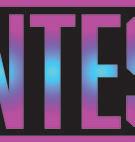
community and be able to live in the luxuries that they live in now, and that’s because we weren’t afraid because we felt like we needed to do what’s right and help people progress and have a better place to live,” Burnett continued.
Throughout the casino bidding process, the city required that bidders have minority involvement. For example, the city required that casino bidders include 26 percent minority business enterprise participation, 6 percent women business participation, and businesses from Chicago included in the design and construction of the project.

However, Burnett’s comments about Cabrini-Green call that into question. City lawmakers have been making promises to former Cabrini-Green residents for years, and many of those promises never came to fruition. Will it maintain its new promises to minorities and women now?
Following the displacement of thousands of Black Cabrini-Green residents, Daley also promised 2,500 construction jobs and told them they’d be able to return.
A 2021 Better Government Association (BGA) investigation found that of the 2,500 construction jobs Daley promised to Cabrini-Green residents, only 40 people received jobs. Additionally, more than 80 percent of the families who were promised they could return did not because they could no longer afford to live in the neighborhood, “were disqualified, relocated, or were simply overwhelmed with bureaucracy and many died waiting,” according to the BGA’s investigation.
With Black displacement in Cabrini-Green came a sudden overflow of financial investment and new developments that weren’t made available to its previous residents. It’s hard to separate today’s casino announcement from Cabrini-Green’s legacy and what’s to come with Bally’s casino that was made possible at the expense of displacing Black people.
Out of the three casino bids up for consideration, including Rivers 78 and One Central, Lightfoot said she selected Bally’s proposal over the others because of its commitment to meeting equity goals outlined by the casino selection committee. Bally’s is also one of the only operators that did not have a competing casino in the Chicagoland region. She said that Bally’s also has a labor peace agreement with organized labor.
In addition, the forthcoming casino will




commit to 60 percent minority hiring and will create a jobs program that targets neighborhoods with the highest levels of unemployment and lowest income.
Additionally, Burnett pointed out that having the Bally’s would increase revenue in the city and drive in more visitors. “It would be a disservice for us as [the] government who have a fi scal responsibility to our citizens not to allow this casino to be built in our city,” he said.
However, Burnett added that it would be irresponsible for the city not to take advantage of the opportunity. “Who wants to pay more property taxes,” he asked. “I know I don’t.”

“We believe that Bally’s is ready to bet on Chicago. We think this is a wonderful way for Chicago to continue its recovery from COVID-19,” said Soo Kim, chairman of Bally’s Corporation board of directors.


Kim added that the project is for underrepresented groups of people that capitalism left behind. This project, he added, will include them. Additionally, he said that the project would keep property taxes low.
“We understand how important it is for the other laborers here to work together, build this casino, operate this casino together, and what an opportunity it is for them,” Kim said. “We understand how for all underrepresented groups that in some ways capitalism has left behind, that this is a project that will include them and that it will allow them to be a part of ownership, management, and operations. We understand all of the promises that this casino allows the city of Chicago to keep and the state of Illinois to keep. We accept and bear those responsibilities.”
According to N’Digo, a Black newsmagazine based in Chicago, Bally’s was criticized for how it initially structured minority investment, claiming that after six years, investors could sell their shares.
That has since changed. According to N’Digo, minority investors now can hold onto their investment or sell their ownership position back to Bally’s. The project promises that at least 20 percent of ownership will be women and minorities.


On Monday, May 9, a special committee convened to ask Bally’s questions about its plan, and on Thursday, May 12, the city hosted a community engagement event at UIC. On Monday, a city council committee voted to send the plan to the full council when it convened on May 25, after we went to press. v

MAY 26, 2022 - CHICAGO READER 21
@_ToniaHill EARLY WARNINGS Chicago s essential months ahead music calendar Enter to win! chicagoreader.com/contests
ARTS & CULTURE
torn and reimagined, reconstructed, stitched up, and tattered all resemble the monster— too horrible and terrifying for everyday life. But being a monster is not such a terrible thing. “I believe the grotesque itself evokes both empathy and disgust. I hope once the possible initial shock wears off the stillness and calmness of the unmoving object asks the viewer to stay. I tried to underline this conflict with the fake eyelashes of Geryon and the facial expression that for me communicates awe or wonder,” said Ala-Ketola.
Autobiography of Red takes a mythical monster and the myth of Heracles (renamed Herakles for the book) and updates them into modern-day characters, with Herakles and Geryon recast as lovers (instead of enemies in ancient Greece). Ultimately, Herakles does not steal Geryon’s red cattle but instead steals his heart. Carson focuses on themes of trauma and learning to live in one’s body, even when someone you love discards it.
“DREAMS & DELUSIONS”
Through 5/29: Sun 1-5 PM or by appointment, 4th Ward Project Space, 5338 S. Kimbark, instagram.com/4thwardprojectspace
Geryon’s wings . A bulbous hand hangs from the spine of the wings with a cross-like chain necklace dangling from a finger. In literature, Geryon is described as having three bodies or three heads and is often depicted as having humanoid features, such as wings. And he is known for his red-colored cattle. In the exhibition, the works represent various parts of Geryon: his wings, his separated body, images on the walls, and Orthrus, a serpent-tailed dog that guarded Geryon’s cattle. In the piece Grasp, the head of a dog-like creature rests on a pedestal—it confronts you as you walk into the gallery.
Surrounding the sculptures are 2D works on the wall, pigment on paper, and a large print mounted on drywall—red-hued and veiny. It’s titled Erytheia, after the island where Geryon lives with his cattle.
The work is like dreaming. They are deluded scenes in the corners of your mind. I’m reminded of Titane , a 2021 body horror film that represents queerness and the violence of the binary. For Ala-Ketola, movies like Crash, Videodrome , and A History of Violence have been influential to him, but The Fly was the most significant for the exhibition.
EXHIBITIONS
Down the stairs and into ‘Dreams & Delusions’
By S. NICOLE LANE
“Not touching but joined in astonishment as two cuts lie parallel in the same flesh,” writes Anne Carson in the 1998 novel, Autobiography of Red. Breathing new life, ripping parts apart—it’s the painful, heart-wrenching reality of being alive, of being absolutely anything at all. This is the work of Finnish artist Kristoffer Ala-Ketola, whose first U.S. solo show, “Dreams & Delusions,” is on display at the Hyde Park gallery 4th Ward Project Space through May 29.
In Autobiography of Red , Carson reimagines the ancient Greek mythological monster Geryon as a queer teenage photographer (who is also a monster, red with wings). The pieces in the show nod toward the teen and some are even named after him. The sculptures are
quite literally being torn apart, with bits of flesh, skin, and muscle exposed. Bone appears through the rips of red. “My Geryon is in turmoil but quite peacefully so,” said Ala-Ketola in an email interview.
Queerness and monsters have gone handin-hand for decades with society deeming the monster archetype as something “other,” something queer and not straight. The horrorfilm monster trope illustrates how queer folks are demonized and shamed, cast into isolation and ostracized.
Classic films and books like Frankenstein , The Wolf Man , or Dracula’s Daughter are queer-coded with themes of rejection, society’s anger, and the ultimate demise of many of these monster characters. The body, being
For Ala-Ketola, the work in “Dreams & Delusions” represents healing. In the piece Geryon we see a body—made of papier-mâché from pages of a book, modeling clay, and silicone— being separated in the center of the gallery. Black jeans cover some of the bottom half, with a demon-like phallus straight from Dante’s Inferno, and knobby demented feet sticking out of the bottom. The top half of the body, less than a foot away, has red-stained bones that connect to a head with two horns. Eyelashes and handsome features resemble a human, a look of awe appears on the sculpture’s silicone face. Ala-Ketola reminds the viewer that while being pulled apart, while overcoming violence or pain, a person can also get better.

“I see healing as something that isn’t always a straightforward, positive, and nice process,” said Ala-Ketola. “We need to break something to put ourselves back together whether it’s a synaptic connection in our brain to change the way we think or something in our appearance. I hope that in the sculpture’s world or inner logic the stillness makes it possible for the body to be both pulled apart as well as put back together.” If you’re going through hell, you have to—quite literally—keep on going.
It’s not easy to walk away from Ala-Ketola’s works. A set of wings without the feathers hangs on the gallery’s rear wall in a piece titled
“I am interested in body horror, [the] grotesque, and I wanted to engage with these themes deeper with this show. I am drawn to semiotic opposition in order to create something new. I’m excited when a thing can be described as angry and calm, or funny and melancholic,” he said.
In Carson’s novel, she writes, “I will never know how you see red and you will never know how I see it,” which is a similar signal here in Ala-Ketola’s work. Something that may look vile and terrifying to one viewer may bring comfort and calmness to another. When the sculpture looks like it’s in pain, it’s actually healing. Geryon’s character quite literally chokes at the pain he feels. We will never know Geryon’s pain and he will never know ours.
Carson’s queer romance represents the pain of being hurt by a loved one, and Ala-Ketola’s work displays the shambles of what remains. A visual representation of queer bodies and the absolute ache of recovery—from love, societal rejection, or body dysmorphia—are aligned here in Ala-Ketola’s retelling of Geryon.
The works are fantastical as they resemble monstrous characters that weave in and out of reality, in and out of the dimension of Carson’s text, Greek mythology, and the artist’s own interpretation. v
22 CHICAGO READER - MAY 26, 2022 ll
Half of Geryon is clad in black jeans; “feet” are visible on the bottom . COURTESY KRISTOFFER ALA-KETOLA
Finnish artist Kristoffer Ala-Ketola recasts an ancient Greek monster.
@snicolelane








































MAY 26, 2022 - CHICAGO READER 23 600+ Tours starting from $1,200 pp Speak to an expert at: 866-502-2279 Hours: 9 am - 7 pm EST Monday - Friday
PUBLIC ART

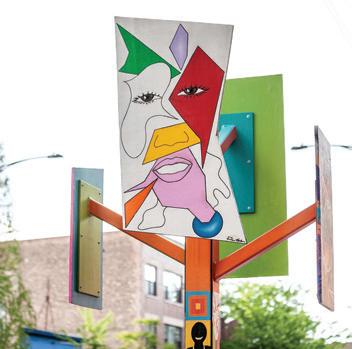
Reshaping the landscape on the southeast side
By IRENE HSIAO
Aribbon-cutting ceremony was held on May 21 at 89th and Commercial on the southeast side. It celebrated the opening of Commercial Ave Alfresco, a joint initiative organized by the group South Chicago Parents & Friends along with the city’s Special Service Area 5 commission. Both entities worked together with local artists and businesses, and received grant money to assist their quest to revitalize the neighborhood with outdoor dining, pop-up markets, public art, and outdoor performances.
Located near the mouth of the Calumet River, the southeast side of Chicago, once a seasonal settlement for the Potawatomi people, has been in recent history identified primarily by South Works, the U.S. Steel manufacturing plant built in 1881, which, at its height, employed some 20,000 Chicagoans and helped make Chicago the country’s largest producer of steel. Ashed over by soot and showered in toxic chemicals, the mill neighborhood known as “the Bush” has long been plagued by economic distress, which only increased when the steel mill experienced prolonged shutdowns and finally closure in 1992.
“People think the south side is the Museum of Science and Industry, the South Shore Cultural Center. 71st Street is about the end of the world. Anything past that is, ‘Huh, the Bush?

They got plants?’ It’s lost,” says artist Derric Clemmons.
Clemmons, who was born, raised, and continues to live on the southeast side of Chicago, is helping to reenvision the landscape of the southeast side with his Urban Trees project, which transforms industrial steel into colorful landmarks that the city hopes will increase visibility and highlight the vibrancy of a neighborhood often dismissed as, in Clemmons’s words, merely “meat and potatoes, blue collar, low income, struggling.”
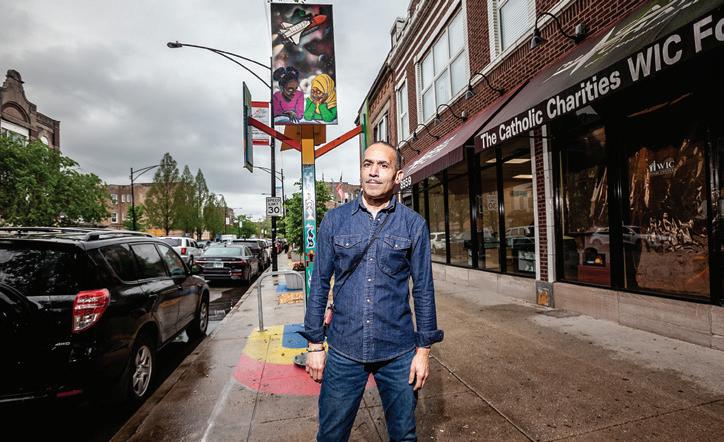
Clemmons first gained exposure to art and activism through his uncles, Bill Davis and Steve Davis, both commercial and documentary photographers. “My family was vigilant during the Civil Rights movement—they were members of the PUSH organization led by Jesse Jackson. My aunts and mother were involved in protests, trying to lift their voices. My uncles were photographing the situations that were happening, the turmoil, the upheaval, during Martin Luther King and then Malcolm X. They wanted to capture life as it was developing, especially at a time of upheaval.”
Clemmons pursued photography and fine art in the 70s at Columbia College and spent a short time in the 80s studying in Italy. Yet by the 90s, “I began to look at the landscape of my neighborhood as inspiration. It gave me an
opportunity to represent my neighborhood, the southeast side from 79th to 100th Street.”
Now Clemmons, along with Brian Pitt, Mario Mena, and Pierre Seaton—his crew at South Worx Arte Group—are reshaping the landscape of the neighborhood with Urban Trees. “It was all done locally, as a community-based initiative,” he says, describing a process that began in his garage and gradually expanded to the 1,000-square-foot dock of a neighborhood center for youth mentoring.
Clemmons and his team learned to weld and work with steel through local business partners, who have become friends and advisors on the project. Key to the trees are the weatherproof panels that feature work by other local artists, which will rotate in continuous renewal every few years to bring a new crop of talent to the public eye on the 8900 block of Commercial.
“It is a community that is vibrant in its own way,” says Clemmons of his neighborhood. “It is mom and pop struggling to keep their storefronts open. It’s a community of mixed individuals who are for the most part accepting of each other. There are cultural festivals: Mexican, Polish, holiday events. There are dance groups and there are African American drum groups that perform. Yellow kiosks have been installed, which are small pop-up stopand-shops for businesses to sell out in the open, to get people to stop and shop in those areas and to get people to know that they exist. The sidewalks have been painted in front of various businesses—a 1960s pop art [-style] multicolored display. And the trees are on top of these multicolored locations. So it speaks to the vibrancy of the di erent cultures here.
“We got Nigerian, we got Somalian, we got Mexican and Puerto Rican, we got European, all mixed up over here. When you walk over here, you’ll see paleta trucks, panaderias, African shops where you can get meat, all kinds of spices from di erent countries, a Black-owned hat shop. When you walk down the street, you see people who are strong, who don’t want to give up. I see plants grow in some of the worst areas. If a flower can do that, I’m going to try that. The trees are strong structures that are enduring. They represent pushing forward through adversity.” v
southworxartegroup.com
24 CHICAGO READER - MAY 26, 2022 ll
@IreneCHsiao ARTS & CULTURE
Artist Derric Clemmons and his team engage with community in South Chicago.
COMMERCIAL AVE ALFRESCO sweethomesouthchicago.org
Derric Clemmons EDDIE QUIÑONES FOR CHICAGO READER
DERRIC CLEMMONS AND SOUTH WORX ARTE GROUP
Some of the Urban Trees with art on display EDDIE QUIÑONES FOR CHICAGO READER
Thu 6/2, 9:45 AM-7 PM, Gray Center for Arts and Inquiry, 929 E. 60 th, graycenter. uchicago.edu, free, bring your own skateboard if you wish to skate
A still from a recent animation created by artist and skateboarder Alexis Sablone
 COURTESY THE ARTIST
COURTESY THE ARTIST
ARTS & CULTURE
else not seen as the “traditional” skateboarder. Alongside FroSkate, there’s OnWord Skate Collective here in Chicago, and beyond that, there’s SK8 Babes on the east coast, Skate Like a Girl on the west coast, Proper Gnar elsewhere in the midwest—the list goes on.
Still, an event like The Useless Tool feels unique, with a distinct focus on the body and physicality of skateboarding.
SYMPOSIA
Skateboarding as social practice
An event
at the Gray Center to theorize about gleaming the cube
By TARYN ALLEN
An average spectator might observe a skateboarder as nothing but a person on wheels; they see an athlete—or a delinquent, maybe—pushing and coasting and jumping (“How does the board stick to the bottom of their feet?”), there one minute and gone the next.
But from the rider’s perspective, the world is transforming around them. Minute shifts in body weight a ect balance, a slight change in toe placement means a di erent trick. It’s all about speed, it’s all about power, it’s a perfect storm of technique, confidence, and a little bit of magic.
That experience touches on the ethos of The Useless Tool (Skate Sessions), an upcoming free event at the University of Chicago’s Gray Center for Arts and Inquiry. The event is billed as “a day of skateboarding and conversation about skateboarding as social and embodied practice.” It was organized by Kyle Beachy, local skateboarder, associate professor at Roosevelt University, and author of 2021’s The Most Fun Thing: Dispatches from a Skateboard Life; Tina Post, a performance theorist and assistant professor of theater and performance studies at the University of Chicago; and Alexis Sablone, artist, architect, and professional skateboarder.
The event is structured into two sessions, with food, skating, and community-building before, between, and after. The first session is loosely titled “skateboarding and the
world,” featuring pro skateboarders Kristin Ebeling and Timothy Johnson; Natty Bwoy, a skateboard and bicycle repair shop on the south side of Chicago; and FroSkate, a local skate collective that centers BIPOC femme, trans, gender nonconforming, and nonbinary skaters.
“Our concerns in the morning session will be skateboarding’s emplacement, for lack of a better word: space, place, race and gender, community formation,” Post wrote in an email.
The second session is “skateboarding and the moving body,” with performance company Every house has a door, collaborative artist practice Sonnenzimmer, and writer and technologist Maxwell Neely-Cohen.
Post noted, “We’re trying to thread the needle of, on the one hand, enough structure to ensure no one feels like the day was just hanging out, and on the other, enough looseness to feel like a skate session—free form, improvisatory, spontaneous, and able to hold both success and failure. For the sake of some structure we’ve organized the parts into morning and afternoon, it’s really the case that we’re hoping to all skate and think together across sessions.”
The typical skate session Post refers to is not uncommon. There’s a growing number of collectives and groups that meet up across Chicago to find community in skateboarding, especially women, queer people, and anyone
Post shared her perspective: “I believe there’s such a thing as embodied knowledge, and I love thinking about how we acquire this and what it informs about our lives, and what becomes available to us when our brains become more aware of the things our bodies know. For example, it is interesting to me that in order to land a trick, you have to be able to anticipate how fast your board is going and how fast your body is going and also where your weight will need to be in the future, down to a second. The anticipation of moving balance, the future sensing of your interior senses, seems metaphorically rich (in addition to the more obvious valuable things about skateboarding, like being banged up and stubborn and so forth).”
“I also love thinking through style,” she continued. “How and why do bodies acquire style in movement? ”
By asking these questions, Post is helping to put a focus on skateboarding at the Gray Center, which has been a goal of the center for some time. With the support of director of programs and fellowships Zachary Cahill, assistant director of fellowships and operations Mike Schuh has been working to bring skateboarding programming to the organization since 2017. Schuh connected with Beachy, who contributed skateboarding content to the center’s journal Portable Gray, and participated in a livestreamed conversation event with Sablone in 2021. This whole team joined together with Post to plan the event.
When asked about what she expects from The Useless Tool, Post said, “As this event is coming together, I think it really will be in the best spirit of ‘arts and inquiry’—heady, experimental, and above all, fun.”
Beachy added, “The more you push on skateboarding the more you realize that it’s magic. . . . I don’t think any of us really have any idea how this is going to go. And that too is skateboarding: personal catastrophe and outrageous success are all always equally possible. That’s exciting.” v
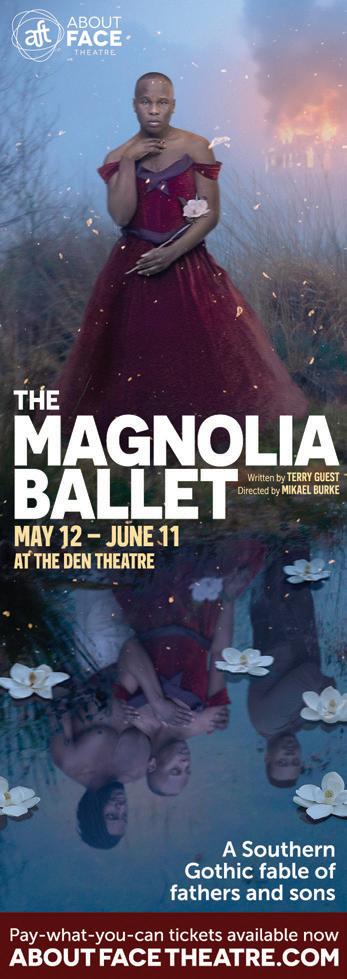
MAY 26, 2022 - CHICAGO READER 25
TOOL
R THE USELESS
(SKATE SESSIONS)
@itstarynallen
REVIEW
Southern spells
About Face’s The Magnolia Ballet offers a rich and enchanting feast.
By DAN JAKES
Agood play, suggests Tony Kushner in his 1995 anthology Thinking About the Longstanding Problems of Virtue , “should be overstuffed.” Memorably comparing well-constructed theater to lasagna, he writes that a work of theater “should have barely been rescued from the mess it might just as easily have been” and, at its best, “has a bursting omnipotence up its sleeve, or rather, under its noodles.” That’s an apt description for this tender, searing, funny, and thoroughly moving new piece by Terry Guest, which packs more humanity in its 95 minutes than many projects do over multiple acts.
For queer Black teen Z (Guest), it doesn’t take many rounds of begetting to connect himself to his enslaved Georgia ancestors—a lineage in which softness and vulnerability was, and in many ways still is, at odds with survival. Much of Guest’s story centers on its protagonist’s relationship with Black masculinity and the challenges of navigating his father Ezekiel’s (Wardell Julius Clark) emotional rigidity, but The Magnolia Ballet itself is pointedly not rigid. Rather, it gracefully bends. It bends in its narrative structure, in its gravity, in its timeline, and in its foggy, macramé fishingnet-draped set by designer Steven Abbott and lighting designer Eric Watkins. Blurring soliloquies, music and movement interludes, fantasy sequences, and realism, Guest creates a layered and fully realized pastiche of one queer kid’s journey to find his place in Ameri-
RTHE MAGNOLIA
gether with all the contradictions fully intact. Part of that, I suspect, is the production’s superb use of music (eclectic sound design by Brian Grimm) and movement (choreography by Jenn Freeman), which viscerally convey elements of Z’s experience more directly than words alone could. In a compelling abstract movement sequence, for instance, we see a music-set pantomime of Ezekiel giving his son a haircut. It’s a gentle and warm bit of physical a ection from father to son, man to man, never spoken of or alluded to overtly, that conveys everything audiences need to know about the father’s inner understanding of and desire for gentleness, inaccessible to him as it may be.
heirloom Confederate uniform, demanding to be called “Sir,” before Z turns to the audience with a deadpan understatement: “Being a kid was confusing.” Less confusing, he tells us, was his boyhood sexual awakening while watching D’Angelo’s early-aughts “Untitled” music video, perhaps the most influential gay coming-of-age artifact for millennials outside of Abercrombie shopping bags. “When you’re a child,” Z says, “you haven’t learned the parts of yourself you’re supposed to hide.”
BALLET
Through 6/ 11: Thu-Sat 7: 30 PM, Sun 3 PM; Den Theatre, 1331 N. Milwaukee, 773 697 3830, aboutfacetheatre.com, $ 5 -$ 35
can society, his family, and his own body.
In many new plays, an ethereal, collage-like approach to storytelling can often feel scattered or indulgent, but in director Mikael Burke’s production for About Face Theatre, each seemingly incongruous piece fits to-
Similarly stunted in his ability to recognize and accept his own feelings (albeit for very different reasons) is Z’s white stoner classmate, Danny (Ben Sulzberger), with whom Z has built a friendship over video games and surreptitious blow jobs. While Z is crystal clear in his sexuality, it’s entirely possible that Danny is bi and more than likely will never need to come out. In a fraught and bleakly funny scene, the two wrestle and tickle homoerotically while Danny wears a family
For Z’s father Ezekiel, though, hiding has become so secondhand that he can’t seem to break out of it, even when it’s what he wants. In multiple moments, we witness Ezekiel wishing to reach out and establish a connection with his only son, but—frustratingly—he can’t quite soften himself for fear he’ll break. Across the board, The Magnolia Ballet is buoyed by a quartet of excellent and nuanced performances, and it’s a credit to Clark’s portrayal that a character capable of spewing homophobic venom toward his son is also capable of heartache and compassion (as well as biting humor and menace, doubling as Danny’s virulently racist white cop dad).
As the Mitchell family bloodline made mani-
fest, Sheldon D. Brown lends a vocal resonance and physical authority to the “ghost” element of Guest’s southern gothic ghost story. It’s a subtle, often literally backgrounded performance, but it’s integral to what works so well about the show, including Brown’s a ectionate and emotionally available depiction of Z’s late mother and, just as interestingly, her thawing influence on Z’s dad. And as Z, Guest creates a rich, complicated character who is coming to terms with the prospect of leaving his Georgia home—a realization that feels less like freedom than coming untethered.
Much of the often-produced theatrical queer canon can feel stuck in time, stuck in New York, and stuck in a recurring handful of themes. One of the enduring successes of About Face Theatre, I’ve found, is the company’s consistency in bucking that trend by producing work that feels current and raw and relevant across the broad spectrum of the LGBTQ+ community. The Magnolia Ballet is another step forward in that tradition, one that had me thoroughly enchanted by its spell. v
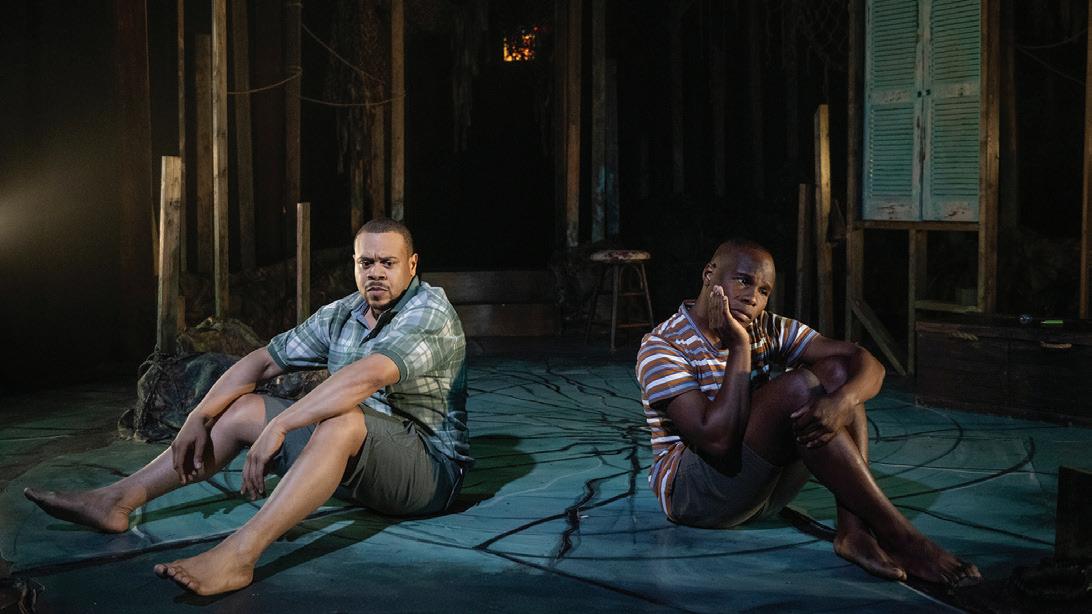
26 CHICAGO READER - MAY 26, 2022 ll
THEATER
Wardell Julius Clark and Terry Guest in About Face Theatre’s The Magnolia Ballet MICHAEL BROSILOW
@DanEJakes
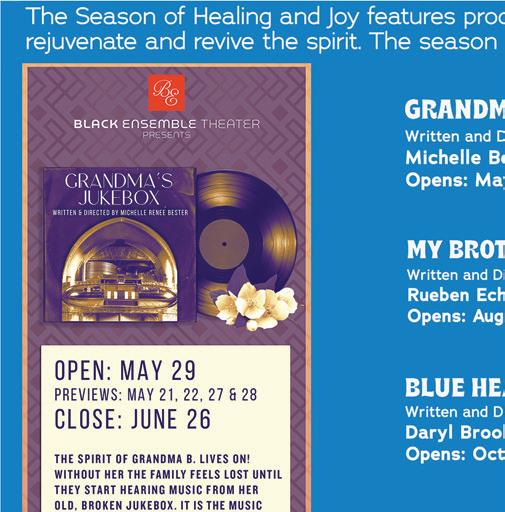





















MAY 26, 2022 - CHICAGO READER 27 A performing arts, visual arts, and other arts categories You can turn your life around, today If you are a young adult who started experimenting with alcohol or drugs and now find yourself unable to stop –feeling out of control, overwhelmed or hopeless – you never have to feel this way again. Discover is a life-changing addiction treatment program for young adults ages 18+, designed by the expert, clinical team at Recovery Centers of America. • Live with other young adults in semi-private rooms • Gender and age specific groups and workshops • Outdoor activity and gym time • Family therapy & support services AT ST . CHARLES Call Today: 331-422-4851 RECOVERYCENTERSOFAMERICA.COM/ST-CHARLES 24/7 Admissions • In-network with insurance • Family support services DRUG & ALCOHOL ADDICTION TREATMENT PROGRAM FOR YOUNG ADULTS 18+ To learn more about Blue Distinction, please visit www.bcbs.com or contact your Local Blue Plan.




28 CHICAGO READER - MAY 26, 2022 ll rmi a e a e i e enter 01 S. a e S re ri e Exhibit Hall Hours 150+ VENDORS 100+ SPEAKERS THE LARGEST CANNABIS INDUSTRY EVENT FOCUSED ON ILLINOIS! I C C LLINOIS ANNABIS ONVENTION THE necann.com/illinois Fri., June 10: 10 am-5 pm / Sat., June 11: 10 am-4 pm BOOTH SPACE AVAILABLE!







MAY 26, 2022 - CHICAGO READER 29 JUNE 10-11, 2022 McCORMICK PLACE LAKESIDE CENTER, 2301 S. LAKE SHORE DR. EXHIBIT HALL HOURS : Fri. 10am-5pm | Sat. 10am-4pm A FULL SPECTRUM CONVENTION For full information: necann.com/illinois SPEAKERS AND SESSIONS INCLUDE ... ... AND MUCH, MUCH MORE! I C C LLINOIS ANNABIS ONVENTION THE TWO FULL DAYS of B2B and consumer-facing programming DOZENS OF EXPERT SPEAKERS with practical knowledge and advice for attendees of all levels of experience and knowledge Advance purchase: $40/day, $70 weekend pass Cash only for tickets at the door. 18+ unless accompanied by an adult. Children under 18 with a parent/guardian do not need a ticket. OVER 100 EXHIBITORS BUSINESS • How To Create a Thriving Retail Environment that Delivers Consistent Satisfaction • R&D Tax Credits for the Cannabis Industry • Post-Application Crash Course: How to Execute Your Operational Plans for a Successful Launch • 4 Keys to Cannabis Tax Every CEO & Investor Should Understand • Cannabis Media: Successfully Landing Free Earned Media • FDA Enforcement: Adapt Your Marketing Strategy • Licensing Partnerships • Cybersecurity Priorities for the Cannabis Industry • License Strategy: Social Equity, Diversity, and Municipality Application • Patents and Trademarks in the Cannabis Industry CULTIVATION & PROCESSING • Living Soils: Incorporating Bene cial Biology • Fine Tuning Environmental Factors to Optimize Cannabis Crop Productivity • Breeding: Grandaddy Purple • Retailers Require Remarkable Reefer • Remediation Is For Losers • Tissue Culture • Upleveling Your Cannabis Processing Facility By Assessing the 8 Wastes of Lean • Di erentiation with Infused Products • Building a Compliant Facility • Happy, Healthy Indoor Cultivation INDUSTRY & INNOVATION • Cultivating a Career in Cannabis: Tips by Illinois Women in Cannabis • Building and Keeping Your Business Sustainable • Creating Space Through Collaboration In the Cannabis Ancillary Space • Sustainable Packaging • Cannabis Delivery: What Illinois Can Learn from MA, MI + CA • Supporting Social Equity Cannabusinesses • Beyond Diversity: Equity and Inclusion in Cannabis • Bringing Greater Social Equity to Illinois • Canna Tourism Is A Thing! Opportunities in a Booming Sector ADVOCACY & MEDICAL • Helping Families Navigate Alternative Medicine For Their Special Needs Children • Cannabis as Medicine • Discerning Best Practices for Working with Pediatric Medical Cannabis Patients • Fact or Fiction: Health Bene ts of Cannabis • Cannabis Access and Support for Veterans • Hey cannabis brands: Please stop using the words indica, sativa, and hybrid • How the Pandemic is Shaping the Cannabis Industry • Your Message: Designed By Demographic BOOTH SPACE AVAILABLE!
Through 6/ 12 : Wed-Sat 7: 30 PM, Sun 2 PM; Windy City Playhouse, 3014 W. Irving Park, teatrovista.org, $ 49 50 (Ten $15 Teatro for All tickets available each performance on first come, first served basis).
REVIEW
The incredible journey
His immigrant mom’s story (and The Wizard of Oz) inspires Brian Quijada’s new musical.
By KERRY REID
Six years ago, Brian Quijada and Teatro Vista teamed up to present Quijada’s solo show, Where Did We Sit on the Bus? , an endearing and poignant portrait of growing up in the Chicago suburbs as the child of Salvadoran immigrants. The title of that show came from a question young Brian had for his third-grade teacher after learning the story of Rosa Parks: Where did Brown people like his family fit into America’s history with race and oppression? His teacher’s response (“They weren’t around”) is emblematic of the erasure of Latine history from our cultural narrative. Quijada’s story, filled with hip-hop, loops, and poetry, combined his search to understand more about his heritage and his working-class parents’ struggles with his desire for his family to embrace his artistic dreams.
Now Teatro Vista returns to live performance under the new artistic leadership of Lorena Diaz and Wendy Mateo with the world premiere of Quijada’s latest, Somewhere Over
the Border . But this time, Quijada dives into the story of his mother and her dangerous crossing from El Salvador through Guatemala and Mexico to the U.S. in the late 1970s, just as the terrible civil war in her home country was ramping up. Using the framework of The Wizard of Oz and a score (also composed by Quijada) that combines cumbia, hip-hop, Mexican boleros, and pop, it’s an exhilarating, smart, and soulful show that wears its parallels to L. Frank Baum’s tale well. (Though it’s worth noting that Baum was a racist who called for the genocide of Native Americans.)
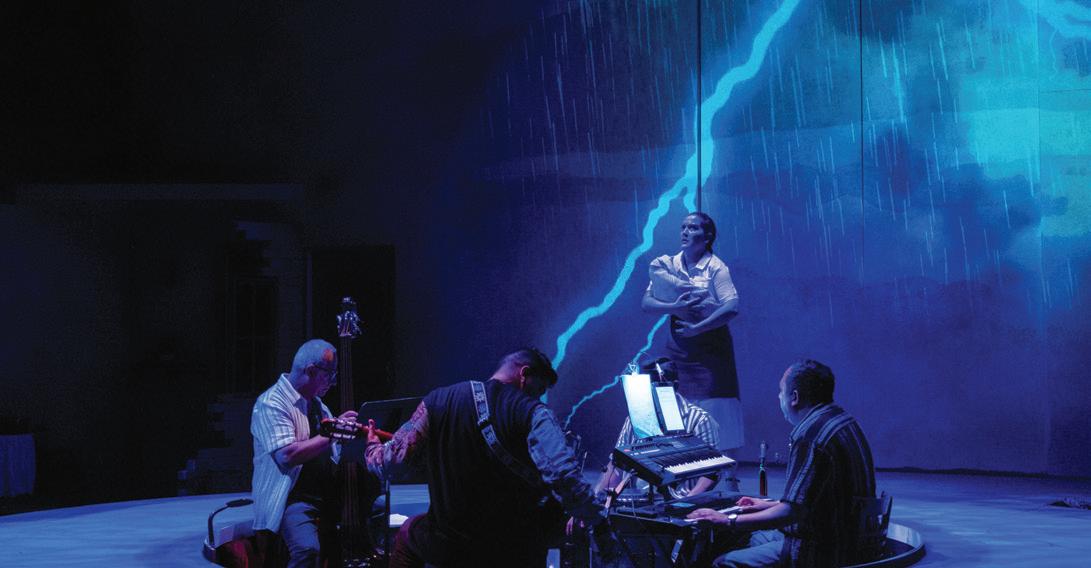
Reina (Gabriela Moscoso) is a 17-year-old single mother in Chanmico, El Salvador, living with her mother, Julia (Claudia Quesada), and her brothers, including good-natured Adán (Tommy Rivera-Vega). (As the narrator, Quijada points out, “It just so happens that father figures don’t figure into this story.”) As Reina struggles to work on the family farm and at multiple jobs in town, she dreams, as so many
immigrants have before her, of finding a better world in the U.S. for herself and her infant son, Fernando. When she finds out that she can pay a “coyote” 1,500 Mexican pesos for allegedly safe passage, she jumps at the chance, even though it means leaving her baby behind.
During her bus journeys to Tijuana, she meets a Mexican farmer, Cruz (Rivera-Vega), who wants to study advanced agricultural techniques; a brokenhearted innkeeper, Silvano (Andrés Enriquez), who decides to go in search of his wife and children in Pittsburgh; and a nun, Leona (Amanda Raquel Martinez), who really wants to be a rock star—if only she can summon up the courage to leave the convent. So you see where this is going.
They’re not so much easing on down the road as struggling to stay out of view of police and other o cials. And the final crossing itself provides a snapshot of just how fraught and traumatic the experience is. But Quijada’s musical, directed with fire and precision by
Denise Yvette Serna and filled with exuberant performances, also celebrates the same camaraderie of The Wiz. In its skillful reimagining of a familiar cinematic tale, it also reminded me of 16th Street Theater’s 2017 staging of Into the Beautiful North , Karen Zacarías’s adaptation of Chicagoan Luis Alberto Urrea’s novel about a young girl in Mexico whose town is being taken over by cartels. Inspired by multiple viewings of The Magnificent Seven , she decides to go north and find seven heroes to come back and kick some ass.
The combination of fantasy and reality plays out with joy and sometimes heartache in Quijada’s songs, played by himself (on guitar) and three other terrific musicians. (Thee Ricky Harris is music director.) Yvonne Miranda’s simple but evocative set features a stacking series of round platforms, with a pit in the center for the musicians and, yes, a yellow road painted on top, with the back wall illuminated by Liviu Pasare’s projections of rainbows and desert landscapes.
But the great gift of Quijada’s show is that it never loses itself in the Oz tropes. We see the similarities, of course—but what we mostly see are people desperate to find a way to live with dignity and pursue their dreams. There is hope, disappointment, uncertainty, and guilt for Reina. The latter mostly because she knows that she won’t see her little boy for a long time, and that she has left her own mother to raise Fernando amid the growing storm clouds of war and oppression. Quijada doesn’t delve deeply into the politics that tore his parents’ country apart. Instead, he lets Reina and her friends and family speak (and sing) for themselves.
The show opens and closes with “Everyday Towns,” a paean to the little places that people live in, and sometimes must leave in order to find peace and prosperity (though Reina’s story makes it clear that neither of those things is guaranteed even for those who survive the crossing). Somewhere Over the Border o ers one woman’s story, but the love and humor and warmth that Quijada brings to Reina’s tale stand as a defiant rejoinder to the xenophobic forces that dehumanize and criminalize Brown people at our border and in our own everyday towns. v
30 CHICAGO READER - MAY 26, 2022 ll THEATER
Somewhere Over the Border at Teatro Vista JOEL MAISONET
@kerryreid
R SOMEWHERE OVER THE BORDER







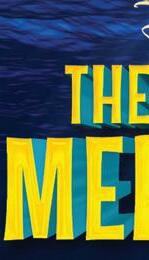
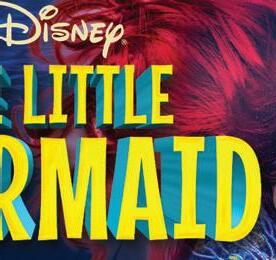
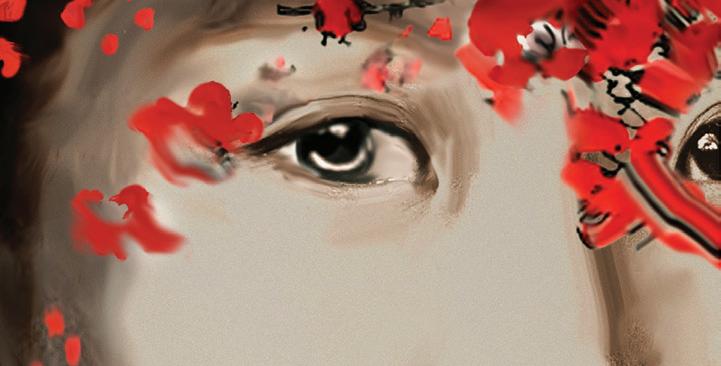











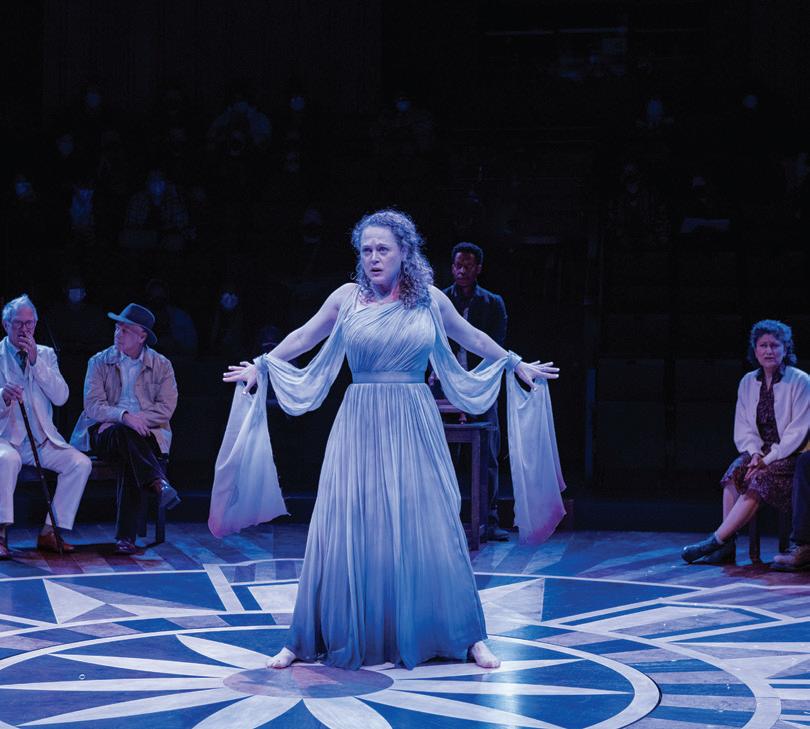
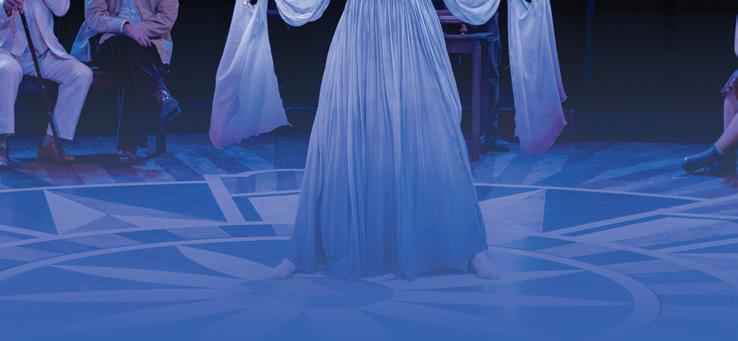



MAY 26, 2022 - CHICAGO READER 31 (847) 673-6300 WWW.MUSICTHEATERWORKS.COM JUNE 2, 2022JUNE 26, 2022 NOW PLAYING THROUGH JUNE 18 at Theater Wit, 1229 W. Belmont Ave, Chicago 773.281.8463 timelinetheatre.com CHICAGO PREMIERE BY LLOYD SUH DIRECTED BY HELEN YOUNG SEAGULL By Anton Chekhov Translated, adapted, and directed by ensemble member Yasen Peyankov Featuring ensemble members Sandra Marquez, Caroline Ne , Je Perry, Karen Rodriguez, Eric Simonson, and Namir Smallwood NOW THROUGH JUNE 12 Tickets start at $20 | steppenwolf.org | 312-335-1650 | steppenwolf.org/welcomeback 2021/22 GRAND BENEFACTORS 2021/22 BENEFACTORS PREMIER PRODUCTION SPONSOR “Contemporary and sharp….opens a lovely new space” – Chicago Reader “A showcase for the masterly acting that has distinguished the company for more than four decades” – Daily Herald “Ambitious and a revelation” – New City “Both the production itself and the theatre are remarkable” – Chicago On Stage
OPENING
R Tyrant times
Richard III comes alive in all his malevolence with Promethean.
Steve Scott directs a storefront production of Shakespeare’s wallow into the nature of unadorned power-lust and demagoguery. With a minimal set—a couple benches, steps with a recess to indicate the space for a throne—and little in the way of choreography or any other theatrical gimmickry, Promethean Theatre Ensemble leaves the Bard’s words to work their hard magic.
Cameron Feagin commands the stage in the titular role, playing Richard as a self-aware villain, profoundly flawed but unable to stop himself from conniving his way to the prize he’s convinced himself should be his, despite all evidence to the contrary.
Putting on a play about a tyrant at this moment may either be too on the nose or just timely, depending on your point of view, but in either case, I was moved listening to Feagin reciting words that simultaneously bring Richard his greatest triumph and seal his fate. The Richards of our time possess neither his self-awareness, nor are likely to get their just deserts, as he does. The rest of the cast acquits themselves just fine, but it is when Feagin speaks that the play comes alive. I sometimes wished it was a monologue because, like every monomaniac, Richard doesn’t truly see anyone else except for
how they may be of use to him. They’re all mere shadows next to his engulfing need for complete control. Evil is vanquished in Shakespeare’s play, but I didn’t walk out onto Howard Street feeling things would be OK. I don’t think I was meant to. There’s no way back from where Richard takes us.
—DMITRY SAMAROV RICHARD III
Through 6/25: Thu-Sat 7:30 PM, Sun 3 PM; Factory Theater, 1623 W. Howard, prometheantheatre.org, $30 ($25 seniors/$15 students).
Cruise control
Seven Days at Sea highlights the love lives of older women.
Margaret Knapp directs the world premiere of Martha Hansen’s first play (presented by Light and Sound Productions) about five women on an Alaskan cruise— each hoping to sight something other than a bunch of glaciers. Bailey (Hansen) is a chattering busybody looking for a first love late in life, Cora (Judi Schindler) is sliding into dementia and using the cruise as a last hurrah, Teresa (Millie Hurley) is freshly divorced and accompanying her cancer-survivor bestie, Audrey (Adrianne Cury), while cruise director Gloria (Stacie Doublin), there to make sure the ladies have a good time, winds up meeting some needs of her own.
These women are good company and the issues they grapple with ring true, but the structure of the play does them no favors. Comprised of what seem like

dozens of five-minute-or-less scenes, it’s as if Hansen is afraid her audience will get bored if she lingers or leans in too much. The stage set (designed by Michelle Lilly) is dominated by three beds, the middle of which is stowed away under the ship deck, then brought back out about ten times. During several of these changes, the poor stagehand tasked with handling the bed struggled to jam it behind the decorative panel. I mention this not to point out a bit of opening-night jitters, or a rough spot to iron out, but as an emblem of a piece of drama that’s trying too hard. As she writes in the program, Hansen wants to give voice to older women, who are o en not much heard from. She succeeds in that. Let’s hope next time she also lets them breathe a bit. —DMITRY SAMAROV SEVEN DAYS AT SEA Through 6/5: Thu-Sat 7 PM, Sun 3 PM; Edge Theater, 5451 N. Broadway, lightandsoundproductions.org, $40 ($30 seniors/$20 students).
R Diner dialogues
Two Trains Running gets a superb revival at Court.
This is an impeccable production of a play whose weaknesses outweigh its considerable strengths. It’s the 1960s episode of August Wilson’s Pittsburgh Cycle, tracing a century of life in the African American Hill District, and urban renewal shadows everything. (Jack Magaw’s set presents this vividly.) The diner where the play takes

place is nearly empty of customers but remains the community center for half a dozen men, each with his own fixed idea of how to get happy or rich or out of there. Their monologues suggest that the title’s “two trains” represent the material and spiritual worlds—the latter indomitable, while the former ebbs and flows in a pattern no one can understand.
So far, so fine. But as Chekhov says, if you bring a gun onstage in act one, you have to shoot it in act two. So Wilson’s decision to supply one character with an enormous gasoline can during a conversation about fire insurance seems ill-judged, unless this is a prose poem rather than a play. The happy ending is unearned. And the one woman (waitress Risa, played by Kierra Bunch) gets nothing to do and little to say: mostly she’s talked about instead of talking.
But nothing can undermine the ensemble’s superb work under Ron OJ Parson’s sensitive direction. A.C. Smith and Alfred H. Wilson, two of Chicago’s foremost interpreters of the playwright’s work, handle the famously iterative dialogue with their trademark fluency. They are first among equals in a cast which wears its awesome skill lightly. But special laurels for Joseph Primes, who manages to make two lines of dialogue endlessly repeated into an entire life story. —KELLY
KLEIMAN TWO TRAINS RUNNING Through 6/12: WedFri 7:30 PM, Sat-Sun 2 and 7:30 PM; Court Theatre, 5535 S. Ellis, 773-753-4472, courttheatre.org, $37.50$84. v
32 CHICAGO READER - MAY 26, 2022 ll
THEATER
Le : Richard III at Promethean Theatre Ensemble. Right: Two Trains Running at Court Theatre STEVEN TOWNSHEND (DISTANT ERA)/MICHAEL BROSILOW
Hit the Road
NOW PLAYING



RThe Bob’s Burgers Movie
The cinematic debut for the long-running animated series about a misfit family of restaurant owners brings all the quirks and quips of the original Bob’s Burgers, extending to a length that feels just about a perfect medium-rare without flaming out into a dry well-done.

Creator Loren Bouchard helms the flick, carrying the same o eat sensibilities fans have come to expect from the show. The cast all reprise their roles, as Bob (H. Jon Benjamin) and Linda Belcher (John Roberts) attempt to save their struggling burger joint from a devastating combination of late bank loans and a giant sinkhole containing a long-cold crime scene that opens directly in front of their entrance. With the—o en unrequested—help of their kids Tina (Dan Mintz), Louise (Kristen Schaal), and Gene (Eugene Mirman), the Belchers scheme up a series of last-ditch efforts to save their shop and even solve a murder.
Bouchard and collaborator Nora Smith pen a fast and witty script, leaving few breaths absent of side jokes and o anded puns. The pacing of the film drives straight forward, allowing for multiple side stories to coalesce in an entertaining conclusion that even novice viewers to the series will enjoy, while leaving enough room for inside jokes and witty fan service. —ADAM MULLINS-KHATIB PG-13, 102 min.
Chicken



















Josh Leong’s 13-minute short Chicken is meant to be a sympathetic look at incarcerated youth. But it does little to challenge carceral systems, instead acquiescing in the idea that it’s the people in prison who are broken, rather



than the system that has caged them.
The film features the convincingly anguished Jordan Biggs as a 16-year-old father incarcerated for a violent crime. The boy is a victim of domestic violence himself; he is locked in a cycle of abuse, unable to react with care and kindness, and unfit, he fears, to be a father. In prison he participates in a program in which the boys raise baby chicks. The hope and the promise of the film is that by caring for these animals, he will learn to care for his child and for himself.




Animal-care programs in prison are extremely worthwhile and valuable, not least because they recognize the humanity of those behind bars. But any discussion of prison needs to acknowledge that prison itself is part of a cycle of violence, not a solution to it. A scene in which a counselor (Opal Besson) tells the boy that he is “not trapped” seems especially tin-eared. She means that he isn’t doomed to hurt others, but she tells him so while he is literally in handcuffs. Physically, materially, he absolutely is trapped, and jailers are not in a position to offer bland promises of freedom.
I’m certain Leong means well, and the chick-raising program is a worthy cause. But prison is a massive, racist source of violence and harm. A film about incarcerated people, especially one purporting to advocate for them, needs to engage with that fact. —NOAH BERLATSKY 13 min. Screening at Tribeca Film Festival
RHit the Road
Being the son of the great Iranian dissident filmmaker Jafar Panahi and the protege of the late

master director Abbas Kiarostami can’t help but cast a shadow, but if this digressive and slyly weighty debut is any indication, Panah Panahi will have no trouble making his own voice heard.

A family of four drives through a forlorn countryside en route to connect with smugglers who will ferry their eldest son—in trouble for nameless reasons—out of the country. The traditional familial hierarchy is upended by the father’s immobility due to a full-leg cast. A philosophical bearded type, he spends much of the trip entertaining his younger son, when not staring aimlessly off into the distance. The desperately raging heart of the movie, the little boy, curious about everyone and everything, drives his family crazy while also distracting them from the heavy journey they’re on. The pain of the imminent separation is communicated wordlessly on the mother’s face.
I don’t know how Panahi manages to make this road trip neither heavy-handed nor derivative, but he’s found a new wrinkle to add to perhaps the oldest trope in film (and literature). By focusing on the mundane task of managing a little boy’s time and following the instructions of the smugglers hired to get their other son to safety, Panahi manages to keep the action moving without sliding into existential hand-wringing. Despite the very real darkness threatening to engulf this family, they know to keep moving ahead, no matter how unsettled the future looks through the windshield of their little car. I don’t know if they’ll be OK, but I’m glad to’ve been along for the ride. —DMITRY SAMAROV 93 min. Music Box Theatre v
Providing arts coverage in Chicago since 1971.










MAY 26, 2022 - CHICAGO READER 33
every
Find new film reviews
week at chicagoreader.com/movies FILM
chicagoreader.com
INTERVIEW
‘Let’s fuck up the frame’
By DONALD LIEBENSON
The Gene Siskel Film Center’s monthlong celebration of Chicago native Haskell Wexler’s centennial concludes May 31. You can still catch Francis Ford Coppola’s The Conversation and Hal Ashby’s Bound for Glory. Also screening before the month is out is Matewan (1987), Wexler’s first collaboration with director John Sayles, for which he was nominated for an Academy Award for Best Cinematography and was the recipient of an Independent Spirit Award.
Based on a true story, Matewan chronicles the violent 1920 confrontation between striking West Virginia coal miners and the mining company and its goons. Sayles learned about the incident while hitchhiking through Kentucky and was compelled to make the film following then-President Ronald Reagan’s move to bust the Professional Air Tra c Controllers Organization following their strike.
New York Times film critic Vincent Canby called Matewan a film “with the sweetness and simplicity of an Appalachian ballad . . . Haskell Wexler’s photography doesn’t go overboard in finding poetry in the images.”
Wexler, who died in 2015 at the age of 93, was a pioneering cinematographer, director, documentarian, and social activist. He won Academy Awards for Who’s Afraid of Virginia Woolf? and Bound for Glory . His directorial debut, Medium Cool, is an iconic Chicago film made amidst the 1968 Democratic Convention.
Following Matewan , Sayles and Wexler made three more films together: The Secret of Roan Inish (1994), Limbo (1999), and Silver City (2004). The Reader spoke to Sayles about their initial collaboration, which began with an unrelated phone call: Wexler sought Sayles’s advice and guidance concerning distributors he was considering for his own film, Latino.

Sayles recalls later leaving a message on Wexler’s answering machine: “We have this movie, Matewan . Would you be interested in shooting it?” The response arrived when Sayles was in West Virginia. “A woman at the desk said she had received a call from this character named Hacksaw who called from his car and he said, ‘Whatever these people want, tell them the answer is yes.’ He liked the script and came loaded for bear.”
Donald Liebenson: Before we get to Matewan and working with Haskell, you got your start writing scripts for Roger Corman. Did he mentor you in ways that would be helpful when you became a director?
John Sayles: Unlike writing for studios, there wasn’t a room of six to 12 people giving you notes and you wondering who you should actually listen to. So, as a writer for Roger, it was really just him and Francis Dole, his right-hand person and story editor. What I learned there was how to write a more cost-e ective script. Directors would say, “This scene is set at night instead of day, and that costs more.” Or they’d ask if I could give a line to a di erent actor to avoid carrying another actor as a weekly player even though they were scheduled for two days’ work. All those little tricks of the trade I learned working for Roger and the people who directed for him.
That must have come in handy for Matewan.
We had three-point-something million, which was a lot of money in those days. We had a union crew; there was more experience below the line. One thing Haskell talked me into that he had worked with and which was relatively new to me was the video assist. Before that, I had to wait until dailies [to see the footage]. I had to ask the camera operator, who actually had his eye to the lens, how the scene looked, and take their word for it. There was one point where Haskell noticed the extras were looking in the camera. What we were able to figure out was a lot of them were walleyed; no matter how you shot them, it looked like they were looking at the camera. With video assist, you can see when someone stares into the camera and ruins the shot. You don’t like to discover that three days later.
Haskell’s Oscar-winning reputation surely preceded him. What films of his made an impression on you and made you think of him for this project? You two seem like political kindred spirits, so I’m guessing Bound for Glory is one.
Bound for Glory and In the Heat of the Night. I saw Medium Cool in a theater in Washing-
May 28, 7 PM, Gene Siskel Film Center, 164 N. State. $12 general admission, $ 6 Film Center members
ton, D.C. The weekend it opened, there was a protest march against expanding the Vietnam War into Cambodia. Instead of going to get arrested, I decided to go see this movie I’d heard of. The tear gas from the streets of D.C. drifted into the theater.
That sounds like a William Castle gimmick! Matewan is a period piece. How did you two work together in determining how you wanted it to look?
Film had gotten very fast, so it was sharper. I didn’t want Matewan to look very Disney or old-fashioned MGM, where the colors pop. We didn’t want to pre-fog anything, which was a way of taking the edge o . The film is set 25 years before World War II, and very few color pictures exist even of WWII. What you can tell from early color pictures is there weren’t as many colors in those days. We made the decision to limit the amount of red you see in the movie. Haskell would use di usion in front of the lens. We were careful to have everything in the town and what the people were wearing look weathered and worn. This was a place where everything would have been covered in coal dust so everything that went in front of the camera was very faded.
Matewan has a gritty, documentary feel. Haskell made a lot of documentaries. He would always say, “Let’s fuck up the frame.” That meant an image looked a little too planned or choreographed. Even when it’s choreographed, you feel that in Robert Altman’s films, someone is likely to wander onto the screen that doesn’t feel like they belong there. You’re discovering a story inside this crowded frame.
Can you give an example of how your collaboration worked in capturing a specific image? I’m thinking of the scene that introduces David Strathairn’s sheriff.
Usually what I do is I give the cinematographer a list of every scene with a word or phrase, such as mysterious, exhilarating, tense. In that scene, David is walking at night parallel on a raised sidewalk to James Earl Jones’s character. I said I want him to appear like a nightmare to the Black man who knows he’s behind enemy lines, and at some point we need to see he’s wearing a badge to establish that he’s the law here. What Haskell did was make me some pools of light so David goes in and out of the
34 CHICAGO READER - MAY 26, 2022 ll MATEWAN
FILM
(1987) GENE SISKEL FILM CENTER
Matewan
Director John Sayles on working with Haskell Wexler
Were there ways in which his expertise helped you be more cost-effective?






The great thing about Haskell was we would scout locations and he would be able to say, “We should get here by nine because by noon we can’t shoot there anymore because there will be shadows.” So, we could plan our day where we felt we weren’t always racing the sun. Basically, I would say to Haskell, “We have 20 minutes to do this scene. Do the best you can.” He would do it and it would look good. That kind of experience and knowledge saves you so much wear and tear and so much wasted time where people are waiting who don’t have to wait.
On the Criterion Collection release of Matewan, Haskell says during your joint commentary that he was glad he was on this film with you. I imagine you feel the same way.

I’m the only fiction director who worked with Haskell four times. We worked out our way of working with each other. I always said to Haskell, “You’re probably going to bat below the Mendoza Line with only two out of ten suggestions you give me being ones I can or want to do. But I need you to keep telling me them; don’t get frustrated. We’re only getting what we need, and not what would be nice right now, but I need to keep hearing your ideas ’cause there’s going to be something I never would have thought of that’s going to be great to use.”


Was he OK with that?


He was fine with that, especially after he saw the movie. He was so relieved. He would often say, “I feel like we’re shooting the schedule, not the movie.” And I would say, “We’re doing both, Haskell. If we don’t shoot the schedule, we run out of money.” Then he saw the movie and he said, “Shit, it worked out.” v
@chicagoreader.com



















MAY 26, 2022 - CHICAGO READER 35 FILM GENESEE THE SPOTLIGHT IS CLOSER THAN YOU THINK THE 22_1082_GEN_Chicago_Reader_Ads_MAY_JT01Mod:April22,20229:12AMPrint:04/27/221:43:10PMpage1v7 203 NORTH GENESEE STREET, WAUKEGAN, IL BOX OFFICE HOURS: TUE – FRI 11 AM – 4 PM, SAT 10 AM – 2 PM TICKETMASTER: 800-982-2787 • PH: 847-263-6300 CAN'T MISS SHOWS! GENESEETHEATRE .COM Saturday, November 19 3:00 and 8:00 PM Thursday, September 29 7:30 PM Friday, May 20 8:00 PM Recommended for Mature Audiences Promoting the Artistic Cultures of Africa Control.Alt.Delete. THE_MATRIX/BLADE_RUNNER/HER/ THE_DAY_THE_EARTH_STOOD_STILL/ DESK_SET/METROPOLIS/ALPHAVILLE/ A.I._ARTIFICIALINTELLIGENCE+MORE June2-30 Sci-Fi+TechCinemaSeries siskelfilmcenter.org/controlaltdelete light and there’s enough of a kicker so that you also see light bouncing
badge.
o his shiny
Horsegirl and the dream of a teen rock scene
The trio’s new Matador album has made them the most visible members of a thriving musical and artistic community that’s still too young for most clubs.
By LEOR GALIL
In July 2019, Chicago indie-rock trio Horsegirl played the eighth annual Square Roots Festival. At the time, live shows were the only way to hear the group’s taut but disarming dream pop, with its windswept-lakefront sound—and they’d only performed a few of them. They hadn’t released any music, not even to stream, and unsurprisingly they’d received no press coverage at all. On the second day of the fest, Horsegirl took the stage in Maurer Hall as part of an afternoon block showcasing regulars from Old Town School of Folk Music’s monthly teen open mike.

The Square Roots poster didn’t name any of the teenage musicians at Maurer Hall that day,
but “Best of Teen Open Mic” might’ve been the most significant event of the festival. Horsegirl have since attracted flocks of dyed-in-thewool indie-rock fanatics. Sixteen months after Square Roots, in November 2020, Chicago Tribune music critic Britt Julious wrote the first major profile of the band. By the end of that year, they were getting national exposure. And in April 2021, Horsegirl signed to venerable indie label Matador Records.
That Square Roots set was significant to the members of Horsegirl too. Singer-guitarists Nora Cheng and Penelope Lowenstein and drummer Gigi Reece love decades-old underground rock that other kids their age consider obsolete: the Cleaners From
36 CHICAGO READER - MAY 26, 2022 ll
Horsegirl: Penelope Lowenstein, Nora Cheng, and Gigi Reece CHERYL DUNN
Venus, Sonic
HORSEGIRL, LIFEGUARD, FRIKO, POST OFFICE WINTER
Sun 6/5, 6 PM, Thalia Hall, 1807 S. Allport, $20-$35, all ages
Youth, the Clean (and basically all the Clean’s labelmates on New Zealand indie imprint Flying Nun). At Square Roots, Horsegirl first met Chicago four-piece Dwaal Troupe, whose imaginative, wide-screen rock recalls the whimsical psychedelia of the Elephant 6 collective at its mid-90s peak. “It was the first time we’d ever seen kids our age doing something that was similar to the stu we’d all bonded over watching videos from the past,” Nora says.
The admiration was mutual. “They were serious,” says Dwaal Troupe multiinstrumentalist Kai Slater. “We came in with banjos and really shitty guitars. And they came in with serious, like, Strats. I was like, ‘Wow, they know what they’re doing. This sounds like Sonic Youth.’”
For the Square Roots set, Horsegirl filled out their sound by recruiting their friend Asher Case on bass. For a few months Asher had been jamming with Penelope’s younger brother, Isaac, in a noisy project they’d name Lifeguard, and Horsegirl invited Isaac to sit in on drums for a song too. After the set, this extended Horsegirl crew chatted briefly with Dwaal Troupe about the indie bands they all like, then parted ways. Penelope realized they’d missed an opportunity only after she and her friends had left Maurer Hall.
“We were like, ‘Oh, we should have gotten those guys’ numbers,’” she says. “‘What are we going to do? We just lost them forever.’ And then from a distance, Asher was like, ‘Oh my God, there’s Dwaal Troupe,’ and called them over. We were like, ‘OK, we need to get your number.’”
A few weeks later, Asher and Isaac brought Kai into Lifeguard, making the group a trio. A new Chicago indie-rock scene, small but mighty, began to take shape, full of musicians who aren’t old enough to drink. (Friko front man Niko Kapetan, who helped engineer Horsegirl’s breakout 2020 single, “Ballroom Dance Scene,” is an exception at 22.) Within a year or so, this loose group of friends began referring to themselves as “Hallogallo kids.” In early 2021, Kai published the first issue of a zine documenting what they were all doing. He called it Hallogallo too.
This little scene has managed to flourish despite the pandemic, which has rearranged many of the musicians’ creative and interpersonal lives. In fact, a later addition to the scene’s roster of bands arguably owes its existence to 2020’s period of social distancing: Charlie Johnston of Dwaal Troupe, who teamed up with her friend and neighbor Will
Hu man in the shaggy, folky duo Post O ce Winter, started collaborating with him that fall in part because their bubbles overlapped and they had access to a garage where they could practice with the door open.
The Hallogallo community has been a boon to Hu man too. “I personally would not have been pursuing the same things in music that I’m currently pursuing if not for meeting them,” he says. “It just felt out of reach.”
The larger world has also taken notice of the Hallogallo scene. Lifeguard have issued two seven-inches through Chunklet Industries, the Georgia indie label that grew out of Chunklet, Henry Owings’s irreverent music and culture magazine. And the weekend of July 8, two Hallogallo bands will play at top-tier Chicago street festivals—Friko at West Fest, Dwaal Troupe at Square Roots (this time by name).
The biggest band to break out of the scene has been Horsegirl. In July 2021, they sold out a show at Schubas; two months later, they kicked o Saturday’s Green Stage lineup at the Pitchfork Music Festival. On Sunday, June 5, Horsegirl will headline Thalia Hall to celebrate their first full-length album, Versions of Modern Performance . It’ll be Penelope’s second milestone in 12 hours, since she’s graduating from Jones College Prep earlier that day.
Horsegirl want to bring their friends along for the ride too. Lifeguard played that Schubas show last year, and they’ll join Friko and Post O ce Winter as support on Horsegirl’s recordrelease show. When I ask Horsegirl what they wanted to say with Versions of Modern Performance, Gigi recalls how the band bonded with Dwaal Troupe. “We wanted to express all these feelings of, like, that excitement we felt when we found out Kai liked all the same music as us,” Gigi says. “We wanted to express the feeling of, like—that young people can make cool things.”
Horsegirl formed in spring 2019. Nora, Penelope, and Gigi became friends in part by going to DIY shows together. In November 2018, Nora invited Penelope and Gigi to a warehouse gig headlined by six-piece fusion group Corn on My Dinner Plate; Penelope and Nora got a ride from Penelope’s mom. “All these people were older than us—we didn’t know anybody,” Gigi says. “We thought that was really cool. All three of us were like, ‘We want to continue to pursue going to these things.’ The way that it made all three of us feel at the same time was awesome.”
Nora, Penelope, and Gigi were a band, in a way, even before they became Horsegirl. “We

Post Office Winter Lifeguard
were in this crazy, intense friendship, where we thought that the exact same stu was so cool—we were sending each other old videos, reading Kim Gordon’s book religiously, and becoming obsessed with all this music,” Penelope says. “We hadn’t really met other kids who are now in our scene—like all the Hallogallo people—and we sort of felt alone in that vision.”

As a musical project, Horsegirl started as just Penelope and Nora. “I’ve had moments where I listen to really early voice memos of me and Nora just messing around,” Penelope says. “It’s crazy because I realized we had a vision from the start of, like, what we thought was super cool, and what we wanted to do with our voices together. It sounds so much like the songs we’ve written recently.”
They had a less clear idea of how far they’d
take Horsegirl. “When you start as a high school band, you never have the expectation that you would ever be serious,” Penelope says.
“When you read that Chicago Tribune article, that was before we realized this was something that we could keep doing,” Nora says. “It’s kind of like, ‘Inevitably, it’s doomed.’”
Nora, Penelope, and Gigi all had musical backgrounds years long by the time they started their band together. Penelope learned guitar at the Old Town School of Folk Music; both she and Nora went to Girls Rock! Chicago camps, but they never crossed paths. All three Horsegirl members, when they were between 12 and 15 years old, got interested in the School of Rock. “It’s kind of how we met so many of our friends in high
MAY 26, 2022 - CHICAGO READER 37
Lifeguard: Asher Case, Kai Slater, and Isaac Lowenstein CARLOS LOWENSTEIN
Post Offi ce Winter: Charlie Johnston and Will Huff man COURTESY THE ARTIST
from 37
school,” Gigi says.
Many Hallogallo kids participated in one of those three programs too. Charlie Johnston, who’s a junior in high school now, attended the Old Town School’s summer camp at age eight. “I was assigned ukulele and I was like, ‘I literally could not care less about whatever this is,’” she says. “And then I totally loved it, and continued it.”
Charlie stuck with the Old Town School’s summer programming, graduating to the teen program when she turned 11. She met the three other future members of Dwaal Troupe through the program: Kai Slater when she was 12, then Francis Brazas and Desi Kaercher the following year. “We were all, like, weirder and more quirky for our age,” Charlie says. “We gravitated towards each other. We didn’t go to the same school, but we saw each other through Old Town.”
In April 2019, not long after Kai turned 14, he and Francis started recording sketches of songs on a four-track in the garage attic of Francis’s Homewood house. “We were like, ‘We want to do more than just random things we’re hitting, like, with sticks and guitars,’” Kai says. They brought in Charlie and Desi to form Dwaal Troupe, and Kai and Charlie would often rent a practice space at the Old Town School to write and record. Dwaal Troupe played live only two or three times before the fateful Square Roots gig that summer.
Kai remembers that show as where Asher invited him to join Lifeguard. “They’re like, ‘Me and Isaac have been ri ng some things, and we need a singer-guitarist,’” Kai says. “I was like, ‘Oh, yeah.’ Because they were on fire. That summer is very important. Very big stu happened.”
Asher Case and Isaac Lowenstein met through the School of Rock in 2019.
Asher befriended the members of Horsegirl the same way, but Isaac was closer to Asher’s age—Nora, Penelope, and Gigi are a few years older. “I was happy that me and Isaac were of similar ages and could actually talk and hang out,” Asher says. “When we met, we were talking about Tortoise a lot. We were really into TNT and Standards. It was interesting to meet someone who was also into Tortoise when I was 11.”
As Penelope got involved in what became Horsegirl that spring, Isaac saw what his sister had and wanted something similar for himself. “I remember being pretty jealous of Penelope now having this outlet to make her
own music,” he says. “I was like, ‘Wow, I really want to do that.’ When I met Asher, it felt like I could get that—and Penelope definitely wanted to support me through that.”
Asher and Isaac jammed together for a couple months. “We wrote two songs, and we didn’t play any shows,” Asher says. “It was very low-stakes, and we were just hanging out. It was fun—we’d watch movies and play music.”
There was only so much Asher and Isaac could do as a bass-and-drums duo. Once Kai began playing with them in August, Lifeguard became a more serious concern. They wrote enough songs for their debut EP, In Silence , which they recorded at Electrical Audio with veteran engineer Jeremy Lemos in February
Friko
I manage that?”
Being separated from his friends during the week was hard for Kai even before COVID-19. The pandemic added new complications. “I dropped out of high school when it was, like, virtual,” he says. “I was like, ‘This is not beneficial to either my mental health or my mental progress.’ I guess it wasn’t clear if I was going to go back or not. But I was like, ‘Fuck this, I cannot do this.’”
The members of Horsegirl found a silver lining in the challenges of remote schooling. Nora, Penelope, and Gigi all attended di erent high schools, but they could be in the same room when they sat in virtual classes on their computers.
“My mom’s o ce is where we would be, because nobody was there,” Gigi says. “We would sit in this little back room in her o ce . . . ”
“And order Korean fried chicken,” Penelope adds.
It was cold and uncomfortable, they say, but being in a bubble with their best friends made up for a lot.
Charlie Johnston didn’t see her bandmates in Dwaal Troupe for at least a month after the start of Chicago’s pandemic lockdown. But she could hang out with Will Hu man, who lived about a block away. At first they maintained the recommended six-foot distance, but then they found a solution that was close enough to being outdoors to work for them. “We’d hang out in her garage with the door open so it was ventilated,” Will says.
Charlie and Will would often share music they liked—both are big fans of lo-fi Rochester indie rocker Kitchen. In fall 2020, they wrote their first song together. “It doesn’t need to be an o cial thing to write a song with someone,” Charlie says. “But then we really liked the idea of, like, putting a name to the project.”
2020 and released before the end of the month. Isaac, Asher, and Kai, riding that momentum, decided to spend a weekend in March writing and recording a ten-minute song, “Tin Man,” which features guest vocals from Penelope. They put it out just as Illinois began implementing its first COVID-19 shutdown.
By the time the pandemic hit, Kai had developed a strange band-life balance. In fall 2019, he started his freshman year of high school in Ann Arbor, where his father lives. After school, he’d beaver away on demos he’d later bring to Dwaal Troupe; every weekend, he’d take a Greyhound bus to Chicago to practice with Lifeguard. “I don’t know how I did that,” Kai says. “How did
“Honestly, if COVID didn’t happen, I don’t really know if Post Office Winter would be a thing,” Will says.
Niko Kapetan grew up in Evanston and started playing in bands as a middle school student—mostly he’d do cover songs at block parties. He began writing and recording his own material in high school and put together a throwback pop combo called Thee Marquees. “I felt like it was starting to become, like, ‘Music is something that I definitely want to do when I get out of high school,’” Niko says.
Not all of his bandmates in Thee Marquees were on the same page. After Niko graduated in spring 2018, the group only stayed together

38 CHICAGO READER - MAY 26, 2022 ll
continued
Friko: Luke Stamos, Bailey Minzenberger, and Niko Kapetan NANDO ESPINOSA HERRERA




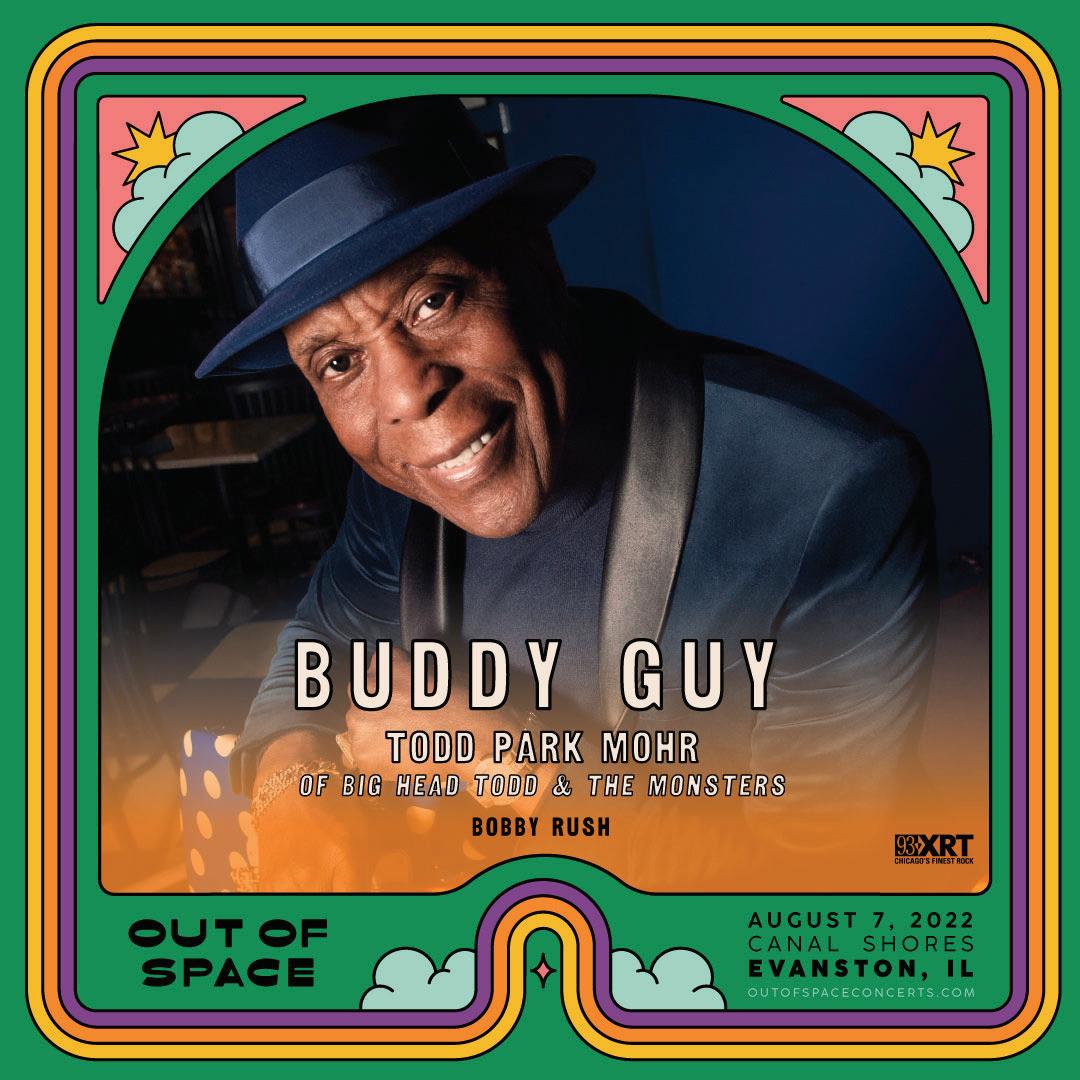

MAY 26, 2022 - CHICAGO READER 39 THALIA HALL 1807 S. ALLPORT ST. PILSEN, USA | THALIAHALLCHICAGO.COM BONNY LIGHT HORSEMAN vv lightbody 6 ~ 22 CORINNE BAILEY RAE malia 7 ~ 5 TY SEGALL & FREEDOM BAND bill mackay 7 ~ 1 6 9 6 21 6 23 6 ◊ 24 6 25 6 14 POLIÇA wilsen MUNICIPAL WASTE integrity, bewitcher THE FLY HONEYS LA FEMME trance farmer 6 17 PRATEEK KUHAD laura elliot 7 2 7 8 7 7 LETTERS LIVE! with PEPPERMINT DANIEL VILLARREAL, ANTELOPER, JEREMIAH CHIU & MARTA SOFIA HONE BOB MOULD BAND melkbelly 6 6 6 8 ALOK SYD HORSEGIRL lifeguard, friko, post o ce winter 6 5 SIGN UP FOR OUR WEEKLY NEWSLETTER! $5 W/ RSVP CAJUN DANCE PARTY FEAT. THE MID-CITY ACES 1035 N WESTERN AVE CHICAGO IL WWW.EMPTYBOTTLE.COM 773.276.3600 $5 W/ RSVP CAJUN DANCE PARTY FEAT. THE MID-CITY ACES FRI-SUN 06/03-05 SAT 05/28 EBP EMPTY BOTTLE PRESENTS FRI 05/27 SUN 06/05 FREE 6/6: ASÍ ASÍ (FREE), 6/7: TRAITRS, 6/8: VARIOUS DISTRACTIONS (FREE), 6/9: ABYSS CHASERS, 6/10: BLUE HAWAII, 6/11: SCORCHED TUNDRA PRESENTS MINSK, 6/12: SHARON SILVA & RENO CRUZ, 6/13: BOTTLED UP (FREE), 6/16 @ IMSS: EMPTY BOTTLE PRESENTS CS + KREME, 6/16: RADIOACTIVITY, 6/17: GLITTER CREEPS PRESENTS ABSOLUTELY NOT (FINAL SHOW), 6/19: MORE KICKS, 6/21: BOBBY OROZA, 6/22: LOS BITCHOS, 6/23: JERRY PAPER, 6/25: FLASHER, 6/27: LOLLYGAGGER (FREE), 6/29: LIILY, 7/1: LADY WRAY, 7/2: VISION VIDEO, 7/3: SCORCHED TUNDRA PRESENTS STEVE VON TILL, 7/5: PUBLIC MEMORY NEW ON SALE: 6/15: YATRA, 7/31: SHAMIR, 8/19: ONEIDA • BITCHIN BAJAS, 9/20: PORRIDGE RADIO SAT 06/04 MON 05/30 SUN 05/29 TUE 05/31 WED 06/01 FRI 06/03 A PLACE TO BURY STRANGERS GLOVE • GANSER WE ARE SCIENTISTS PINK MOUNTAINTOPS ASHLEY SHADOW HARD COUNTRY HONKY TONK WITH THE HOYLE BROTHERS 5PM - FREE THE BODY MIDWIFE • RXM REALITY 12PM-FREE HANDMADE MARKET “SMITHS NIGHT AT DANNY’S” AT EMPTY BOTTLE GRAY CENTER PRESENTS ICEAGE CAFE RACER A PLACE TO BURY STRANGERS GLOVE • GANSER @ DAMEN AVE & DIVISION ST. DO-DIVISION 2022 FEAT. NNAMDI • TUNE YARDS • TORRES CADENCE WEAPON • ANJIMILE • EXUM + MORE! DO DIVISION AFTERPARTY TORRES DO DIVISION AFTERPARTY TUNE YARDS ANJIMILE
for about another year—long enough to finish a demo collection called Burnout Beautiful , which Niko released in July 2019. By that point, he’d enrolled in Columbia College’s music program and then dropped out. (He now works in a warehouse for Music Direct.) To satisfy his drive to make music, Niko poured his energy into a new project called Friko, where he’s joined by bassist Luke Stamos (formerly of Thee Marquees) and drummer Bailey Minzenberger.

Before the pandemic hit, Friko booked a handful of shows at DIY spaces and a November 2019 Martyrs’ gig. The members of Horsegirl happened to attend the latter, and they invited Friko to play a Shuga Records in-store with them in January 2020. There, Niko heard Horsegirl perform “Ballroom Dance Scene” and o ered to record the song in his parents’ basement in Evanston. The band took him up on it, though by then COVID had arrived—they all wore masks while working with Niko and his co-engineer, Jack Lickerman.
Horsegirl introduced Niko to the other Hallo gallo bands too. “When we hung out, it just made sense, musically,” Niko says. “I hadn’t really met anybody in Evanston—other than the people who I played with—that shared the same interest, like that realm of musical taste or passion to make music in the same way.”
“Ballroom Dance Scene” came out in November 2020 as the title track of Horsegirl’s three-song debut EP. Among its instant fans was Eli Schmitt, who’d moved to Chicago from Indianapolis earlier that fall to attend DePaul. Eli hosts a Radio DePaul show called Mother Night Radio Hour , and shortly after that Horsegirl EP dropped, Eli played “Ballroom Dance Scene” in a set dedicated to emerging local acts. In spring 2021 he met Nora, Gigi, and Penelope at an art show and invited them to an informal vinyl-listening session at his apartment.


Eli calls those sessions Record Club, and since the first one in May 2021, they’ve become regular events. He also books DIY shows and makes flyers for them; he publishes a zine called Unresolved; and he hosts a video series called New Now, recording live sets by local bands in his apartment. Earlier this year he started learning drums so he could play live with Post O ce Winter.
Record Club might be the most important thing Eli does for the scene he loves, though. It’s given his friends a place where they can build community.
“I know we met a lot of people through that,” Asher says. “Eli would foster those relationships in his home, which is so beautiful and nice of him to do. As Record Club started happening more, and as it started becoming a thing that you didn’t have to ask your friends if they were going—that’s when the scene started.”
As early as summer 2019, Kai Slater started thinking of a way to celebrate this community. At one point he envisioned a festival to showcase its emerging bands and spin-o s (including Sublime Jupiter Snake Duo, his electronic project with Desi Kaercher of Dwaal Troupe), because he thought organizing a fest would be more manageable than making a zine. “I didn’t realize that the whole point of zines is that, you know, anyone can make a zine,” he says.
The first issue of Kai’s Hallogallo zine arrived as the scene built momentum in early 2021. “By the time I did the first issue, it was like, ‘We have music out, and we want to spread the message,’” he says. “It felt like there was a real material purpose—material not in, like, materialistic gains, but in the sense that it was an actual, feasible thing to spread the message about. Like, here, everyone in the world could find this and access it.”
“I think that’s when people started connecting to the idea of, like, Hallogallo is us, and it’s a zine,” Isaac says. “It’s not exclusive, and it’s not a club. It’s just a way that we can see what everyone’s making.”
This past March, Kickstand Productions assistant talent buyer Bridget Stiebris booked her first show at Beat Kitchen—the venue o ered her Wednesday, April 6, and she had her eye on Dwaal Troupe and the larger Hallogallo scene. “The other thing I wanted to do, and still want to do the more I book, is that I want to make these spaces a little more than just a place to have a local show,” Bridget says. “Making something an event, or a fest, or something involving zines, for instance—the idea of making something more of a place to make a community event rather than ‘Oh, here’s another three bands’ has always been interesting to me.”
Bridget reached out to Kai, and together they turned their dream into Hallogallo Fest. Lifeguard, Dwaal Troupe, and Post Office Winter performed, and teen zinesters and artists sold their wares by the entrance to the Beat Kitchen live room. Kai rolled out the fifth issue of Hallogallo , which includes lengthy interviews with Circuit des Yeux mastermind
Haley Fohr and Kleenex Girl Wonder bandleader Graham Smith. He’ll have the sixth issue, which features a conversation with Mac DeMarco, ready to sell at Horsegirl’s recordrelease show—where he’ll be joined by at least a dozen other zinesters.
“For the Thalia show, we wanted the zine-selling aspect,” Gigi says. “But on this huge scale of, like, every kid ever can just be selling their zine at our show. We are so happy to have that and get the word out for them.”
Crucial to the thriving Hallogallo scene is the support of the parents involved. Charlie’s parents, for example, rearranged their garage so she could have a ventilated practice space for Dwaal Troupe and Post Office Winter. Several Hallogallo parents also make music in some capacity, and they often seem almost as excited as their kids about the teen scene growing up around them.
Will’s father, Eric, has composed music for video games and for Lookingglass Theatre Company. Penelope and Isaac’s dad, Carlos Lowenstein, has a home studio where he makes experimental modular-synth recordings as Sun Picture. He’s released solo cassettes through Chicago label Trouble in Mind, as has Asher’s dad, Brian Case, who also fronts postpunk group Facs. In March, Facs headlined Metro and brought along Lifeguard as one of their opening bands.
“I know that this is not normal—that in most places you don’t have a band of 18-year-
olds getting signed to Matador Records and doing all this cool stu , and that your parents are punk idols,” Eli says. “That makes me all the more fortunate and all the more hungry to do the things that I do, ’cause I know how lucky I am to have found this.”
The members of Horsegirl know how special their scene is too—and Nora and Gigi may be feeling that especially keenly because they moved away for college last fall. (They’re both in New York, attending NYU and the New School, respectively.) They both travel back to Chicago whenever they can, and on a return trip in April they shot a video for “Dirtbag Transformation (Still Dirty).”
Horsegirl recruited Dwaal Troupe, Lifeguard, Friko, and Post O ce Winter to play along to the song in the auditorium of Penelope’s old elementary school, Near North Montessori.
On Versions of Modern Performance, Horsegirl don’t make obvious nods to their hometown, but as the “Dirtbag Transformation” video demonstrates, their hearts are still here. You don’t have to look far to see how much Chicago—and their scene specifically—means to them.
“Everything we do, is, like, ‘We are kids from Chicago,’” Gigi says.
Penelope agrees. “We don’t feel like we could have formed this band if we were living somewhere else.” v
40 CHICAGO READER - MAY 26, 2022 ll
continued from 38
@imLeor
Horsegirl cover art: their debut album, Versions of Modern Performance (le ), their November 2020 debut EP (upper right), and their November 2021 Matador single “Billy”

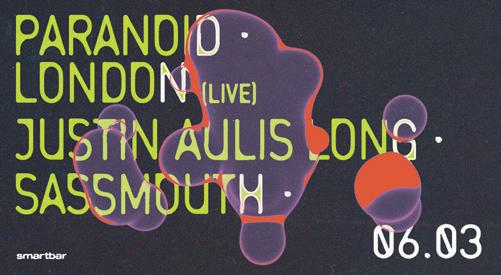





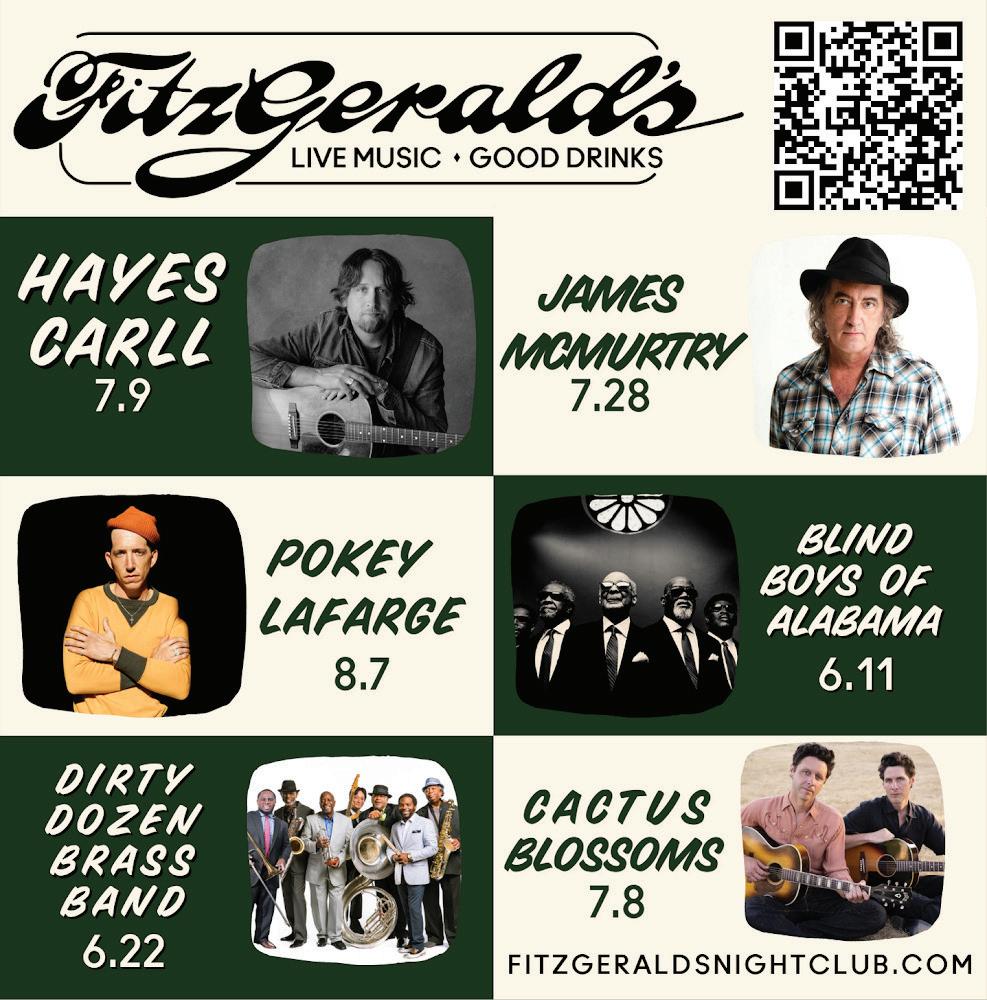
MAY 26, 2022 - CHICAGO READER 41 3730 N CLARK ST METROCHICAGO.COM @METROCHICAGO SMARTBARCHICAGO.COM 3730 N CLARK ST | 21+ FRIDAY JUNE 10 NDATL MUSIK presents KAI ALCE CHEZ DAMIER DAMON LAMAR FRIDAY MAY 27 DFA Take Over ft. JAMES MURPHY JUAN MACLEAN PAT MAHONEY NANCY WHANG SATURDAY MAY 28 DFA Take Over ft. JAMES MURPHY 2MANYDJS / TRAXX FRIDAY MAY 27 / 7PM / 18+ GRABBY AWARDS AMERICA Hosted by Chi Chi LaRue + Honey West Presented by Just For Fans SATURDAY MAY 28 / 6:30PM / 18+ DAVID 75: THE STELLAR STAGES OF A FUTURE LEGEND SONS OF THE SILENT AGE Michael Shannon / Jason Narducy and Friends play T. Rex SUNDAY MAY 29 / 6:30PM / 18+ AN ALL-BUILDING EVENT MEMORIAL DAY EVE QUEEN! ft. Plack Blague and more! MONDAY MAY 30 / 8PM / 18+ THE STROKES A Concert for Kina Collins SATURDAY MAY 28 / 11:30PM / 21+ FURBALL: IML with DJ sets by Tony Moran + Bobby Duron FRI JUN 03 SON LUX + Sen Morimoto + Kiah Victoria SON LUX DEHD SUPERCHUNK EMMIT FENN MANSIONAIR POST ANIMAL PACHANGA TO THE MOON JUN 03 JUN 04 JUN 06 JUN 08 JUN 09 JUN 10 JUN 11 Laid Back | Cold Beer | Live Music @GMANTAVERN GMANTAVERN.COM 3740 N CLARK ST 21+ THU JUN 09 RESCHEDULED DATE MANSIONAIR MON JUN 06 RESCHEDULED DATE SUPERCHUNK WED JUN 08 EMMIT FENN + ayokay
MUSIC
Paul Natkin, concert photographer

Chicago native Paul Natkin is a prolific concert and portrait photographer who’s shot more than 4,300 musicians and celebrities since he started his career in 1975. He’s also worked as road manager for the likes of Brian Wilson and Alice Peacock and tour photographer for the Rolling Stones. His images have appeared in so many publications (including the Reader) and on so many album covers that music fans have almost certainly seen his work, whether they know it or not. This summer, Natkin will publish his first book, The Moment of Truth (Trope), which collects some of his favorite photos and the stories behind them.
Iused to work in a photo lab, a place called Gamma, which is a big photo lab in Chicago. My father, Robert Natkin, was a brilliant photographer back in the 40s and 50s after World War II. When I was born, he got out of the photography business, but he got into it again in the 70s. The first job that he got was from a friend of his who worked for this team of basketball players who were just starting out called the Chicago Bulls. You could walk up to the box o ce for any game all season long and get really good tickets for $2—nobody was going to the games because nobody cared about basketball.
[My father’s friend] told him, “I’ll give you a pass. You can go in and shoot whatever you want. If we like your work, we’ll buy it from you.” I was 21 years old and still living with my parents. I had no idea what I wanted to do with my life. I had dropped out of college, because I only went to college to stay out of the draft and not get sent to Vietnam.
When my father told me about his new job, he included four really important points: One, free parking. Two, get into the game for free. Three, free hot meal in the press box. Four, best seats in the house. I looked at him and said, “I want to be a photographer.” So he got
me a pass and took me to the next game.
I’m five foot two, standing with a bunch of guys that were like two feet taller than me, right on the court. It was like a dream come true, but not in my wildest dreams did I ever think that I could actually make money in photography. It was just a way to go and see basketball games for free.
I did that for about four years. My father got tired of it, but I’d still go, and I met all these other photographers. They all kept on saying, “If you want to come and shoot some tennis matches or come to a Bears game or a Cubs game, we’ll get you in.” So all of a sudden, I’m standing on the sidelines with Walter Payton at Soldier Field. I’m in the dugout at Wrigley Field before a Cubs game. And I’m shooting tennis matches all over the city where I’m sitting right on the court next to the net.
There’s a point to this story, by the way. I was shooting a tennis match up at Northwestern University. It was over around 6:30 in the evening. So I went back to my car, which I’d parked a couple of blocks away. There was a commercial on the radio for a concert. And I couldn’t make this up if I tried—the concert was taking place in one hour, five feet away from where I was sitting in the lot, at the Cahn Auditorium on the Northwestern campus. The bumper of my car was touching the side of the building. The performer was a singer and guitarist that I had just barely heard of by the name of Bonnie Raitt.
I figured, I’d been able to BS my way into almost any sporting event in the city of Chicago; let’s see if I could BS my way into a concert. How hard could it be? I quickly made up a huge lie that I was working for this new magazine called Rolling Stone. Before I could say a word, the security guy looked at the camera equipment hanging around my neck and said, “Oh, you’re with the press. Just go in and do whatever you want—just don’t get onstage.”
These days you could go to Schubas and you’d still have to have a letter from the pope to get in with a camera. I walked in and I shot a bunch of pictures. They were terrible, I’ve gotta admit. It was tremendous fun, but I still had no idea how I could earn a living doing it.
There was a venue near my house called the Ivanhoe Theater, that’s now a Binny’s. I
42 CHICAGO READER - MAY 26, 2022 ll
Paul Natkin
TOM MADAY
CHICAGOANS OF NOTE
been able to BS my way into almost any sporting event in the city of Chicago; let’s see if I could BS my way into a concert. How hard could it be?”
“I’d
As told to JAMIE LUDWIG
just took my cameras and walked over there one day. I figured if it worked for Bonnie Raitt, maybe it would work here. I walked up to the back door and I met a security guy who was equally as short as I was. We kind of bonded over that, and we started talking, and he said, “Yeah, just go in and take some pictures.”
I started going there two or three times a week. I’d always make the security guy an eight-by-ten print and bring it the next time I went. I shot people like Kenny Rogers, Dolly Parton, and Tom Petty & the Heartbreakers. Cheech and Chong. It didn’t matter who it was. The security guy, Scott Gelman, worked for Jam Productions. I was talking to him one day when he called this guy over from the other side of the room. It was the manager of the Ivanhoe. Scotty said, “Hey, this guy’s really nice. We should just give him a pass and let him come in anytime he wants.” The guy went back to the office and came back with this button that you pinned to your shirt that said “Ivanhoe Sta .” I didn’t even have to walk in
the back door anymore.
[Another] day Scotty calls this other guy over. The guy’s name was Jerry Mickelson, one of the owners of Jam Productions. Scotty turned to him and said, “You should let him into all of our shows all over the city of Chicago.” And Jerry said, “Sure. I’ll tell you what—if you give us free pictures, I’ll let you into all of our shows. No problem.”
That was better than winning the lottery. All of a sudden I was shooting at Park West, the Vic, the Riviera, the Aragon, the Uptown Theatre, the Chicago Stadium, the Rosemont Horizon (which is now the Allstate Arena). I was shooting on average—and this is no exaggeration—five nights a week. At about five o’clock in the afternoon, I’d pick up the Reader—I always had a copy at my house—I’d go to Section Three, and I’d look through the ads of who was playing that night. And I would just get in my car and go.
I still had no idea how to earn a living, but I was acquiring this tremendous collection
of pictures. One day I was at Park West, and I walked out in the lobby and saw a friend of mine, a lawyer from Detroit, standing there talking to this guy. He turned out to be the art director and photo editor for Creem magazine. He said, “Call me on the 15th and I’ll give you a list of everybody we’re doing articles on for the next issue. The deal is you submit pictures. There’s no guarantee, but if we like ’em, we’ll use ’em. And we’ll pay you.” At that point I had already shot maybe 100 di erent musicians. He sent the list on the 15th and I’d shot one musician on it: Rick Derringer, who wrote the song “Rock and Roll, Hoochie Koo.” I sent him a bunch of pictures, and he used one full-page color. I’m thinking, “I’m gonna be rich. This is the greatest thing in the world.” About a week later, I got the pictures back, and in the envelope there was a check for $35.
So I came up with a new plan. I went to 7-Eleven and I bought a copy of every magazine on the newsstand that had to do with music and piled them up at my house. I took
the top one, opened it up, found out who the photo editor was, and started calling until I got ahold of him. My goal was to sell three or four pictures a month to ten di erent magazines for $35 to $50 a picture.
It worked. All of a sudden I was shooting heavy metal bands and getting them into Circus and Hit Parader. I was shooting teen idols like David Cassidy and Rick Springfield and getting them into 16 magazine and Teen Beat And I was making $300 to $400 a month. I was still working at the photo lab, so I was getting all my film processed for nothing. It was starting to look promising.
The turning point was when publicists started calling me and saying, “Hey, I saw your pictures of so-and-so in Creem magazine. They’re one of our artists, and they’re coming back to town.” I came to the conclusion: I’m not just gonna ask for access to the shows. I want to do portraits backstage, either casual or set up with lights and backdrops and the whole deal.


MAY 26, 2022 - CHICAGO READER 43
Mavis Staples at Paul Natkin’s home studio on May 11, 1989 PAUL NATKIN
MUSIC
Atlas Genius at House of Blues Chicago on March 5, 2013. “It’s the most perfect rock ’n’ roll picture that I ever took in my life,” Natkin says. PAUL NATKIN
All of a sudden, the quantity and quality of my work went up. That was the basis of the beginning of my career.
When a band plays in New York or LA, there are 50 photographers in front of the stage. But when they played Chicago, at least back in the 70s and 80s, I was the only photographer there. I knew every security guy in front of the stage. I knew all the people at the back door. I’d bring a chair from backstage and put my camera bag on it, so I didn’t have to bend over to change lenses. I’d bring a sandwich and a drink from catering backstage, and I was at home. You couldn’t do that anywhere else in the world.

The list of people that I’ve photographed in my life just passed 4,300 names. I’ll get calls from somebody in say, New York, at 4 PM asking, “Did you ever shoot a band called ‘blank’ in 1985?” If I shot them, I can find the pictures in under 30 seconds. And then I’ll end up with, like, a rerelease album cover and a check from a record company.
Let’s back up for a second. In 1977, I went to the Auditorium Theatre to shoot Muddy Waters for Jam Productions. There was another photographer there who said, “I’m shooting for the Reader .” Then something happened right as the show started, and he got kicked out. I’m thinking, “Here’s my opportunity to get pictures in the Reader.”
So I went home, developed the film, and stayed up all night making prints. I washed them, and I dried them by putting ’em on the dashboard of my car and driving. I walked into the Reader o ce and I said, “Hey, I was at a concert last night and saw your guy get kicked out. I have these pictures. Do you think you might want ’em?” They ran a couple of them, and they paid more than Creem magazine.
So I became the Reader music photographer. I did it for many years, and it was a really lucrative way to earn a living. But eventually, all those budgets dried up and the clients disappeared.
These days with the Web I get an email every two weeks. It’s almost like they just copy the same email, because the first paragraph starts with, “We really love the pictures you took of so-and-so. It would go perfectly in the project that we’re working on right now.” And the second paragraph starts out with, “Unfortunately, we don’t have a budget and we’d like your permission to use them for free.”
I always say the same thing to people: “You don’t have to pay me a thousand dollars, but you have to pay me something. It could be $20. But if you write me a check for $20, that means that you respect my work enough to pay for it.” Most times they’ll write me a check, but if they don’t, they don’t get my work.
I don’t go to a lot of concerts these days, but I photograph a lot of bands now that most people have never heard of. If a band catches
my eye, I will request a photo shoot and access to shoot their whole show. I would rather do that than—to use a photographer friend as an example, he’ll go shoot someone like Billie Eilish, and they’ll treat him like total dog crap and make him shoot from the soundboard. After three songs, they kick the photographers out of the building, and everybody gets the same bad pictures. And nobody buys them, because there are some good pictures floating around of her by people that she lets shoot correctly. I always ask my friend, “Why are you bothering? Why are you wasting gas?” And he’s starting to agree.
Every once in a while, I interact with a band on the subject. The first time it happened was with the Jesus Lizard, back when they were big the first time around. They had a fairly big record on Capitol, and a magazine sent ’em over to my house to do a photo shoot.
Usually what happens is that somebody will wander into the kitchen and open up the refrigerator—there’s always beer in there—so everybody grabs a beer and we all sit around and talk. And David Yow, the singer, asks, “Why is it that as soon as our show starts getting really good, all the photographers leave?” I looked at him and said, “Because you’ve told

44 CHICAGO READER - MAY 26, 2022 ll
continued from 43
MUSIC
Paul Natkin’s most famous concert photo: Ozzy Osbourne and Randy Rhoads at the Rosemont Horizon on January 24, 1982. Rhoads died less than two months later in a plane crash. PAUL NATKIN
The Beastie Boys were photographed while on tour in Chicago to support their 1986 debut album, License to Ill . Their local date was at the Aragon Ballroom on March 13, 1987. PAUL NATKIN
To photograph Miles Davis at Park West on February 6, 1983 (also for the Reader), Natkin kneeled on the fl oor for a two-and-a-half-hour set—Davis kept his back to the audience for almost the entire night.

Joan Jett played the Thirsty Whale in River Grove while fi lming the movie Light of Day on April 7, 1986.
 PAUL NATKIN
PAUL NATKIN
them to leave.” He said, “No, we haven’t.” And I told him every band on the road in America tells photographers to leave after three songs. He said, “Well, how can we change that?”
About a month later, they left to tour with Lollapalooza. They were the first band on the bill every day. I went to the show out in Tinley Park, and at the box office there was a note with my pass that says, “You’re only allowed to shoot the first three songs of every show, every band, except for the Jesus Lizard, who has requested that everybody shoot their whole show.”
I got great pictures. I called my friend Ebet [Roberts], who does what I do in New York, which is where Lollapalooza is heading. I told her to make sure to go to the show early because the first band on the bill is from Chicago, and they’re gonna let everybody shoot the whole show.
There’s a point to this story too. She was working for this little publication called the New York Times. During the last song of their set, David grabbed a microphone and dove o the stage right over her head. The audience caught him and held him over their heads as he was laying on his back singing. She took a picture of it, and it made the front page of the New York Times. All because he asked me that question after he grabbed a beer out of my refrigerator during our photo shoot.
My book’s coming out in July. It’s got 300 pages—almost all pictures, with a little bit of text. I got a couple of friends of mine to write little articles about me. One was written by Steve Gorman, who was the original drummer of the Black Crowes, which is the most eloquent article about me I’ve ever seen in my life. There are stories behind some of the pictures that are in the book. How do you explain Motörhead sitting in McDonald’s eating hamburgers? How do you explain Joan Jett in a heavy metal band in red spandex with spiked-out hair without knowing the story?
The only advice I’d give people who are interested in doing this today is to sell all your equipment before it gets beat up. There’s absolutely no way that you could be successful shooting pictures of bands in 2022 and not have to have a day job, because of two things:
One, nobody will give you access. They’ll give you really bad access, if they give you any at all. Two, magazines don’t pay enough.
But I would never tell anyone not to try, because I wouldn’t want to spoil somebody’s dreams. I’ll illustrate this with a story. There was once this new band called Fall Out Boy. They had their first album out, and they were on the Vans Warped Tour. I got a call from Chicago magazine. Somebody had written an article about them because they’re from the North Shore, and the magazine gave me the number of the publicist at the record company.
I called her up to ask to be allowed to shoot the whole show. She asked me the one question that just makes me cringe: “Have you ever worked in the music business before?” She’d never had anyone ask her to shoot the whole set. So I went around and around with her, and I said, “Here’s my Web address. Have a look at my work, and I’ll call you a couple days before the show.”
Two days before the show I called her up, and she said, “I can’t do anything for you, but I’ll give you the number of the road manager.” It was a 708 number. So I called and told the guy who I was, and all I hear is silence at the other end of the line. Then he says, “Oh my God, I’ve wanted to meet you for like ten years now.”

So I told him what I wanted and he said, “Of course you can shoot the whole show. Why don’t you come in the morning and hang out on our bus all day long? Anytime you want to do a photo shoot with the band, just gather them up, take them outside, and shoot whatever you want.”
I did four separate photo shoots with them during the course of the day, and I shot the whole show for Chicago magazine. It was gonna be a two-page article, and they were gonna use two pictures—one in the table of contents, one in the article. It ended up being a four-page article with five pictures. And they paid me double what they were gonna pay me.
The following Monday, I got a call from the publicist, who said, “Hey, I heard you shot the whole show. Can we buy some pictures from you?” v @unlistenmusic
MAY 26, 2022 - CHICAGO READER 45
MUSIC
Top: Paul Natkin’s fi rst Reader photo was Muddy Waters at the Auditorium Theatre on March 17, 1977.
The Devil Bell Hippies:

Chicago’s greatest avantgarde band that only kind of exists
Martin Billheimer helped create a special sort of chaos that involves anyone who says they’re a member— more an idea than an actual ensemble.
By STEVE KRAKOW
Since 2004 Plastic Crimewave (aka Steve Krakow) has used the Secret History of Chicago Music to shine a light on worthy artists with Chicago ties who’ve been forgotten, underrated, or never noticed in the first place.
When I finished college downstate and moved to the Windy City in 1995, the Chicago no-wave scene was breaking apart. While still in school, I’d often driven three hours to catch gigs here, and after my move I caught the last shows by local no-wave stars the Scissor Girls and Lake of Dracula.
The original no-wave scene, born in New York in the late 70s, was a confrontational avant-garde movement whose bands used lots of clattery dissonance, and in a nod to that precedent, the Windy City scene was sometimes called “Chicago no wave,” “now wave,” or simply “new no wave.” When the CD compilation Chicken Bomb dropped in 1996, coreleased by the Lumpen Times, it put Chicago no wave in context by juxtaposing young locals
(including lesser-known groups such as Xerobot and Monitor Radio) with influential New York no wavers James Chance & the Contortions and international skronkers Dog Faced Hermans. It also seemed like a headstone for the scene.
Scenes don’t just wink out of existence, of course, and the likes of Metalux, the Flying Luttenbachers, and Bride of No No continued to carry a torch for noisy, abrasive not-exactlyrock music. (The scuzzy freak-out bands I played in at the time shared bills with all of them.) With the possible exception of the groups led by Zeek Sheck (I once saw her with an insanely huge ensemble at 6Odum), none were more shambolic and confounding than the Devil Bell Hippies—though they’re barely even a band and have never been part of any
real scene. They’ve existed for nearly 40 years without becoming any easier to define.
“There is no real lineup per se, never has been. Anyone can join. We’ve had countless members,” says cofounder Martin Billheimer. “Just say you’re in and you’re in. We might even play a show again someday. . . . Members are contacted by secret communiqué. The main obligation is spiritual.”
Billheimer was born in 1970 in Uptown, and when he was still a child his family moved to the industrial city of Bradford in Yorkshire, England. At age 11, they returned to the Windy City, and Billheimer soon found his musical calling. “The Devil Bell Hippies started when I was 13, in 1983, by me and my best friend at the time, Scott Brewer, in Albany Park,” he says. “The whole mess just grew on from there, at-
tracting members like a Danish attracts flies.” While attending Lincoln Park High, Billheimer developed antifascist leanings and got deeply into punk. He also met fellow malcontents on the same path, including future Devil Bell Hippies member Eric Colin Reidelberger. “We were two of maybe seven kids that were into punk rock in our school,” Reidelberger recalls. Billheimer soon dropped out of high school and went to work, taking jobs as a dishwasher, house painter, construction worker, and furniture mover.
Billheimer’s band concept drew from a wide variety of subcultural sources: he mentions sword-and-sorcery movies and kung-fu matinees at the city’s long-gone downtown movie houses, as well as early-80s hardcore (MDC, Verbal Abuse, Earth A.D. -era Misfits). The
46 CHICAGO READER - MAY 26, 2022 ll
STEVE KRAKOW
MUSIC
HISTORY OF CHICAGO MUSIC
SECRET
Devil Bell Hippies also liked late-70s industrial music (SPK, Throbbing Gristle), though they saw it as unintentionally funny in its self-seriousness.
“We were influenced by Bowie, Culturcide, old horror movies on Son of Svengoolie, Weekly World News , by anti-Nazi and pro-communist sentiments . . . but most of all, by the dreary landscape of north-side Chicago and its gang mythology,” Billheimer says. “The band was then a mishmash of obscure references to north-side lore, played on acoustic guitar and bongos and kitchen pots. We made Jad Fair look like King Crimson in comparison. A hideous thrift-store din . . . at least early on. Later, we got people who could (kinda) play.”
Reidelberger never played any shows with the band, but he recorded with them frequently in those larval years. “I was banging and howling away on some of the earlier cassettes,” he says. “My memories of DBH were basically making cassettes at Martin’s house with Scott, and peppering the recordings with our in-jokes and anything that we found funny, including bell-bottoms—hence the name. This would have been 1984 and ’85. I do remember being encouraged to not be musical. Our approach was very Throbbing Gristle-esque.”
The Hippies’ first proper gig was at a WZRD benefit in 1986, and they had some pretty impressive company: Ono, the E gies, Naked Raygun. They played for just ten minutes, but part of their set made it onto the 1987 Panic Records compilation What Is Truth? , alongside material by weirdo luminaries Eugene Chadbourne and Phil Minton.
“Panic Records was our pal Scott Marshall, who was at WZRD with our other friends,” Billheimer says. “He was the first person to play our first demo, Hellish Hot Bros, recorded in 1984, which had 247 ‘songs’ on it. He was deeply impressed with its barbaric simplicity. This was all mail-order.”
“Early on, we recruited members of the legendary punk band Silver Abuse. That changed things utterly,” Billheimer says. William Meehan would become a consistent member of the Devil Bell Hippies, and Dave Purdie got involved too. “We garbage-picked the percussion—old barrels and toilets, et cetera—which really helped the beat.” Meehan and Marshall, his bandmate in noise group Burden of Friendship, both played with the Hippies at that 1986 WZRD benefit; Marshall added what Billheimer calls “ridiculous synthy drums.”
The Devil Bell Hippies have issued the vast majority of their releases themselves, but Panic Records also put out a self-titled DBH
cassette in 1987. “I think several of them even got ordered,” Billheimer jokes. “Most of our releases were live recordings. Weasel got us a few sessions at small studios, and those are the best-recorded ones (this was in the early and mid-1990s).”
The aforementioned Weasel is selfdescribed “brutal prog” purveyor Weasel Walter, whose past and current bands include the Flying Luttenbachers, Lake of Dracula, Behold the Arctopus, Cellular Chaos, and Lydia Lunch Retrovirus. He encountered the Devil Bell Hippies in the early 90s and soon got involved. “Martin Billheimer is a genius—he’s the no-wave James Joyce,” Walter says. “I first saw them in 1993 and it blew my mind. I think the first gig I saw was at the Double Door, and it was utterly hilarious. There were about ten people onstage, all in stupid outfits, out of their minds. It was like Animal House meets early Half Japanese. The club wasn’t pleased. I doubt they played the straight venues twice— ever. I saw them play all the small dumps over the 90s.”
Despite the extreme flexibility of the DBH lineup, the collective has passed through distinct eras during its long history. William Meehan from Silver Abuse colored the band’s sound strongly in the 80s, and around 1990, several of Billheimer’s friends from Indiana joined—at about the same time as they came to Chicago and formed the grungy metal band Wicker Man. “For the next ten years or so, they played most of the gigs,” Billheimer says. “At that point, we started to have loads of guest musicians and really anyone could join. It got more and more chaotic. There were a few gigs that even I didn’t play. Weasel joined about 1993 and gave us a renaissance indeed. Very important, the Weasel Era. He is still in the band.”
Walter has helped organize the Devil Bell Hippies’ unwieldy discography for the beginnings of a proper Discogs page, cataloging their many DIY cassettes of bizarre noise, field recordings, spoken-word rants, sound collages, and overloaded instrumental attacks. He’s also made detailed notes of the dates, venues, and lineups of many of their shows. In his entry for a Lounge Ax gig in 1996, I notice Tye Coon, lead singer of underappreciated noiserock band Hog Lady.
“My shit is all in order—they were just into chaos,” Walter says. “I neither claim to be a member or expert, just a fan.”
Walter’s notes for a show at Roby’s on April 4, 2000, read as follows: “Duc de Zima (vacuum cleaner), Bosco Necronomicon (elec-
tric mandolin), Sean Carney (keyboard), ‘Mike’ (vocal, poetry), E-ROL (drums, etc). Laundry Room Squelchers, Cock E.S.P., Stagecoach, and Metalux also appeared.” I was at this gig, but appropriately, I barely remember it.
A few months later, at the Fireside Bowl on July 30, 2000, the Devil Bell Hippies brought a different crowd: “Erazmus Khan the Kruel (TV), Bosco Necronomicon (mandolin), Bronco Asmodeus (beer), Duc de Zima (vo-kills, CD player), Martin of Billheimer (metal), Keith Poseurslaughter (metal), a guy (guitar), Johnny Sweet (synth). Songs included ‘Pile of Poseurs’ and ‘Soapy’s Revenge.’”
Walter describes an especially absurd DBH set at the Congress Theater, which his band Vanilla (sort of a sarcastic throwback heavy-metal outfit) had rented for a Halloween show. “About 50 people showed up, and that place is big—it was ridiculous,” he says. “The Hippies were insane that night, big stage, big sound, total mayhem. Martin had gone out and rolled around in muddy water or something before he hit the stage. It was like a satanic southern preacher.”
In the late 90s, as Walter remembers it, the band’s momentum faltered—it seemed like most of the folks involved were simply losing interest. “I actually did a Hippies gig where I was the only person who showed up!” he says. “It was just me dancing around with a blanket and some random guy playing trombone sometimes.”
I could fill several articles this length with gonzo stories about DBH gigs, so I’ll stop with just one more. “DBH got into a brawl with these guys in a very silly band called the Electric Hellfire Club at a Whitehouse show at the Empty Bottle,” Billheimer says. “Can’t remember why it started . . . they were being assholes, we probably were too. It stopped the show, and I was pretty drunk and can’t remember much of it. Nobody got really hurt, aside from a couple bloody noses.
“The next day, our bass player Phil (aka Bronco Asmodeus) brought Peter Sotos and William Bennett from Whitehouse into where I worked at the time (Rose Records downtown, a job I had for about two weeks), and we all laughed about it. Bennett managed to get his finger broken in the melee—I think someone fell on him onstage—and he had it in a splint. But they seemed really happy that their music was still able to provoke violence. A few weeks later, the Electric Hellfire Club sent word that we should all stop feuding and unite to worship Satan, which I thought was pretty funny.”
By now, you surely understand that the Devil Bell Hippies were more than a band, or less than a band, or something not quite a band. “Performance art” seems too lofty a term for their aggressively weird, othe-hook underground happenings, but there isn’t really a better one. When I ask Billheimer what makes the group’s sound special, he says, “The appalling lack of cohesion and utter lack of the musical element in music.”
That’s not to say that some of the folks joining the demented party weren’t respected musicians in other contexts. “We picked up musicians who later made other bands, people who could actually play or were good at faking it,” Billheimer says. “We had special guests: Ron Holzner from Trouble played a TV set once, and we recorded with a fabulous opera singer who called herself Madame Iron Butterfly.”
Billheimer’s high school friend Kevin Junior, later the leader of classy orchestral-pop band the Chamber Strings, even played gigs with the Hippies. “There were so many people,” Billheimer says. “Sometimes a couple of us would show up and recruit band members from whatever dopes were hanging around the club or bar.”
Last year Billheimer published the historical book Mother Chicago: Truant Dreams and Specters Over the Gilded Age , which he describes as “unearthing the crimes of capitalism via neighborhood legends, occult street lore, and the psychology of walking around this city in its new feudal psychological landscape.” Despite his new status as an author, he insists that the Hippies have never broken up. “Devil Bell Hippies is more than a legend, it is a name,” he says. “We return sporadically. No one notices either our appearances or absences—and this is the key to real integrity. Like in Zen, you know?”
Billheimer further claims that a new Devil Bell Hippies recording is in the works, to be titled Pig State Pigs . “It has me, Keith [Pastrick] from Wicker Man, Sally Smmit (the old Hangahar soundtrack nom de guerre of Sally Timms, which she doubtless wishes to retain), and is being finished very slowly,” he says. “I have about half kinda done, and it will be of epic length. Lockdown music. Wanna play on it?”
I just might. v
The radio version of the Secret History of Chicago Music airs on Outside the Loop on WGN Radio 720 AM, Saturdays at 5 AM with host Mike Stephen.
MAY 26, 2022 - CHICAGO READER 47
MUSIC
MUSIC
Chicago indie sensations Dehd go big-time with Blue Skies
DEHD, PIXEL GRIP, 81355 (BLESS)
Sat 6/4, 9 PM, Metro, 3730 N. Clark, $24, $21 in advance. 18+
CHICAGO TRIO DEHD SOUND LIKE they’re trying to levitate by fusing the ine able but often incompatible powers of frigid postpunk and wispy indie rock. Dehd are dedicated minimalists: their lonesome, echoing guitars and sturdy, straightforward rhythms tend to show the seams in their songs, but they don’t reveal too much of the magic that makes them work. Dehd get some of their charm from the worn-in, skeletal feel of their music, which leaves little to distract you from the vocal interplay between bassist Emily Kempf and guitarist Jason Balla—both of whom seem to write killer pop hooks as o andedly as they might doodle in a notebook. On Dehd’s new fourth album, Blue Skies (Fat Possum), the band play around with their sound ever so slightly: on the spiky, upbeat “Bop” and swaying ballad “Memories,” drummer Eric McGrady augments his blunt beats with sharp snatches of electronic percussion. For the most part, though, Dehd stick with what’s served them well since they formed six years ago, putting that bare-bones formula to work making bittersweet songs that can wallop like Top 40 radio hits with six producers. On the single “Bad Love,” Kempf leans into the majestic yearning of McGrady’s galloping drums and Balla’s dreamy, looping guitar with a focused, triumphant performance that showcases her vocal range—if there’s one moment that crystallizes the band’s flair for dramatically bridging joy and sorrow, it’s Kempf’s wordless, strained howl at the song’s end. —LEOR GALIL
CONCERT PREVIEWS FRIDAY27
Deftones Gojira and Vowws open. 7 PM, Huntington Bank Pavilion at Northerly Island, 1300 S. Linn White, $38-$79. b
Even though the ongoing reappraisal of nu metal has recognized that era as a significant cultural moment, Sacramento band De ones still manage to catch a bad rap. Sure, they came up as part of the same movement as Korn and Limp Bizkit, and they toyed with some dated, aggro rap-rock on a couple songs in their early days—minor infractions that forever saddled them with the nu-metal label. But the only people who can actually complain about the band have never really listened to them. De ones play a sort of hybrid of alternative metal and dream pop, sounding like Helmet fronted by Morrissey or the moody love child of Faith No More and the Cure.

Deftones have even nodded to shoegaze and postrock: “Cherry Waves” (off 2006’s Saturday Night Wrist) is just as creamy and heart-wrenching as anything My Bloody Valentine has ever released, while “Mascara” (off 1998’s classic Around the Fur ) could pass for a lost Slint demo. Hell, if De ones’ 1998 single “Be Quiet and Drive” had picked up a bit more airplay upon its release, it could have usurped “Everlong” as 90s radio rock’s most ubiquitous post-shoegaze emotional banger. Deftones have attempted a slight reinvention with each of their records—on 2000’s White Pony they got moody and dynamic, and on 2016’s Gore they added some djent-inspired eight-string guitar. But they’ve never strayed too far from the formula that’s made them one of rock’s most enduring and consistent bands—groovy, absolutely slamming rhythms; incredibly heavy, chunky guitars; swaths of dreamy synths and sound design; and Chino Moreno’s gorgeous, crooning vocals. Their latest record, Ohms, released smack-dab in the middle of the pandemic, streamlines all De ones’ signature moves into their most stripped-down and direct set of songs in years.
—LUCA CIMARUSTI
MaKaya McCraven See also Sat 5/28. Jeremy Cunningham & Dustin Laurenzi open. 9 PM, Lincoln Hall, 2424 N. Lincoln, $25, $20 in advance. 18+
Drummer Makaya McCraven has always been a bit of a rabble-rouser. He mixes audio from his live gigs with studio overdubs in intricately layered tracks that feel like jazz approached with a DJ’s sensibility. Like McCraven’s 2020 Gil Scott-Heron tribute, We’re New Again (XL Recordings), last year’s Deciphering the Message remixes snippets from a source outside his band—this time the he y catalog of Blue Note Records, one of the towering tastemakers of jazz, with a special focus on material by Art Blakey’s Jazz Messengers. Blue Note also released Deciphering , making McCraven the first Chicagoan in more than a decade to sign to the legacy jazz label. The album follows in the footsteps of other sample-happy Blue Note experiments from the 1990s and 2000s (Madlib’s Shades of Blue, for
48 CHICAGO READER - MAY 26, 2022 ll
THE
PICK OF
WEEK
of May 26
Recommended and notable shows and releases with critics’ insights for
the week
b ALL AGES F
Dehd: Eric McGrady, Emily Kempf, and Jason Balla ATIBA JEFFERSON
example, or the label-released compilation The New Groove ). For Deciphering the Message , McCraven selected Blue Note tracks and diced them up, shuffling them into new grooves often animated by terse supporting motifs. “Autumn in New York,” derived from guitarist Kenny Burrell’s version of the standard off Blue Lights (1958), trades balladic sweep for a skipping soliloquy based on a petite guitar motif, and McCraven’s take on Horace Silver’s “Ecaroh” builds a funky pyramid from the pianist’s chromatic hook. At his upcoming shows at Lincoln Hall, McCraven will riff on tracks from Deciphering as well as from his back catalog, accompanied by five of his seven compatriots from the album: bassist Junius Paul, saxophonists Greg Ward and De’Sean Jones, trumpeter Marquis Hill, and guitarist Matt Gold. Think of them as remixing the remixes— all live and always a surprise.
—HANNAH EDGAR
Pelt See also Sat 5/28. Part of Transference Fest, presented by WNUR. Evie the Cool headlines;
Carinae, Pelt, and Morinda open. 7:30 PM, SPACE, 1245 Chicago Ave., Evanston, $15. b
As we navigated shutdowns and venue closures throughout 2020, many of us observed that time seemed to slow down. But when it comes to dilating time, COVID-19 is a rank dabbler compared to Pelt. Even in their early incarnation as a Sonic Youth-inspired noise-rock band based in Blacksburg, West Virginia, they were prone to sludgy tempos. After the combo dropped rock forms in favor of open-ended improvisation, their penchant for fusing the keening sonorities of Appalachian old-time fiddling with the endless drones of early American minimalists La Monte Young, Tony Conrad, and Terry Riley earned them an honorific: the Hillbilly Theatre of Eternal Music. The effect of their bowed strings, groaning harmonium, drizzling piano, and tolling metal percussion is to make it seem as though time has evaporated, and the quartet (currently multi-instrumentalists Mike Gangloff, Mikel Dimmick, Nathan Bowles, and Pat Best, who are
spread across four states) can go years without playing a concert. Nonetheless, Pelt have their own peculiar life cycle—they o en emerge from hibernation in response to a summons from a music festival. In April, Pelt played for the first time in five years at an event celebrating the 20th anniversary of Three Lobed Recordings, which last year released their fantastic LP Reticence/Resistance. Duly awakened, Pelt now return to Chicago for the first time since 2011 to play two concerts. On Thursday, the group will perform at SPACE as part of WNUR’s Transference Fest. On Friday, they’ll headline the Hideout; for the opening set, Bowles and local guitarist Bill MacKay will belatedly celebrate their debut LP, Keys , released last year by Chicago-based label Drag City. If Pelt’s music taps into the cosmic beyond, the reflective guitar-and-banjo instrumentals and gospel vocal numbers on Keys quietly but resoundingly affirm traditional musical values.
—BILL MEYER
Racetraitor Si Dios Quiere, Terminal Nation, Midwestlust, and Sarin open. 8 PM, Cobra Lounge, 235 N. Ashland, $15. 17+
A er Chicago political hardcore powerhouse Racetraitor disbanded in 1999, a fog of legend grew in their wake. Motivated by their frustration at the bilious 2016 presidential campaign cycle and the fury and urgency of the burgeoning Black Lives Matter movement, the band reemerged with a fiery reunion a couple weeks before the election, but they didn’t have plans for it to be an ongoing thing. The members felt they had moved on to other things, and they had mixed feelings about their old project. “Racetraitor is a band we were proud of, but not an easy one to live in,” front man Mani Mostofi told the Reader’s Kevin Warwick. “It was never a popular band, and about half the people that remember it do so because of how much they hated us.”
Six years later, Racetraitor are still going strong. During the Trump years, they gave us two EPs, and 2018’s 2042 (Good Fight) is a brutal, brilliant album that packs a lot of two-fisted wisdom into its short running time. In 2020 they also organized a massive compilation album with almost 50 artists across multiple underground genres (Shut It Down: Benefi t for the Movement for Black Lives) and released a self-titled split EP with Neckbeard Deathcamp, Closet Witch, and Haggathorn. Racetraitor present a fascinating example of what can happen when artists revisit the sound of their younger days with decades of extra maturity and experience—whether that experience is in music or in their personal and professional pursuits in areas such as social work, anti-violence, and human rights. The Racetraitor of 2042 is not the Racetraitor of 1998’s Burn the Idol of the White Messiah in so many ways; the passion is undiluted, but it’s newly informed with labor in the trenches offstage as well as on, and its rage is inflected with seasoned knowledge.

Racetraitor are currently working on a new record. Mostofi tells me by email that it’s a concept album inspired by their lives and travels, and that it will include more diverse instrumentation (including violin, oud, cello, and a Persian lute called a setar) as well as musical and political influences informed by the members’ experiences in various parts of the globe. When the pandemic hit, Racetraitor were nearly done with tracking, and lockdown gave them room to envision the songs in a bigger and
more ambitious way. Perhaps they find the band easier to live in now. Racetraitor’s calls to unpack white privilege—one of the things that made them so unpopular in the 90s—are now much more widely accepted and understood in progressive circles (if not always acted upon), and much of their early work seems prescient. Racetraitor are a band with a purpose, and as society’s slide toward open fascism seems to be picking up speed, rather than slowing down, it may be that their time is actually now.
—MONICA KENDRICK
SATURDAY28
Makaya McCraven See Fri 5/27. Mxmrys open. 9 PM, Lincoln Hall, 2424 N. Lincoln, $25, $20 in advance. 18+

Pelt See Fri 5/27. Bill MacKay & Nathan Bowles open. 9:30 PM, Hideout, 1354 W. Wabansia, $15. 21+
FRIDAY3
Oui Ennui Part of day one of Do Division, which runs Fri 6/3 through Sun 6/5. On the East Stage, Nnamdï headlines; Cadence Weapon and Oui Ennui open. On the West Stage, Oso Oso headlines; Carriers and Kate Stephenson open. 5:45 PM (gates at 5 PM), Do Division Street Fest, Division between Damen and Leavitt, $10 donation. b
In the past year or so, whenever a friend has asked me to recommend music, I’ve pointed them at Chicago multi-instrumentalist Jonn Wallen, who creates omnidirectional experimental electronic albums under the name Oui Ennui. A self-described hermit, he’d already spent decades making music largely in private and for his own satisfaction when COVID-19 hit. A er Wallen contracted the virus in April 2020, though, he completely shi ed his approach. As he told Reader editor Jamie Ludwig last year, he decided to release an album per month straight to Bandcamp, o en on Bandcamp Fridays (monthly promotions when the site passes along its usual portion of sales revenue to artists and labels). It hasn’t been easy for Wallen. “I had long-haul COVID, and there were several times throughout my process of releasing an album every month where I thought that I wasn’t going to make it for the next one,” he told Ludwig. “I felt like shit for 13 or 14 months in a row.”
Despite the physical and psychological challenges of long COVID, Wallen has kept the spigot open on this firehose of music. The cinematic and ambient Abyss, You Are My Mother, which came out on May 6, is his 31st release in the past two years. (All his albums come with detailed, almost diaristic liner notes, in case you’re looking for even more material from him.) Wallen pulls off daring stylistic leaps from album to album, so that his ever-expanding catalog is basically a one-man boutique record shop—there’s not exactly something for everyone, but if you like music that’s designed to envelop you, you’ll find plenty. I’d recommend beginning with L’esprit de L’escalier, a February 2021 collection of liquid house tracks tinged with psychedelia; the September 2021
MAY 26, 2022 - CHICAGO READER 49
MUSIC
De ones COURTESY WARNER RECORDS
Makaya McCraven DAVID MARQUES
MUSIC
Find more music listings at chicagoreader.com/musicreviews

nod before settling down behind the wheel again. “Cain and Abel” name-drops composer Hans Zimmer over a driving, atmospheric pulse that sounds like the score to a suspense film, then slows down into a stoned lounge groove with a chorus sighing breathily in the background. The future for Namir Blade isn’t a place or even a time so much as a collection of styles, references, bric-a-brac, and influences—including Nashville friends and inspirations Gee Slab, Jordan Webb, and JS Kodiak, who each stroll into Blade’s transporter to knock out a few bars. Metropolis is an anti-concept album for an anti-future, and it feels too good to be pinned down by any sort of gravity.
—NOAH BERLATSKY
Wilco, Cruel Country dBpm dbpmrecords.com
archival drop Reverse! , whose freewheeling, sunbleached soul Wallen recorded with vocalist Clarence Spencer in 2006 under the name Cotton & Hate; and October 2020’s Message From the Daoui, a celestial jazz-rap collaboration with clarinetist, keyboardist, and vocalist Angel Bat Dawid. Wallen has the unusual ability to simultaneously overwhelm me with the volume of his output and soothe me with whichever one of those albums I’m listening to at the moment—which is lucky, because they just keep coming. —LEOR
GALIL
PAranoid London Justin Aulis Long and Sassmouth open. 10 PM, Smart Bar, 3730 N. Clark, $20, $15 in advance, $25 a er midnight. 21+
English electronic duo Paranoid London can only be described as the rock ’n’ roll specters of acid house. When they exploded in the underground in 2007, the British dance scene was deep in hauntology, a cultural moment when retro aesthetics in music and fashion were being recycled to imagine alternate time lines. One iteration of this was dubstep (not to be confused with the brostep of Skrillex and his ilk). In the early days of dubstep, artists paired low tones with emotive beats and sounds that evoked wistfulness and nostalgia: falling rain, video-game noises, disjointed breakbeats.
If dubstep is the best-known example of a 2000s dance-music genre referencing eras that never were, then Paranoid London might be the best example of a group doing the same thing. Their music seems to imagine an alternate history where acid house evolved not in Chicago in the 1980s but rather in the UK underground punk scene in the 2000s. On their early recordings, they combined the hallmark equipment of acid house—Roland TR-808 drum machines and TB-303 bass synths— with a DIY punk approach to recording that was cheap, sloppy, and utilitarian. Paired with sparse, monotone vocals that spoke to postmodern angst, the full-fisted rawness of their music landed fresh. Beginning in 2007, Paranoid London’s singles circulated within the European dance scene without
support from social media or Soundcloud. Then they surprise-dropped their debut album, a selftitled digital-only release, in 2014. The duo didn’t have the name recognition of someone like, say, Beyonce (who started that “big musicians do surprise releases” trend in 2013), but Paranoid London electrified European nightlife. The duo’s sets o en build slowly, fusing beats with spoken word in a way that feels blasé until it doesn’t, suddenly reaching a marvelous crescendo of excitement that gets the room pumping. Their Smart Bar appearance should be a bridge between Chicago’s acid-house past and what increasingly feels like its dystopian punk future. —MICCO CAPORALE

SATURDAY4
Dehd See Pick of the Week, page 48. Pixel Grip and 81355 (Bless) open. 9 PM, Metro, 3730 N. Clark, $24, $21 in advance. 18+
ALBUM REVIEWS
Namir Blade, Metropolis Mello Music namirblade.bandcamp.com/album/metropolis
Nashville rapper, multi-instrumentalist, and parttime extraterrestrial Namir Blade follows in the space wake of his beloved Sun Ra less through style than through vibes. His new self-produced album, Metropolis (Mello Music), gestures toward Afrofuturism in its woozy synths and hyper-modernistic cover art, but Blade is way too laid-back and into his own loopiness to construct a consistent sciencefiction narrative a la Janelle Monáe. Instead, everything floats on a cosmic wind that’s indistinguishable from synapses firing as you kick back in the living room. “Twitter soundin’ like a theremin / Hear ’em knockin’ better let ’em in,” he raps over a Dirty South throb on “Ride,” his syllable-chewing flow twisting from retro space noise to a Little Richard
In 1997, Wilco’s double album Being There became a fundamental pivot for the Chicago band in a decade filled with triumphs. Twenty-five years later, those songs live on in the band’s live shows, even though in the studio Wilco have traveled to a very different place. The evidence lies on Cruel Country , the band’s second double album: in contrast with the raucous energy of Being There , it’s more muted and serious, filled with unadorned folk songs that are as lovely as they are heartbreaking. That’s classic country all right, but not the kind you’ll hear at Carol’s Pub on a Saturday night. Instead, Jeff Tweedy’s o en surreal lyrics touch the brokenness of an era defined by standing six feet apart. On “The Universe” he delivers one of his most affecting vocal performances: “So talk to me / I don’t want to hear poetry,” he sings. “Just say it plain / Like how you really speak.” Much of this album feels less concerned with flashy musical chops or studio magic than it is with channeling that kind of intimate yearning. Maybe that’s why the first couple of spins are challenging—not because of any high-art musical vocabulary, but because of the quiet spaces and storytelling. The closest comparison from Wilco’s past is Mermaid Avenue , their 1998 collaborative album with Billy Bragg that set poetry by Woody Guthrie to new music. Postmodern shades of the departed folk singer appear on Cruel Country in the waltz “I Am My Mother” and the psychedelic couplets of “Ambulance.” Tweedy’s acoustic guitar drives the sound throughout, but Pat Sansone and Nels Cline (on electric guitars, lap steel, and Dobro) keep it country, especially on the shuffle “A Lifetime to Find” and the chunky Bakersfield-type rocker “Falling Apart (Right Now).” The majority of these 21 songs were recorded live with few overdubs, which won’t surprise you if you’ve heard their effortless feel and quiet pulse. Don’t expect major band breakaways, only tiny triumphs: you won’t find a finer instrumental than the second half of “Many Worlds,” while at the opposite extreme, “Sad Kind of Way” is perfect baroque pop. The cruelty in Cruel Country is also its comfort: however dark the songs travel, they shed light on relatable truths. On “Hearts Hard to Find,” Tweedy confronts the guilt of feeling nothing “when certain people die,” singing, “My heart’s hard to find / Sometimes.” For the Wilco fan accustomed to the reliable touring unit perfected over many years, from Mexico to Massachusetts, Cruel Country may be your personal prompt to slow down and rediscover your favorite band.
—MARK GUARINO v
50 CHICAGO READER - MAY 26, 2022 ll
Namir Blade SEIJI INOYUE
continued from 49 FEATURING BOB MOULD • GUIDED BY VOICES DEHD • KING YELLOWMAN LILLY HIATT AND MORE! 6/1 Pandit Hindole Majumdar & Ayushman Majumdar Tabla Duet with Harmonium Accompaniment by Praneet Marathe WORLD MUSIC WEDNESDAY SERIES FREE WEEKLY CONCERTS, LINCOLN SQUARE OLDTOWNSCHOOL.ORG 4544 N LINCOLN AVENUE, CHICAGO IL OLDTOWNSCHOOL.ORG • 773.728.6000 FRIDAY, JUNE 3 8PM Every Shiny Thing: A Tribute to Joni Mitchell with Andrea Bunch In Maurer Hall SATURDAY, JUNE 4 7:30PM National Tap Day, Chicago Style with Reggio "The Hoofer" McLaughlin In Maurer Hall FRIDAY, JUNE 10 8PM Grant-Lee Phillips In Szold Hall SATURDAY, JUNE 11 8PM Max Allard with special guest Jonas Friddle & Andrew Wilkins • In Szold Hall FRIDAY, JUNE 17 8PM Brian Blade & The Fellowship Band In Maurer Hall WEDNESDAY, JUNE 22 8PM Peter Himmelman An Intimate, All Request Performance In Szold Hall UPCOMING CONCERTS AT MORE NEW SHOWS ANNOUNCED • ON SALE NOW 8/13 Téada 9/18 Jake Shimabukuro JULY 8 • 9 • 10 • 2022 SQUARE ROOTS
EARLY WARNINGS
Air, Brothers & Wine 7/8, 8 PM, GMan Tavern
Otoboke Beaver 10/8, 9:30 PM; 10/9, 8:30 PM, Empty Bottle
GOSSIP WOLF
A furry ear to the ground of the local music scene
IN OCTOBER 1982 , members of seven LGBTQ+ concert and marching bands from across the U.S. met in Chicago and formed the Lesbian and Gay Band Association . Though the LGBA changed its name to the Pride Bands Alliance in 2021, it still provides “an international network of LGBTQ+ and affirming bands in all stages of development” and stimulates “public interest in the unique art form of community bands in our culture.”
The Pride Bands Alliance holds its annual conference here this week, and the festivities culminate with a 40th-anniversary celebration called Sweet Home Chicago on Sunday, May 29, at 7 PM in the Auditorium Theatre. Presented by Lakeside Pride Music Ensembles and hosted by drag stars Denali Foxx and Angeria Paris VanMicheals , the event features music by a dozen composers, including world premieres of new works by Christen Taylor Holmes and Evan Williams ; roughly 250 musicians in two full-size symphonic bands will split the program. Tickets are available at sweethomechicago2022.org.
Experimental Sound Studio has announced changes to its acclaimed performance series Option . Longtime bookers Ken Vandermark and Andrew Clinkman will welcome a third curator, cellist Tomeka Reid , for this year’s run— which will also shi to a monthly schedule from a weekly one. The 2022 season starts Sunday, May 29, with a concert in the ESS garden (5925 N. Ravenswood) by Evicshen , aka Bay Area sound artist and instrument maker Victoria Shen. This year’s subsequent Option performers will include Damon Locks, Christof Kurzmann, Mankwe Ndosi, and Endris Hassan.
Hardcore band C.H.E.W. split up last year, but three members have regrouped in the four-piece Stress Positions . Last week, they dropped a debut EP, Walang Hiya, which local punk label Open Palm Tapes will release on cassette later this year. —J.R. NELSON AND LEOR GALIL
Got a tip? Tweet @Gossip_Wolf or e-mail gossipwolf@chicagoreader.com.

NEW
Abyss Chasers, Yesterdayneverhappened 6/9, 8:30 PM, Empty Bottle
Kai Alcé, Chez Damier, Damon Lamar 6/10, 10 PM, Smart Bar Bear’s Den 9/21, 8:30 PM, Thalia Hall, 17+
Beat the Smart Kids, Something to Do, Still Alive, Damn Tracks 7/15, 9 PM, GMan Tavern
Alec Benjamin, Claire Rosinkranz 10/1, 7 PM, Aragon Ballroom b Bent Knee 6/14, 7:30 PM, Schubas, 18+
Bev Rage & the Drinks, No Men 8/13, 8 PM, Schubas, 18+ Black Lips 11/16-11/17, 8:30 PM, Empty Bottle
Jason Bonham’s Led Zeppelin Evening 6/24, 7:30 PM, House of Blues b
Booka Shade, Rodriguez Jr., Portals & Parachutes 6/24, 10 PM, Concord Music Hall, 18+
Burna Boy 7/23, 6 PM, Huntington Bank Pavilion b Laura Cai 6/10, 9 PM, Tack Room F
Carbon Leaf 10/19, 8 PM, SPACE, Evanston b Eric Clapton, Jimmie Vaughan 9/12-9/13, 8 PM, United Center b
Crooked Colours 10/7, 8:30 PM, the Vic, 18+
Desert Hearts, Mikey Lion, Marbs, Porky, Shaded 7/1, 10 PM, Concord Music Hall, 18+
Diane Coffee, Grace Bloom 6/23, 8 PM, Schubas, 18+ Marc Cohn 8/10, 8 PM, SPACE, Evanston b
DPR Live 9/28, 7 PM, Radius Chicago
Echo & the Bunnymen 9/7, 7:30 PM, the Vic, 18+
EDX 6/3, 10 PM, Prysm Nightclub
Elf Power, E.R. Jurken 7/14, 8 PM, Schubas
Noga Erez, Senite 6/22, 8 PM, Lincoln Hall, 18+ Erra, Alpha Wolf, Thornhill, Invent Animate 8/5, 7 PM, Bottom Lounge b Fuerza Regida, Calle 24 12/2, 8 PM, Allstate Arena, Rosemont b Gi-dle 8/30, 6 PM, Radius Chicago
Gorillaz, Earthgang 10/3, 7:30 PM, United Center b Jackie Greene 8/22-8/23, 8 PM, City Winery b Tigran Hamasyan 6/9, 8 PM, Lincoln Hall, 18+ Jack Harlow, City Girls 10/1, 8 PM, Credit Union 1 Arena at UIC b
Heatwave Music Festival featuring Tiësto, RL Grime, Above & Beyond, Zeds Dead, and more 7/16-7/17, 2 PM, Douglass Park, 18+ Hollow Coves 9/28, 7:30 PM, Thalia Hall b
Horse Meat Disco, Harry Cross 6/25, 10 PM, Smart Bar Hot Stove Cool Music featuring Mavis Staples, Juliana Hatfield, Ted Leo, Scott Lucas, Kay Hanley, Gail Greenwood with Peter Gammons, Bernie Williams, Will Dailey, Matt Spiegel, Josh Kantor, Chicago & Boston Hot Stove All Stars, Chicago Children’s Choir, and more 7/1, 7:30 PM, Metro, 18+ Holly Humberstone 11/5, 7:30 PM, Metro b Holy Fuck 8/2, 8 PM, Schubas, 18+
Honey Cellar, Ripley, Ester 6/23, 8 PM, GMan Tavern International Festival of Life featuring Shatta Wale, Roody Roodboy, Mr. Killa, Al
Hudson & One Way, I-Octane, Lova Boy, Stone Love, Bass Odyssey, and more 7/2-7/4, 2 PM, Washington Park b Jackopierce 8/26, 8 PM, SPACE, Evanston b Jean Deaux 6/25, 9 PM, Schubas, 18+ Joey Badass, Capella Grey 7/12, 8 PM, House of Blues, 17+ Lynne Jordan & the Shivers 6/9, 8 PM, City Winery b Joyce Manor, Citizen, Prince Daddy & the Hyena, Phony 8/6, 6 PM, Concord Music Hall, 17+ Kehlani, Rico Nasty 8/26, 7 PM, Aragon Ballroom b Kendrick Lamar, Baby Keem, Tanna Leone 8/19, 7:30 PM, United Center b Kevin Gates 9/13, 8 PM, Riviera Theatre, 18+ Kizz Daniel 7/14, 8 PM, the Vic b Los Bitchos, Rudy De Anda 6/22, 8:30 PM, Empty Bottle Matisyahu 8/13, 6:30 PM, Concord Music Hall b Bret McKenzie 10/28, 8 PM, the Vic b Mclusky 12/9, 9 PM, Metro, 18+ Minsk, Yakuza, Black Cross Hotel 6/11, 8:30 PM, Empty Bottle
Mdou Moctar, Uranium Club 9/6, 8:30 PM, Thalia Hall, 17+ Chris Morrissey with Charlotte Greve, Marco Bolfelli, and Bill Campbell 7/9, 9 PM, Hungry Brain
Murder by Death, Amigo the Devil, Samantha Crain 8/13, 7:30 PM; 8/14, 7 PM, Thalia Hall, 17+ Northlane, Silent Planet, Loathe, Avoid 7/24, 7 PM, House of Blues, 17+ Notd, Grey Zeigler 9/16, 8:30 PM, Schubas b One More Moon, Next Day
Peach Pit 9/27, 8 PM, Riviera Theatre b Pinegrove 7/25-7/26, 8 PM, Thalia Hall, 17+ Polyphia, Unprocessed, Death Tour 8/12, 7 PM, Concord Music Hall b Pond 12/6, 8 PM, Metro, 18+
Queen! and Smart Bar’s 40th Anniversary featuring Derrick Carter, Michael Serafini, Garrett David 9/17, 4 PM, Ravinia b Sales 10/6-10/7, 8 PM, Thalia Hall, 17+
Sasha & John Digweed 7/30, 10 PM, Radius Chicago, 18+ Say Sue Me 10/29, 8:30 PM, Empty Bottle
Seventeen 8/25, 7:30 PM, United Center b Jake Shimabukuro 9/18, 3 and 7 PM, Maurer Hall, Old Town School of Folk Music b
Soccer Mommy, Lightning Bug 11/1, 7 PM, Metro b
Summer Set 8/6, 8 PM, Bottom Lounge, 17+
Tortoise 10/3, 8:30 PM, Thalia Hall, 17+

VHS Collection 7/25, 8 PM, Bottom Lounge, 17+
Steve Von Till, Helen Money 7/3, 8:30 PM, Empty Bottle
Waco Brothers 6/30, 8 PM, SPACE, Evanston b
Mimi Webb 10/4, 7 PM, Subterranean b Wingtips 7/2, 9 PM, Lincoln Hall, 18+ Yatra, Ready for Death, Into the Silo 6/15, 8:30 PM, Empty Bottle
UPDATED
Mac DeMarco 11/19, 7:30 PM, Riviera Theatre, canceled
UPCOMING
Aaron West & the Roaring Twenties 6/26, 6 PM, Bottom Lounge b
Rodrigo Amarante 6/23, 9 PM, Sleeping Village Barenaked Ladies, Gin Blossoms, Toad the Wet Sprocket 6/27, 7 PM, Chicago Theatre b Bayside, Thrice, Anxious 6/15, 7:30 PM, Radius Chicago, 17+ Cactus featuring Carmine Appice, Pat Travers Band 6/16, 8 PM, Reggies Rock Club, 17+ Cancerslug 6/15, 8 PM, Reggies Rock Club, 17+ Chicago Blues Festival 6/96/12, Millennium Park Fb Chicks, Patty Griffin 6/15, 7:30 PM, Hollywood Casino Amphitheatre, Tinley Park b Crawlers 6/13, 7:30 PM, Subter-
ranean b Drama, DJ Iggy, Jaq Attaque 6/23, 8 PM, Metro, 18+ Ergs, Copyrights, Chinese Telephones 6/23, 8 PM, Cobra Lounge, 17+
Flatliners, Emily Wolfe 6/18, 8 PM, Chop Shop, 18+ Flogging Molly, Interrupters, Tiger Army, Skints 6/17, 6:30 PM, Aragon Ballroom, 17+ Franc Moody 6/17, 7 PM, Chop Shop, 18+
Josh Groban 6/25, 7 PM, Hollywood Casino Amphitheatre, Tinley Park b Lil Xan, Dropout Kings, Saving Vice, Wizard King, Rosh Dawg 6/15, 7:30 PM, Subterranean, 17+
Lord Huron, Erin Rae 6/11, 8 PM, the Vic b Mansionair 6/9, 8 PM, Metro, 18+
Maverick City Music, Kirk Franklin, Jonathan McReynolds, Housefires 6/26, 6:45 PM, Hollywood Casino Amphitheatre, Tinley Park b Midnight Oil 6/10, 7:30 PM, Riviera Theatre, 18+ Misterwives, Lawrence, Winnetka Bowling League 6/10, 7:30 PM, Aragon Ballroom, 17+ My Morning Jacket, Indigo De Souza 7/2, 7 PM, Huntington Bank Pavilion b New Kids on the Block, Salt-NPepa, En Vogue, Rick Astley 6/17-6/18, 8 PM, Allstate Arena, Rosemont b No Trigger, Bollweevils, Knoxious 6/16, 8 PM, Reggies Music Joint
101.1 WKQX Piqniq featuring Nathaniel Rateliff & the Night Sweats, Bastille, Walk the Moon, Cold War Kids, Milky Chance, Cannons, Almost Monday, Arrested Youth 6/18, noon, Hollywood Casino Amphitheatre, Tinley Park b Post Animal 6/10, 9 PM, Metro, 18+
Primitive Man, Mortiferum, Jarhead Fertilizer, Body Void, Elizabeth Colour Wheel 6/17, 7:30 PM, Reggies Rock Club, 17+
Purity Ring, Dawn Richard 6/18, 7:30 PM, Riviera Theatre b Rex Orange County 6/24, 8 PM, Huntington Bank Pavilion b
Tiwa Savage 6/9, 8 PM, the Promontory b Spite, Boundaries, Vatican, Bodybox 6/19, 6 PM, Bottom Lounge b v
MAY 26, 2022 - CHICAGO READER 51
Never miss a show again. Sign up for the newsletter at chicagoreader. com/early
Jack Harlow JIMMY FONTAINE
CHICAGO SHOWS YOU SHOULD KNOW ABOUT IN THE WEEKS TO COME
b ALL AGES F
WOLF
KEITH HERZIK
BY
SAVAGE LOVE
Tugging does not mean yanking!
When your laptop dies and your Instagram followers have questions
By DAN SAVAGE
M y laptop died last week. My laptop couldn’t die when I was in the office, with capable tech support people close by. Oh, no. My laptop lost its will to live when I was thousands of miles away, in a country where I don’t speak the language. So, I wasn’t able to access my Savage Love email—which is a problem, since no questions means no column. So, I put out an SOS on Instagram, asking my followers there to send me their quick-anddirty questions. I wrote my responses on my phone . . . which I dropped at one point, shattering the screen, BECAUSE OF COURSE I DID. So, my laptop is dead, my phone is broken, and my thumbs are bloodied. But I got this week’s column done with the help of my followers on Instagram. Thanks, gang.
—DAN
Q : In the mountain climbing community there is a backlash against a route at a particular climbing site that’s named Gangbang. Critics say it refers to a nonconsensual sex act. Your thoughts?
A : Missionary position in the absence of consent is not sex, it’s rape; a gangbang with consent is not rape, it’s sex. That said, most representations of gangbangs in film, porn, literature, etc., portray nonconsensual scenarios with women as the victims, and it’s understandable why some would want the name of that route changed. So, change it.
Q : British fag here. (I mean, cis gay guy in his mid-30s in the UK.) I am living in Germany. My question: You had a British caller living in the USA on the Savage Lovecast a few episodes back and he said his accent alone unbuckled belts there. Is it true? German guys do not find my accent sexy. But if I moved to the States would I be drowning in cock?
A : Cock is a solid (ideally), not a liquid (although with a powerful enough blender, anything is possible), so you would be choking on cock over here, not drowning in it. And, yes, a British accent is a plus in the USA—because unlike Europeans, Americans don’t have to put up with
mobs of English tourists hopping on cheap flights, terrorizing our city centers with their drunken bachelor/ bachelorette parties, and puking on our doorsteps.
Q : How do I tell my friends and family that I’m poly now?
A : Use your words.
Q : Best way to tell your hubby his armpits have started to smell? (He’s never needed deodorant before!)
A : Use your words!
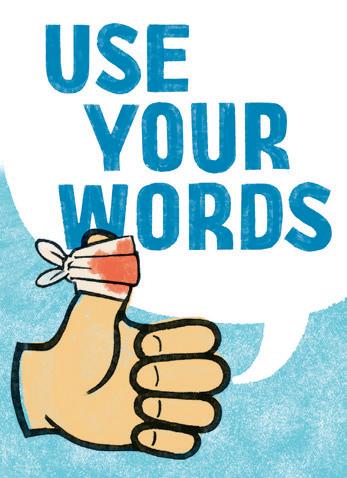
Q : How do I tell my boyfriend nicely that he needs to brush his teeth more o en? He’s very sensitive to this kind of feedback, but I don’t want him to have stinky breath in a work meeting!
A : USE YOUR WORDS! When my breath stinks or I need to take a shower or use some deodorant, I’m grateful when my partner says something to me—because I’m a grown-up. If your partner can’t handle this kind of feedback, you need to ask yourself why you’re wasting
your time on someone who isn’t a grown-up.
Q : I’m a 40-year-old woman. I was sexting with a guy (29) who started sending me nude/sex pics (including face shots) of another woman he had been with, without her consent. He thought it was sexy, but I was repulsed. Teachable moment or trash him?
A : If you ghost him, he’s likely to assume the photos he shared (and the massive consent violation they represent) weren’t the issue or even an issue. He needs to know. So teach, then trash.
Q : How much time do bottoms really douche?
A : “You can douche all of the bottoms some of the time, and some of the bottoms all of the time, but you can’t douche all of the bottoms all of the time.” —Abraham Lincoln
Q : I’m that rare thing: the one-minute woman. How do I delay orgasms?
A : Every time this subject comes up, someone recommends low-dose SSRIs. Ask your doctor if they’re right for you.
Q : At what age would you recommend I point my teenager to your column and your podcast?
A : I think 15-16 is a good age to start reading and listening—but if you really want your teenager to read my column and listen to my podcast, don’t point them toward Savage Love and the Savage Lovecast. Forbid
them from listening and reading!
Q : Will you marry me?
A : I will not—while I am sure you’re lovely, I already have a husband, and a boyfriend in the on-dick circle. (That is a baseball pun just for my older brother. Hey there, Billy!)
Q : I’m on antidepressants and my libido has been ZAPPED! How to brainstorm sexy time when you don’t feel sexy?
A : Talk with your doctor about adjusting your meds— that’s the first step. While you work on finding the right dosage, e.g., the dosage that alleviates your depression without killing your libido, a little going-through-themotions with your partner will keep you in the groove and may even help you catch a groove.
Q : We are moving to a new house next month, and looking forward to making new sex memories. If you were moving to a new place, what would your first sex act be to break in the new place and what room? We can’t decide where to start.
A : For me it would be a tossup between the conservatory with the candlestick and the library with the lead pipe.
Q : Parenting young children during the pandemic has not resulted in much sexy time in my marriage. How do we get the sexy back? So far exercise and time apart seems to be helping. Any other ideas?
A : Exercise and time apart will definitely help. One additional suggestion: time together in a place (a bar, a club, a party) where people routinely flirt with strangers. The point isn’t to go home with someone else or to take someone home together, but
to see your spouse through other people’s eyes. Seeing someone who wants to fuck your spouse will remind you of all the reasons why you wanted to fuck your spouse.
Q : Fun things to do with balls? Sucking ’em, caressing ’em . . . what else is there? I worry my testicular game is getting stale.
A : Pressure—gentle to start—can feel great, so add squeezing and tugging to your game. (Tugging does not mean yanking! Yanking is not recommended!)
Q : Husband recently discovered he likes to be punched in the balls. How to do it safely?
A : Punching and kicking— more fun things to do with balls. But when it comes to balls and impact play, a little impact goes a long way. Balls can and do rupture, and the risk of doing real harm can’t be eliminated. So, you’ll wanna pull those punches, and make those kicks more symbolic than they are forceful.
Q : The most important thing to remember when you’re starting a new relationship?
A : New relationships rarely “work out,” in the togetherfor-the-rest-of-your-lives sense of “working out.” And while LTRs are great, and while LTRs are what most people are looking for (but not all people), STRs (shortterm relationships) are what we usually get. We’re likelier to feel good about them, we’re likelier to look back at them and regard them as great, if we don’t think of them as failed LTRs but as successful STRs. v
Send letters to mail@ savagelove.net. Download the Savage Lovecast at savagelovecast.com.
@fakedansavage
52 CHICAGO READER - MAY 26, 2022 ll
SAVAGE LOVE
JOE NEWTON
JOBS
Northwestern Memorial Healthcare seeks Medical Laboratory Scientists for Chicago, IL. Bachelor’s in Medical Tech/Lab Science/Clinical Lab Science/Chemistry/Biology/ Allied Health qualifying applicant for ASCP certification exam req’d. General MLS or MT ASCP or Categorical H ASCP Certification required. Drug & background check req’d. Apply online: http:// jobseeker.nm.org/ Requisition ID: REF32571A
Architectural Drafter: Draft & be able to design residential & commercial projects. Plan & design structures such as residences, commercial bldgs or other public & private properties in accordance w/environmental, safety or other regs. Prep scaled drawings or architectural designs using comp-aided design (AutoCAD), Revit, Photoshop, Microsoft Office tools & 3D rendering software. Send resume to: Gansari & Associates LLC, 4753 N. Broadway St., Ste. 918, Chicago, IL 60640, Attn: Cristian Gansari
Groupon, Inc. is seeking a Senior Data Engineer in Chicago, IL w/ the following responsibilities: Oversee the design, development, & implementation of the enterprise data warehouse, enabling effective decision making by retrieving & aggregating data from multiple data sources. 5% - 10% travel required. Apply at www.grouponcareers.com by searching keyword R26721
Arcus Technologies, Inc. dba Kat Tech Systems, Inc. in Arlington Heights, IL is seek’g (A) Data Analysts to dvlp & create ETL jobs for Data Import process w/in healthcare industry; (B) Software Developers (Genesys) to dsgn, & dvlp SW apps; (C) Software Developers (Java) to dsgn & dvlp Java/J2EE SW apps; (D) Software Developers (ServiceNow) to dsgn & dvlp ServiceNow SW solut’ns; (E) Software Engineers to dsgn, & dvlp SW apps. (F) Senior Software Developers (Genesys) to dsgn & dvlp SW apps. No trvl; no telecom. Job duties projbased @ unanticipated sites w/in U.S. Relo may be req’d @ proj end. Mail resume to: Arcus dba Kat Tech Systems, Inc., Attn: HR, 855 E. Golf Rd., Ste. 1126, Arlington Heights, IL 60005
Autumn8, Inc. seeks a Technical Product Manager in Skokie, IL. Email resume to vanya@ autumn8.ai
Loyola University Chicago is seeking an Assistant Professor in Chicago, IL to teach assigned courses in Sociology & Women Studies & Gender Studies in accordance w/ the course syllabi. Please send resume to rwilliams7@luc. edu & ref job 060886.
Gelber Group, LLC seeks a Financial Engineer in Chicago, IL (various unanticipated worksites), responsible for all phases of financial software development incl. back-end services, front-end user experiences, testing, maintenance & support. Telecommuting position, headquartered in Chicago IL but permitted to work from home at various unanticipated worksite locations throughout U.S. Reqs. Bachelor’s degree or foreign equiv in Financial Engineering, Software Engineering or rel. field & 2 yrs post-baccalaureate exp. as Financial Engineer, Software Engineer or rel. role. Exp. must incl. developing & implementing banking & financial industry software, building applications & platforms & reviewing code written by software engineers, financial engineers, quantitative analysts & traders using VBA, Visual/R Studio, SQL Server Management Studio, SVN & Symphony. E-mail resume: recruiting @gelbergroup.com.
Commonwealth Edison seeks Senior Manager, Distribution Standards in Oakbrook Terrace, IL to manage engineering standards group personnel and activities, including utility distribution construction standards, material specifications, asset failure mode analysis, and health and maintenance planning. Requires bachelor’s in engineering discipline, business administration, or related, U.S. or foreign, plus 10 years’ progressive energy industry experience with engineering standards, codes, committees, and practices, including 5 years managing energy industry regulatory requirements. Reply by mail w/CV to: Attn: Diane Bergmaier, Commonwealth Edison, 300 Exelon Way, Kennett Square, PA 19348.
Dakota Systems (Chicago, IL) seeks Sr Systems Analyst to work w/ internal project & tech. teams to define & develop content mgmt system initiatives related to Dakota Content Platform (DCP). Option to work remotely. Send resumes at brian. buehling@daksys.com, Job ID: Senior Systems Analyst in the subject line
Hill-Rom Manufacturing, Inc., a Baxter company, is seeking a Senior Quality Engineer in Deerfield, IL to be responsible to identify and mitigate risks and opportunities that drive compliance profile and performance of the Service Organization to world class levels. Conduct audits and monitor performance of the Service Organization to ensure compliance with the organization’s Quality System and all relevant local, national, and international regulatory requirements. 100% telecommuting from home allowed from anywhere in the U.S. 20% domestic and international travel required. Qualified applicants can apply directly to the Baxter Website at: www.Baxter.com. Please search “Keyword” using job: JR - 069063. EOE
XIT Solutions Inc. seeks Senior Software Developers with Mast or for deg equiv in CS, CIS, Comp Applic, IT or Eng & 2 yrs exp in job offer or IT fld. Must have exp with HTML, JavaScript, Angular, CSS, JSON, Node, Oracle SQL, Java, MongoDB, prod migr & release mngmt, & design wireframes, proc flows & des UI guidelines. Trvl to var unanticip clnt sites reqd. May reside anywhere in the US. Telecom permitted. Apply to HR, 18W140 Butterfield Road, Suite 1500, Oakbrook Terrace, IL 60181
Jr Principal- Data Eng w/ MCKINSEY & COMPANY, INC. US (Chicago, IL). Partner w/ clients to understand their needs & build impactful analytics solutions. Design & build data pipelines to support data science projects following s/w eng best practices. Use state of the art technologies to acquire, ingest & transform big datasets. Take ownership & accountability for the delivery of technical work streams. Mentor & guide more jr colleagues. Map data fields to hypothesis, curate, wrangle & prepare data to be used in advanced analytics models. Create & manage data environments in the cloud or on premise. Min Master’s in Comp Eng, Comp Sci, or rel field, or foreign degree equiv & 3 yrs of exp building data ingestion pipelines. Exp must incl working w/: Python, PySpark, SQL, Airflow, Databricks, Kedro; Cloud solutions: AWS, GCP AWS: S3, Redshift, Spark, Kinesis, Lambda; Databases: MySQL, PostgreSQL, Netezza. Email your resume to CO@mckinsey.com & refer to Job # 5628523 No phone calls please. An EOE
Trading Technologies International, Inc. seeks Sr. Developers for Chicago, IL to design & dev strategies for enterprise databases & solutions. Bachelor’s in Comp Sci/ Comp Eng/Mgmt Info Systems/related field +2yrs exp req’d. Req’d Skills: exp w/relational databases, ETL, data integration, performing front-&-back-end ERP; SQL; MySQL; performance optimization, data warehousing, cloud architecture; data visualization (Domo), REST APIs, JSON, Python; Machine Learning. 80% telecommuting permitted. Send resume to: https://www. tradingtechnologies.com/ about-us/careers/ REF: ARP
TransUnion, LLC seeks Lead Engineers for various & unanticipated worksites throughout the US (HQ: Chicago, IL) to dev eng design, support business & operational req’s for new & existing sys. Master’s in Comp Sci/Comp Eng/ related field +2yrs exp or Bachelor’s in Comp Sci/ Comp Eng/related field +5yrs exp req’d. Req’d Skills: Websphere, Java/ J2EE, JBoss, Apache, Tomcat, IBM HTTP Server, Siteminder, shell scripting, Jython, Linux, SAML Server. 100% telecommuting permitted. Send resume to: A. Goodpasture, REF: KV, 555 W Adams St, Chicago, IL 60661.
Looking for a position that allows flexibility in your schedule with the ability to help others? Home assistance – Provide light housekeeping, run errands or provide transportation if needed. Accompany my Mother to appointments and assist with medications. I am looking for a caring & compassionate person to Care for my Mother. Work Schedule is 5 days a week and 5 hours per day. Salary is $25/hr. Forward your email to William (yolielloyq@gmail. com) for more details.
NPV Staffing, LLC (Chicago, IL) seeks Sr. Data Modeler. Design strategies for enterprise database systems & set standards for operations, programming, data loading & security. MS in Comp Engg, Comp Sci or rel/equiv. 6 mths as Data Modeler, Data Architect, DBA, Project Engr or rel. 6 mths exp w/ HTML, JSP, SQL and PLSQL req. Travel or relocation to various unanticipated worksites throughout US req. Send resumes: hr@ npvstaffing.com
USG Corporation is seeking a Director, Commercial Excellence in Chicago, IL with the following requirements: Master’s degree in Business Administration or related field or foreign equivalent degree. 6 years of related experience INCLUDING 3 years of experience in the industrial manufacturing industry in a corporate strategy and/or business operations role; AND 3 years of experience in management consulting, including one year of experience in a manager role. Required Skills: Design and implement management strategies by applying competitive cost analysis, customer segmentation, capabilities assessment, and supply chain analysis (3 yrs); Evaluate and design processes to support management in different functional areas (such as finance, manufacturing, distribution and sales), including expertise in process mapping, M&A due diligence, cross-functional team management (3 yrs); Design and drive the commercial excellence agenda in collaboration with business unit and functional leaders, including pricing, go-tomarket, salesforce organization and incentives, and CRM implementation (3 yrs); Perform data analysis and design scenario modeling to estimate financial impact, using computer tools such as Oracle BI, Tableau, and Angoss (3 yrs). Telecommuting allowed; must live within normal commuting distance of Chicago, IL. Company headquarters in Chicago, IL. Please visit www.usg.com/ careers to view the entire job description and apply.
Sr. Consultant, Data Eng position w/ MCKINSEY & COMPANY, INC. US (Chicago, IL). Write production code optimized to clients’ environment. Perform research to select modeling approaches & other data science methodologies. Structure analytics work stream for complex engagements, assigning tasks to jr colleagues & coordinating w/ other specialized teams. Present technical data science results to a wide range of client & internal stakeholders. Guide jr colleagues in data & model assessment, exploratory analyses & code review. Lead overall model validation approach across the engagement & identify opps to contribute to internal data science s/w assets. Lead an effective code review process across larger Data Science teams. Min Master’s in Info Tech & Mgmt, Comp
Sci, or rel quant field, or foreign degree equiv & 2 yrs of exp in a data-driven role using big data technologies. Exp must incl: conducting data analysis & applying data science methods to biz problems; using data integration (data warehouse) tools; machine learning; working in 1 of the following cloud environments: AWS, Azure, or Google Cloud; using the following machine learning s/w packages: scikit-learn, xgboost, & statsmodels. Academic or professional exp performing stats modeling & using the following programming languages: Python, R, Spark & Scala. Domestic & int’l travel typically required. Destination & frequency impossible to predict. Email your resume to CO@mckinsey.com & refer to Job # 5954336 No phone calls please. An EOE
RENTALS
Off-street parking spot available - Rogers Park. Easy access, near Loyola, North Shore and Sheridan. $100 a month. June 1st. 872.223.2118. grrd737@gmail.com.
MARKETPLACE
Artists moving/estate sale, lots of cool items, art/photography supplies, frames, books, furniture, games, clothes, shoes, housewares, come buy the fun. Sunday 5.29.22, 8am-4pm, 1412 N Kedzie
JACKSON PARK HIGHLANDS COMMUNITY GARAGE SALE - South Shore, Chicago, IL June 4, 2022 10 AM - 4 PM Come one, come all. Find some great bargains. One day only. 6700-7000 blocks of Euclid, Bennett, Constance and Cregier.
RESEARCH
Have you had an unwanted sexual experience since age 18? Did you tell someone in your life about it who is also willing to participate?
Women ages 18+ who have someone else in their life they told about their experience also willing to participate will be paid to complete a confidential online research survey for the Women’s Dyadic Support Study. Contact Dr. Sarah Ullman of the University of Illinois at Chicago, Criminology, Law, & Justice Department at ForWomen@uic.edu, 312-996-5508. Protocol #2021-0019.
LEGAL NOTICE
NOTICE OF PUBLIC SALE OF PERSONAL PROPERTY
Notice is hereby given that pursuant to Section 4 of the Self-Storage Facility Act, State of Illinois, that Chicago Northside Storage - Lakeview / Western Ave Storage LLC will conduct sale(s) at www.storagetreasures. com by competitive bidding starting on June 15th and end on June 22nd @ 10:00am on the premises where property has been stored, which are located at Chicago Northside Storage 2946 N Western Ave. Chicago, IL 60618. 773-305-4000.
In the matter of the personal property for the individual listed below, Chicago Northside Storage - Lakeview. John Frankot CC100, Termaine Jodie Jones Q20. Purchases must be made with cash only and paid at the time of sale’s redemption. All goods are sold as is and must be removed at the time of purchase. Sale is subjected to adjournment.
PROFESSIONALS & SERVICES
CLEANING SERVICES
CHESTNUT ORGANIZING AND CLEANING SERVICES: especially for people who need an organizing service because of depression, elderly, physical or mental challenges or other causes for your home’s clutter, disorganization, dysfunction, etc. We can organize for the downsizing of your current possessions to more easily move into a smaller home. With your help, we can help to organize your move. We can organize and clean for the deceased in lieu of having the bereaved needing to do the preparation to sell or rent the deceased’s home. We are absolutely not judgmental; we’ve seen and done “worse” than your job assignment. With your help, can we please help you? Chestnut Cleaning Service: 312-332-5575. www. ChestnutCleaning.com
ADULT SERVICES
Danielle’s Lip Service, Erotic Phone Chat. 24/7. Must be 21+. Credit/ Debit Cards Accepted. All Fetishes and Fantasies Are Welcomed. Personal, Private and Discrete. 773-935-4995
MAY 26, 2022 - CHICAGO READER 53
CLASSIFIEDS JOBS ADMINISTRATIVE SALES & MARKETING GENERAL REAL ESTATE RENTALS FOR SALE NON-RESIDENTIAL PROFESSIONALS & SERVICES CLEANING RESEARCH ADULT SERVICES WANT TO ADD A LISTING TO OUR CLASSIFIEDS? Email details to classified-ads@chicagoreader.com



















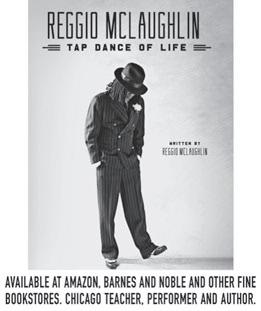





















54 CHICAGO READER - MAY 26, 2022 ll Outside Noise Reduction Keeps Bugs & Spiders Out Reduce or Eliminate Fog & Water Noise from Outside? Visit stormsnaps.com or noisewindows.com sales@stormsnaps.com Alpina Manufacturing, Chicago, IL 1-800-915-2828 Soundproofing Window Inserts the platform The Chicago Reader Guide to Business and Professional Services To advertise, email ads@chicagoreader.com home improvement legal books Fun, Clean, Picture Frame assembly JOB $18/hour Tired or bored of clicking away on a keyboard working at home? Keep your hands and mind busy with a fun, safe, clean assembly job. You’d have your own large assembly zone, at least 15-20 feet away from others, so we’re really safe here. Top rated rm Alpina Manufacturing LLC founded in 1992 Beautiful campus in Galewood, near Mars candy, 3 blocks north of Oak Park. We build and sell display framing systems to customers nationwide including Wal-Mart, Verizon, Circle K gas stations, Hospitals. Full time, Part time, Flex hours for working parents or students. We train, no travel, work in Galewood. Open to any backgrounds. Excellent pay, friendly caring management. Stop in anytime between 7am and 4pm M-F ask for Izzy to apply and check us out. Alpina Manufacturing 6460 W Cortland St., Chicago, IL 60707 business consulting entertainment Brigi e Schmidt Bell, P.C. 847-733-0933 lawyers@bsbpc.com Brigi eBell.com Brigi eSchmidtBellPC Considering Divorce? We Can Help. Collaborative | Prenuptual Divorce | Mediation insurance services health and wellness YOUR AD HERE dance JOIN US! WWW GECHAMBER COM What Greta said . . . shop local 5301N.ClarkSt.Fl.2 CHICAGODANCESUPPLY.COM 773-728-5344 A Matter of Consequences by Michael W. Falls Available on Amazon and Booklocker A Classic Chicago Mystery Customized Massage Therapy, Intuitive Energy Work, and Holistic Talk Therapy 2514 W Armitage Ave, Suite 211 Chicago, IL 60647 773-697-9278 www.intuithealing.com Open Thursday-Monday BY APPOINTMENT ONLY your heading here



































































MAY 26, 2022 - CHICAGO READER 55 6/ 17 @ Schubas Hollyy + The Evening Attraction w/ Michael Damani Come Over to Squirt.org and Join the Action. Hosting. We’re 10 DAYS FREE FUN FOR EVERY NEW GUY the cannabis platform a Reader resource for the canna curious www.neuromedici.com 312-772-2313 Findouttoday ifmedical cannabisorinfusiontherapyis rightforyou.Telemedavailable! Yourpartnersinhealthandwellness. Serving medical cannabis patients since 2015. To advertise, email ads@chicagoreader.com CBD / cannabis recipes, psychedelic drawings to color, word puzzles to stimulate your brain, growing tips, and more! chicagoreader.com/420book The Budrista platform is a cannabis industry and lifestyle project. Its purpose is to support the healthy and balanced lifestyle of cannabis industry workers. Budrista functions through various outlets such as educational programming and recreational events. By signing up, you’ll have first access to our events and programming!
Dream Big, Go Local Find
Future



At City Colleges of Chicago, an affordable college education isn’t miles away—it’s down the street.
Save thousands on your college journey by taking classes at the campus in your community or from the comfort of your own home.
With in-demand programs, expert faculty, and supportive resources, our seven colleges can help you map out your future.


Find your college, and your future, today:

ccc.edu/apply
Your
CITY COLLEGES OF CHICAGO SOUTHWEST SIDE SOUTH SIDE WEST SIDE SOUTHEAST SIDE NORTH SIDE THE LOOP NORTHWEST SIDE
Daley College Kennedy-King College Malcolm X College Olive-Harvey College Truman College Harold CollegeWashington Wright College Online













 By ISA GIALLORENZO
By ISA GIALLORENZO




























































































































 COURTESY THE ARTIST
COURTESY THE ARTIST



















































































































































 PAUL NATKIN
PAUL NATKIN


































































































